Introduction – Project – 2

Cast of the movie
Frank Finlay as Marley’s ghost
- George C. Scott – Ebenezer Scrooge
- Mark Strickson – Young Ebenezer Scrooge
- Frank Finlay – Marley’s Ghost
- Angela Pleasence – Spirit of Christmas Past
- Edward Woodward – Spirit of Christmas Present
- Michael Carter – Spirit of Christmas Yet to Come
- David Warner – Bob Cratchit
- Susannah York – Mrs. Cratchit
- Anthony Walters – Tiny Tim Cratchit
- Louise Gasser – Martha Cratchit, daughter
- Orlando Wells – little boy Cratchit
- Nancy Dodds – little girl Cratchit
- Sasha Wells (Susannah York’s real daughter) – Belinda Cratchit, daughter
- Kieron Hughes – Peter Cratchit, son
- Roger Rees – Fred Hollywell/Narrator
- Caroline Langrishe – Janet Hollywell, Fred’s wife
- Lucy Gutteridge – Belle, Scrooge’s fiancée
- Nigel Davenport – Silas Scrooge, Ebenezer and Fan’s father
- Joanne Whalley – Fan Hollywell née Scrooge, Ebenezer’s sister and Fred’s mother
- Timothy Bateson – Mr. Fezziwig
- Michael Gough – Mr. Poole
- John Quarmby – Mr. Hacking
- Peter Woodthorpe – Old Joe
- Liz Smith – Mrs. Dilber
- John Sharp – Tipton
- Derek Francis – Pemberton
- Danny Davies – Forbush
- Brian Pettifer – Ben
- Catherine Hall – Meg
- Cathryn Harrison – Kate
What is A Christmas Carol
A Christmas Carol. In Prose. Being a Ghost Story of Christmas, commonly known as A Christmas Carol, is a novella by Charles Dickens, first published in London by Chapman & Hall in 1843 and illustrated by John Leech. A Christmas Carol recounts the story of Ebenezer Scrooge, an elderly miser who is visited by the ghost of his former business partner Jacob Marley and the spirits of Christmas Past, Present and Yet to Come. After their visits, Scrooge is transformed into a kinder, gentler man.
In A Christmas Carol, Fan is Ebeneezer Scrooge’s sister. Dickens introduces Fan in the second stave of the story when the Ghost of Christmas Past takes Scrooge to revisit his childhood. In this scene, Fan comes to collect the young Scrooge from boarding school. Fan is evidently a loving and caring person, as shown by the fact that she begged her father to have Scrooge home for Christmas:
I was not afraid to ask him once more if you might come home; and he said Yes, you should; and sent me in a coach to bring you.
Moreover, the ghost shares this positive view of Fan’s character:
“Always a delicate creature, whom a breath might have withered,” said the Ghost. “But she had a large heart!”
It is also in this stave that we learn Fan died as a young woman, sometime after the birth of Fred, her only child (and Scrooge’s nephew). Fred has clearly inherited many of his mother’s character attributes, as shown by his desire to spend Christmas with his uncle, despite Scrooge’s miserable character.
Who is Fan in A Christmas Carol by Charles Dickens? – eNotes.com
Proposal
I am given the Characters of Fan and Mrs. Crotchit to create makeup and hair/Wigs looks on the models to perform in house drama.
The Character ‘Fan Hollywell’ was a beautiful young Victorian time woman with curly long hair and belonged to a rich family. She was a sister of Scrooge, who cared and loved him very much, and pleads her father to let him come back home, as Scrooge is in boarding school, his father does not take him home due to the reason that Scrooge and Fan’s mother (his wife, who he loved very much) died at the birth time of Scrooge, and his father holds him responsible for her death. Fan dies in past and has left a son called Fred Hollywell in this world, who has resemblances of his mother.
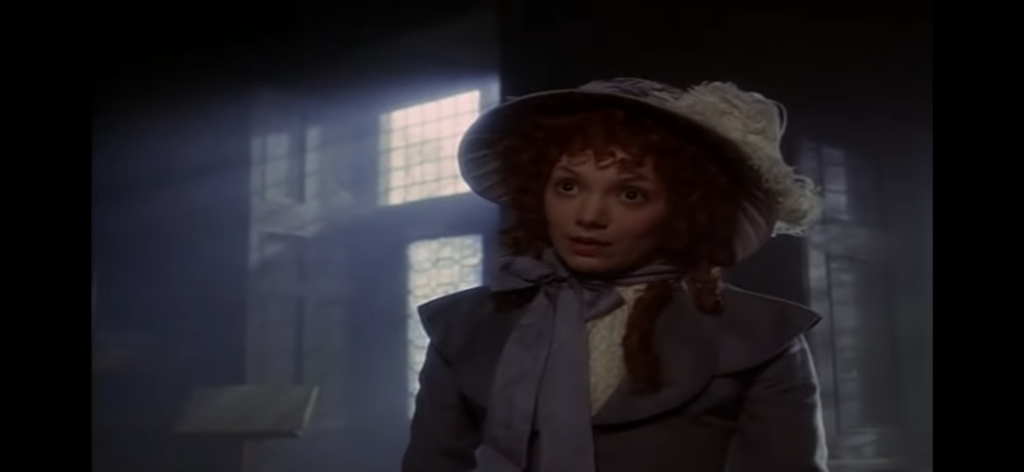
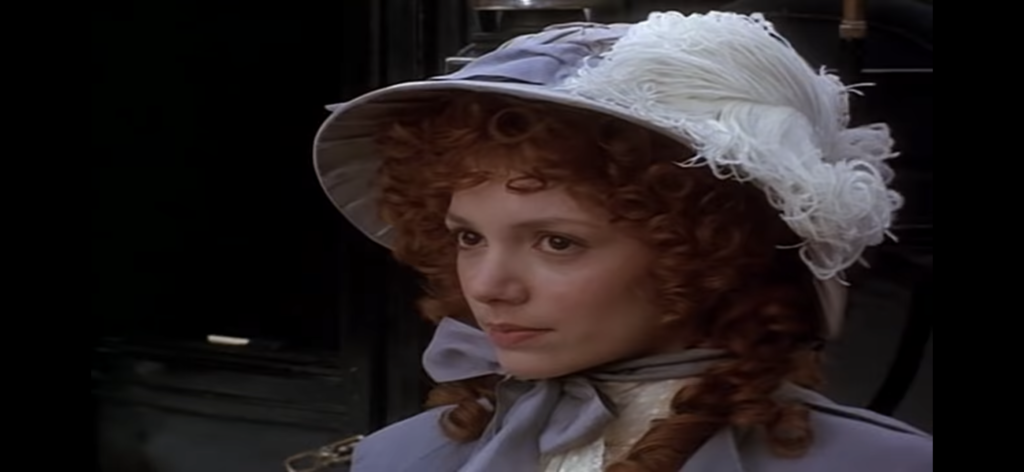
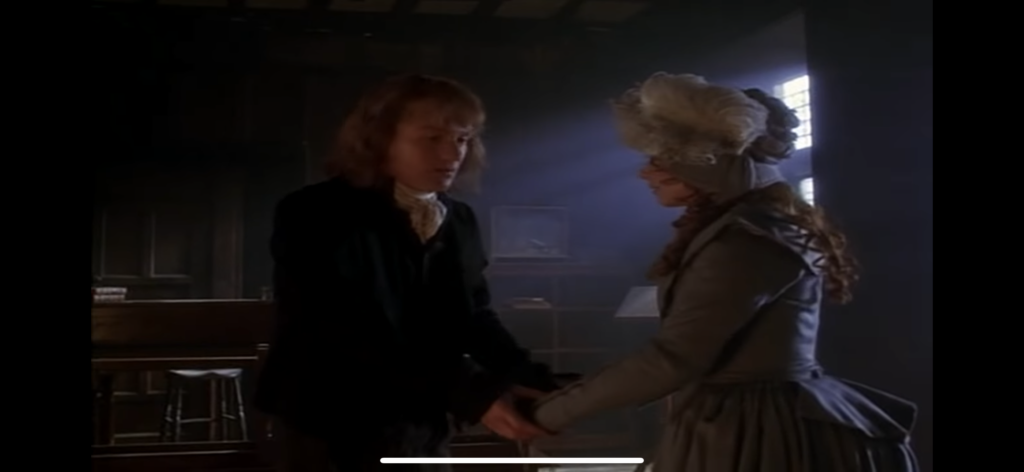
Fan
Roll of Fan was played by Joanne Whalley (born 25 August 1961[1]) is an English actress who began her career in 1974. She has appeared primarily on television, but also in nearly 30 feature films, including Dance with a Stranger (1985), Willow (1988), Scandal (1989), Storyville (1992) The Secret Rapture (1993) Scarlett (1994) and Mother’s Boys (1994). Following her marriage to Val Kilmer in 1988, she was credited as Joanne Whalley-Kilmer until their divorce in 1996.
Whalley was nominated for the BAFTA TV Award for Best Actress for the 1985 BBC serial Edge of Darkness, and was nominated for a Best Actress Golden Nymph Award at the Monte-Carlo Television Festival for the 2011 series The Borgias. Her other television roles include the 1986 BBC serial The Singing Detective; playing the title role in the 2000 CBS TV film Jackie Bouvier Kennedy Onassis, Claudia, wife of Pontius Pilate in the 2015 NBC series A.D. The Bible Continues, and Sister Maggie in Daredevil.
who is fan in a christmas carol movie made in 1984 – Search (bing.com)
Second Character is Mrs Cratchit
Emily Cratchit is a minor character from the novel A Christmas Carol by Charles Dickens. She is Bob Cratchit ‘s wife and the mother of Peter and Tiny Tim Cratchit. She does not think highly of Ebenezer Scrooge and is frankly vocal about her opinion.
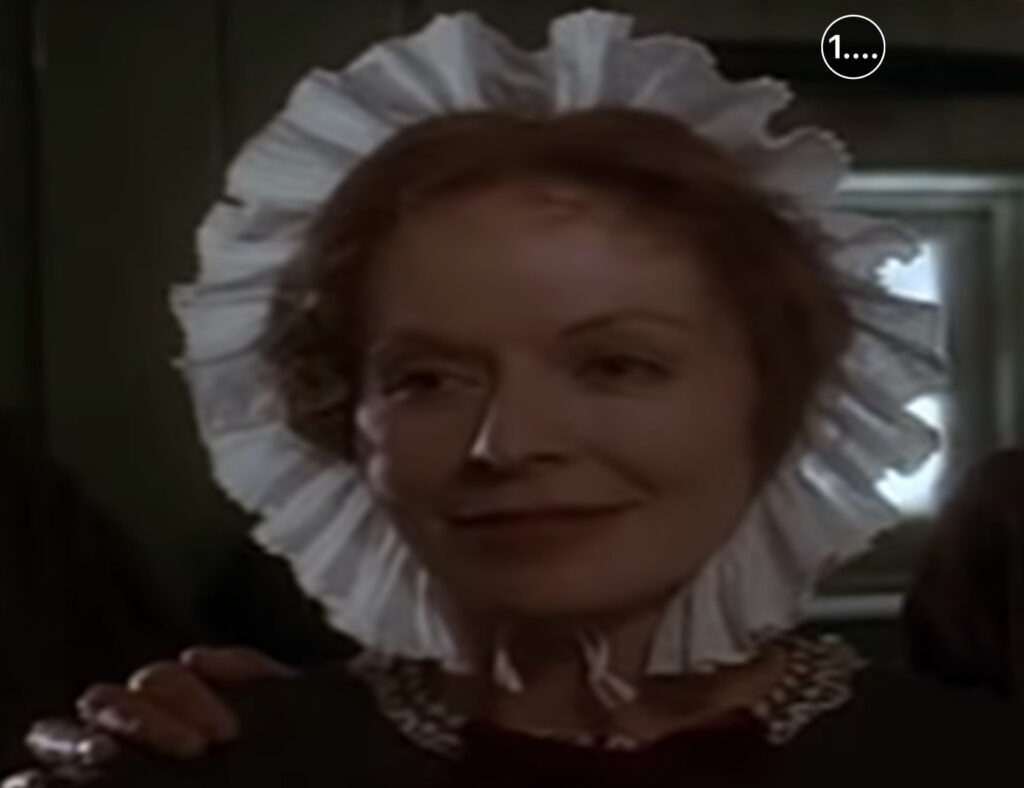

Who Is Mrs. Cratchit?
In A Christmas Carol by Charles Dickens, we first meet Mrs. Cratchit in the part of the story where Scrooge is traveling with the Ghost of Christmas Present. We read that she is ‘dressed out but poorly in a twice-turned gown,’ which means she’s wearing a dress that has been made over twice, indicating she isn’t able to buy new clothes. However, we read on to see that, despite this problem, she is ‘brave in ribbons, which are cheap and make a goodly show for sixpence.’ She doesn’t have money for a new dress, but she is making the best of things by using ribbons instead because they are cheap.
Mrs. Cratchit’s Optimism
We begin to understand that Mrs. Cratchit is used to having scanty means when she shows ‘great delight’ at the fact that there is ‘one small atom of bone’ remaining of their Christmas goose at the end of their feast. Mrs. Cratchit rejoices that ‘they hadn’t et it all at last! Yet everyone had had enough.’ This shows us that not only can the Cratchits not afford new clothes, but a full meal where everyone has enough to eat is also a rare thing. Mrs. Cratchit shows striking optimism when she is able to be delighted at the simple achievement of a family with full stomachs.
Mrs. Cratchit in A Christmas Carol – Video & Lesson Transcript | Study.com
General Research
When did the Christmas tradition begin?
The history of carol singing may go back as far as the medieval era, and has appeared in literature for many years, but it was during Victorian times it became really popular
The tradition of going from house to house carol singing has an uncertain heritage, but may have its origins in medieval times, when watches – which included musicians – patrolled England’s towns to keep order. Lincoln, for example, had a group of waits until around 1850.
However carol singing really came into its own in Victorian times, with the advent of the Victorian Christmas. This was when Christmas became a holiday families could enjoy, and celebrate, and music in the home was a big of the celebrations. It would become tradition to sing carols after the Christmas meal.
The first carol service is believed to have been held at Truro Cathedral, Cornwall, in 1880. It was organised by Edward White Benson, the First Bishop of Truro, who later became the Archbishop of Canterbury.
A separate tradition of ‘wassailing’ also existed as far back as Anglo-Saxon times. The word ‘wassail’ probably comes from the Old Norse ‘ves heill’ meaning ‘be well and in good health’ and was a toast. But by the Victorian period wassailers were carolling groups who went round the town and would be rewarded with a hot, spiced (often cider-based) drink, known as ‘wassail’.
Today, carol singers can more usually be found in town squares, shopping centres and visiting hospitals and old people’s homes – and rather than waiting to be rewarded with a cup of wassail, modern carollers are more likely to ask for donations to charity. That said, a glass of mulled wine is often very welcome!
Carol singing: when did the Christmas tradition begin? | Classical Music (classical-music.com)
The History of Christmas Carols – WhyChristmas.com
The ultimate Christmas carols list
- 1. Deck the Halls This jolly carol is extremely well-known, whether it be sung traditionally in a service or recreated by popular musicians. …
- 2. Joy to the World …
- 3. Carol of the Bells …
- 4. In the Bleak Midwinter …
- 5. We Three Kings of Orient Are …
The ultimate Christmas carols list | Leisure | Yours

www.yours.co.uk/leisure/nostalgia/christmas-carols-list/
The Victorian Period in Fashion: Historical Background
The Victorian period, generally the time between 1837 and the 1890s, is named after Britain’s Queen Victoria (1819–1901), a long-lived and highly influential monarch in an era when women had little power or opportunity.
In those days, women lived at the largess of men—first their fathers or guardians, then their husbands. A young lady was expected to be meek and mild, to acquiesce to her father’s or husband’s wishes. A woman’s intelligence and wit were restricted to social events and amusing conversation.
Jobs for Women
Employment opportunities were limited to teaching young girls, being a governess, domestic servitude, and later factory or mill work. Of course, rural women had plenty of work if they lived on a farm. Some women earned money from cottage industries, but the Industrial Revolution put an end to enterprises such as spinning yarn and making lace at home.
The Industrial Revolution
The Industrial Revolution created new wealth for investors, industrialists, and merchants. It introduced a new middle class who, proud of their status, displayed their wealth with great ostentation. Women wore their status in fabric, and lots of it—from the mid-century hoop skirts to the bustle later on in the beautiful dresses and styles of the Victorian period. The Industrial Revolution created a new urbanization as towns and cities filled with workers for the new mills and factories where women worked long hours in grim, dirty, and often dangerous conditions.
Early Victorian Fashion
1836 ushered in a new change from the Romantic style of dress. Large Gignot sleeves suddenly slimmed and a seam line dropped the shoulder of dresses. A tight-fitting bodice was boned and slanted to emphasize the waist. Cartridge pleats at the waist created volume in the skirt without adding bulk to the waist. Women of a higher social class were expected to be demure and indolent as reflected by the restrictive dropped shoulder lines and corsets.
- Dresses in soft colors could be refreshed with detachable white collars and cuffs.
- In the 1840s, extra flounces were added to skirts and women wore a short over-skirt in day dressing. Skirts widened as the hourglass silhouette became the popular look, and women took to wearing layers of petticoats. Bodices took on a V shape and the shoulder dropped more.
- Evening wear exposed the shoulders and neckline, and corsets lost their shoulder straps. Sleeves of ball gowns were usually short.
- Although women wore what we call “dresses,” many of these costumes were actually a separate bodice and skirt.
- Three-quarter length sleeves lasted through most of the Victorian period and some sleeves began to sprout bell-shaped ruffles.
- For most of the 19th century, bonnets were the headgear of choice. Styles varied from plain to heavily ornamented.
The Complete History Of Victorian Era Makeup
All the Victorian era sources, be it newspapers or magazines, had a repetitive echo about how a lady should be cautious about her countenance and her attire; and this caution was concerned with finding a suitable husband. While there were talks and advertisements about beauty for men also, women too took pride in their own skincare and beauty. Victorian makeup was certainly one significant way to enhance their beauty.
1. Victorian Era Makeup History: The Ideal Type
The Victorian era’s ideal beauty was a pale face, big dark eyes, and rosy cheeks. Blemishes, pimples, and freckles were absolutely unsightly – but to apply is makeup is a matter full of conjectures and controversies.
2. Victorian Era Makeup History: The First
Pharmacists and apothecaries created the first cosmetics to get rid of pimples, freckles, and blemishes. Eventually, there was an emergence of national brands; they were creating face creams at low-cost. There was frequent addition of directions for preparing home-made creams in ladies’ magazines.
3. Victorian Era Makeup History: Facewash, Scrub, and Advertisement

Some of the basic ingredients were rose, sugar, lavender, lemons, oatmeal, almond, and elderflower. Flowers were soaked in the water to create face wash. Sugar was used as scrubs to clean the opened pores and skin.
Spermaceti (sperm whale oil), almond oil, and white wax were used to create cold creams. Through performers and actresses like Lily Langtry, this industry of beauty products used to endorse their brand. This promotion also reinforced the thought that makeup only belonged to the theater, immoral women, and prostitutes. But in fact, this class of women hardly used makeup.
4. Victorian Era Makeup History: Ready Made Makeup

Mercury, red and white lead, belladonna, and other now-known toxic elements were used to create ready-made makeup. These made the makeup look more durable and richer based on color, but they were immensely unhealthy for the skin. The quality of richer in color drew women to buy these products, usually via mail order or through pharmacists and at times from department stores, where these products were kept concealed until asked for.
5. Victorian Era Makeup History: Face Powder
Face powder is the one acceptable makeup product during the Victorian era. This makeup product was common in the vanities of middle and upper-class women. It was created of lightly colored and scented starch, similar to Victorian soap and talcum powder.

Other ingredients used to create this face powder are French chalk, Venetian talc, rice powder, and powdered milk made of magnesia. Even ground and dried zinc oxide created an extraordinary pure white powder, which did not turn grey when exposed to candles, coal fumes, and gas; Henry Tetlow discovered this combination in 1877.
The pure white powder was used to lighten the complexion. Colour tinted powders were used to cover up the blemishes. Pink tinted powders were there to act as blush. These face powders were easy to make and cheap to buy, used as a medicine, and not face paint.
Applying the cream beneath the powder helped to hold the powder for a long period. This is the modern-day thing with concealer or foundation. Although Victorian makeup did not provide the same coverage of modern-day powder, it certainly helped conceal the skin’s oily skin and pinkish undertone.
6. Victorian Era Makeup History: Eye Makeup
Eyeshadows became common after the late teens. Many women needed to darken their facial hair to look attractive. Charcoal, Indian ink, burnt clove paste, and elderberry juice were used to darken facial hair simply by using fingers. Some of these could be used for the eyelid, which worked as eyeliner, and a slight smear of castor oil at the top of the lid, which attracted light towards eyes even without adding color.

Eyebrows were plucked into the shape of a natural arch. Eyelashes were trimmed sometimes with the help of tiny scissors under the misconception that it will grow fuller.
7. Victorian Era Makeup History: Lip and Cheek
The most controversial makeup and evident ‘paint’ a woman could put on was definitely lip color. Lip color was created by using ground beetles mixed with cocoa butter, animal fat, and wax. It was applied by using the fingers on the lips and cheeks. Beetroot was a natural aid for coloring the cheeks.
Another very subtle technique to apply color on the face was to mix color and water and sink a piece of gauze, let it dry, and when needed, dust the face with that gauze, which is now colored. The result somewhat looked like pinkish – red contrasted over pale skin. Those women who were not confident enough to pull off makeup and colored lip used to dab beeswax or face cream to add a bit of shine on the face.
8. Victorian Era Makeup History: Vanity

A lady’s vanity or dressing space was a gorgeous collection of beauty products, including bottles of perfume, small canisters of products, and combs for the hair. Many women were very private and confidential about their cosmetics; they used re-used prescription bottles and filled them with creams and lotions. Some women went to the extent of buying medicine chests and toilet boxes with concealed compartments.
9. Victorian Era Makeup History: Tools and Boxes

Different boxes hold different cosmetics, beauty products, and ornaments—a jewelry box to hold necklaces, rings, earrings, brooches, and hat pins. A love box was used to hold three or four pairs of gloves. An odor case was used to hold three-four bottles of perfume. A manicure box held different tools to make nails and hands look pretty. There was a toil case to hold hand mirrors, combs, and brushes. These boxes were wonderful inside and outside, designed in velvet or satin, with silver trim surrounding the fine wood case.
Victorian Era Hair Fashion
In the early and mid-Victorian era, it’s fashionable to have dark brown hair, hardly a fashion plate depicts a woman with blond hair.
Women’s hair was generally worn long, caught up in a chignon or bun. In the 1840s, ringlets of curls hung on either side of the head. In the 1870s, women drew up the side hair but let it hang in long, loose curls in the back. Crimping became popular in the early 1870s.
Throughout the Victorian period, women wore false hairpieces and extensions as well as artificial flowers such as velvet pansies and roses, false leaves, and beaded butterflies, often combined into intricate and beautiful headpieces.
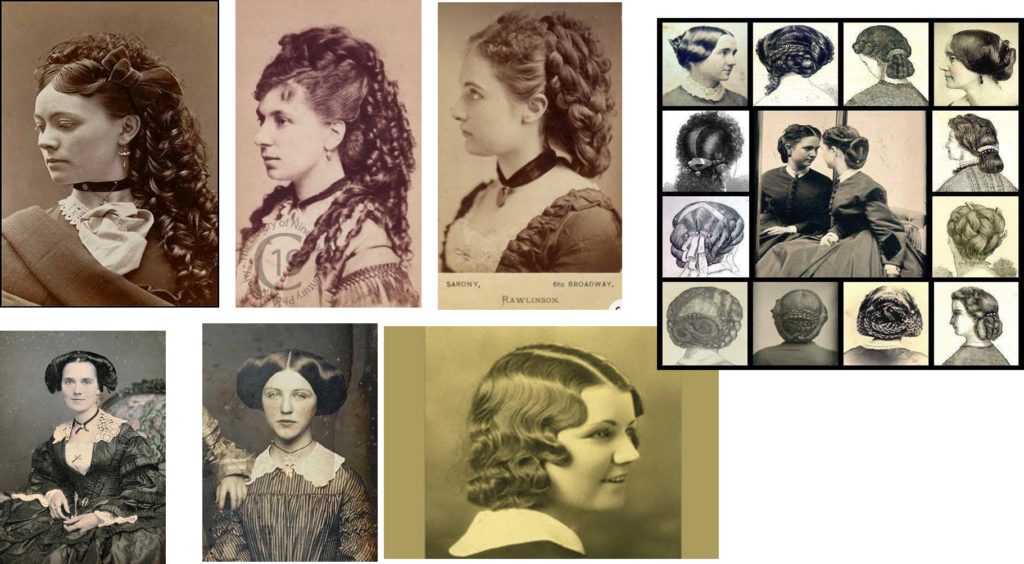
Victorian era hair fashion – Search (bing.com)
The Rich

Victorian England was a man’s world. More specifically, it was a rich, upper-class, man’s world, and even better if you had land, a large house, a title, and a doting wife. Women of this class enjoyed a life full of all the things money could buy; travel, fine clothes, good food and of course, servants and staff to do chores for them.
Their allotted goal in life was to marry, have children and raise them in an appropriate and respectful manner. This in itself was seen to be sufficient fulfillment for an upper class woman and the role of devoted wife and mother was highly idealized in Victorian Britain. The perfect role model for the domesticity expected of upper, and especially middle class women, was that of Victoria herself, who doted upon her husband and children, and after Albert’s death remained loyal, modest and demure – engrossing herself in her regal affairs.
Unlike their lower class counterparts, upper class Victorian women more often than not had staff to help with the running of their home and the raising of their children, leaving them with plenty of time to enjoy the finer things in life. Dancing and grand social parties were commonplace in the lives of wealthy Victorian women, and offered them a chance to mingle with other women of similar backgrounds and to show off their fineries. However, in doing so, the ladies had to remember to adhere to certain unspoken rules of etiquette, lest they come across as vulgar and gain an unsavoury reputation among the other members of the elite. The rules ranged from what kind of jewellery to wear, to where and with whom they were allowed to walk.
Aside from the work (or lack thereof) that upper class Victorian women did, the most interesting and noticeable way to distinguish between rich and poor women was clothing. The images we have today of Victorian women, clad in fine fabrics, grand dresses, bonnets and petticoats, are the clothes of the upper classes. They would be expensive, exotic and made to impress – but also came imbued with many subtle reminders of the upper class woman’s place. It was at this time in the 19th century that women’s clothes in the upper echelons of society came to be more sexualized. Women’s clothing accentuated and exaggerated the hips, breasts and derriere not only to make the wearer seem more attractive, but to separate these wealthy ladies from the world of work. Obviously, it would be beyond impractical to be in a workhouse or cleaning in a heavy and corseted dress, and so in wearing such clothes, the rich were making a subtle but definitive statement: no manual labor for us. Instead, the garments were designed beautifully so that women may resemble and compliment the décor of their lavish home, where they could look after their family and entertain, minus the strains and stresses of working and getting messy.
So, although the upper class life seemed pretty settled, they weren’t as secure as they may have appeared, as many of the middle class women risked slipping into the “upper” sector of the lower class through the death of a father or husband. As was and is often the case in noble families, inheritance would go to the eldest male child or next-of-kin, so many women were often left by the wayside, without money or a home. These women would be employed in jobs that required skills, often ones that had been acquired during their time in the upper and middle classes, such as teachers and governesses. Some even worked in shops or as bookkeepers. They had a comfortable life, not being exactly poor, with steady jobs and no manual labor involved; however it was a far cry from their previous lives of leisure, and an even further cry from the lives of the lowest class of Victorian women; those of the “lower” working class.
THE POOR

t was the “lower” working class that we generally associate with the “other end of the spectrum” that we contrast with the lavish lifestyle of the ladies of leisure. Their food was tasteless and consisted of anything that they could afford, their clothes were vastly different from the luxurious outfits of the upper class women – consisting of rag and cheap cloth, and their homes would be cold, dank and dark. These women were usually single, and relied only upon themselves for support, often working among men of the same class in workhouses. Life in the workhouses was arduous and dangerous, but as long as the women were pronounced as “able bodied” they had to work, not only because of the legal requirement to do so, but to scrape together any money they could.
Another trade which lower class women could turn their hand to was that of domestic service. Although it was not as physically draining as factory work, it had its own difficulties. Catering for the demanding upper class ladies all day and cleaning up after their families seven days a week, for at least twelve hours a day, was in itself a monumental task, especially when if anything were to go wrong in the family it would be the servants who were to get the blame.
One of the less grim work options for women of this class was to turn to prostitution. Prostitution in Victorian Britain was a prevalent and often well earning business, with streets and streets dedicated to its work. Many girls turned to prostitution, viewing it as a means to an end – a way to build up capital so that they may invest in a business or live a more comfortable life. However, many of these young women had their lives cut tragically short by untreated sexually transmitted diseases (STDs), which of course they passed on to a great many of their customers who could also fall victim to the more fatal side of the trade.
The History of the Victorian Era Clothing – Vintage Fashions
Additional Evidence – project 2
Reflections
Week 1
Script and Characters

Week 2
Watched Christmas carols movie and assessed 2 characters.


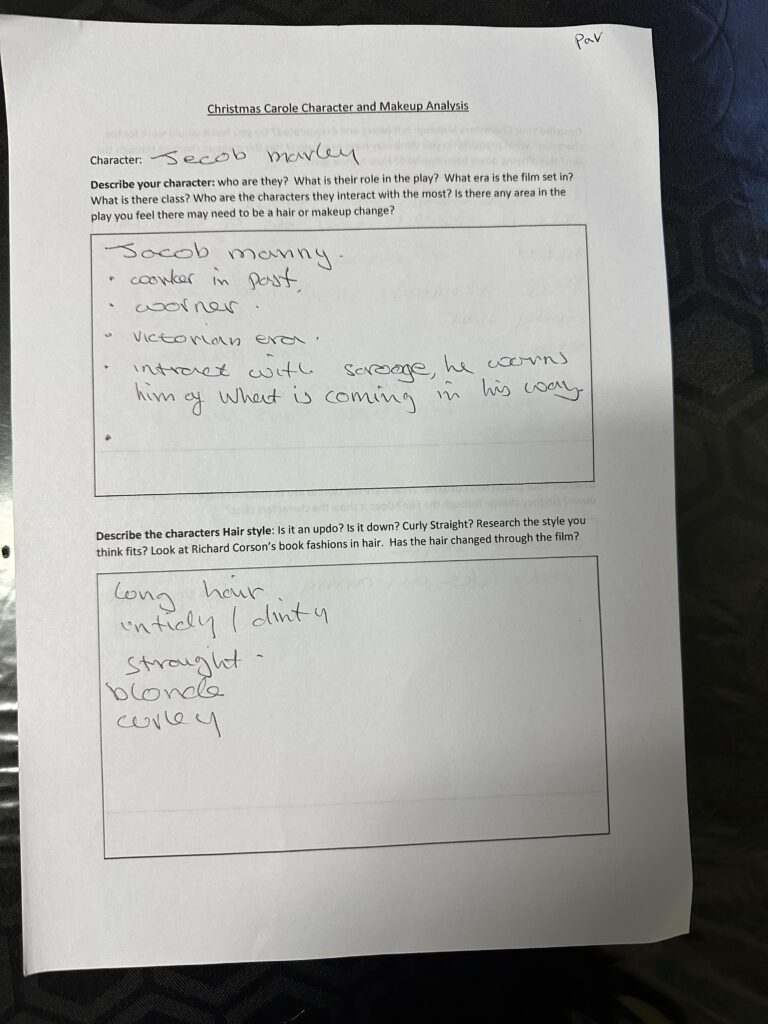
practised hair rap techniques
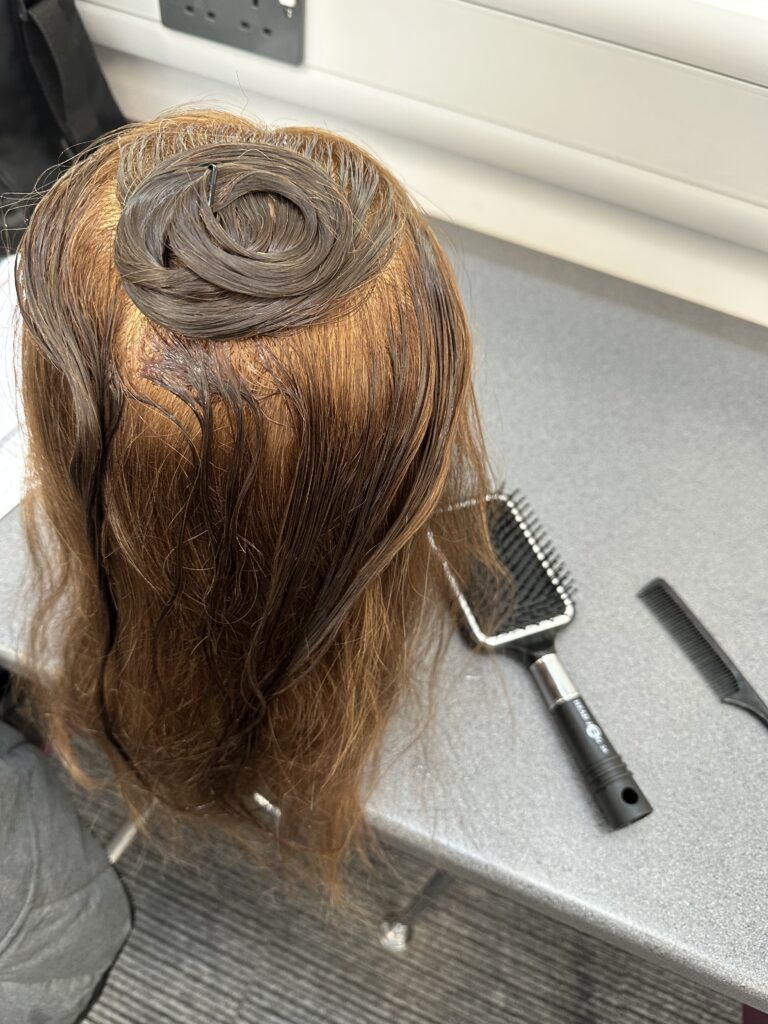

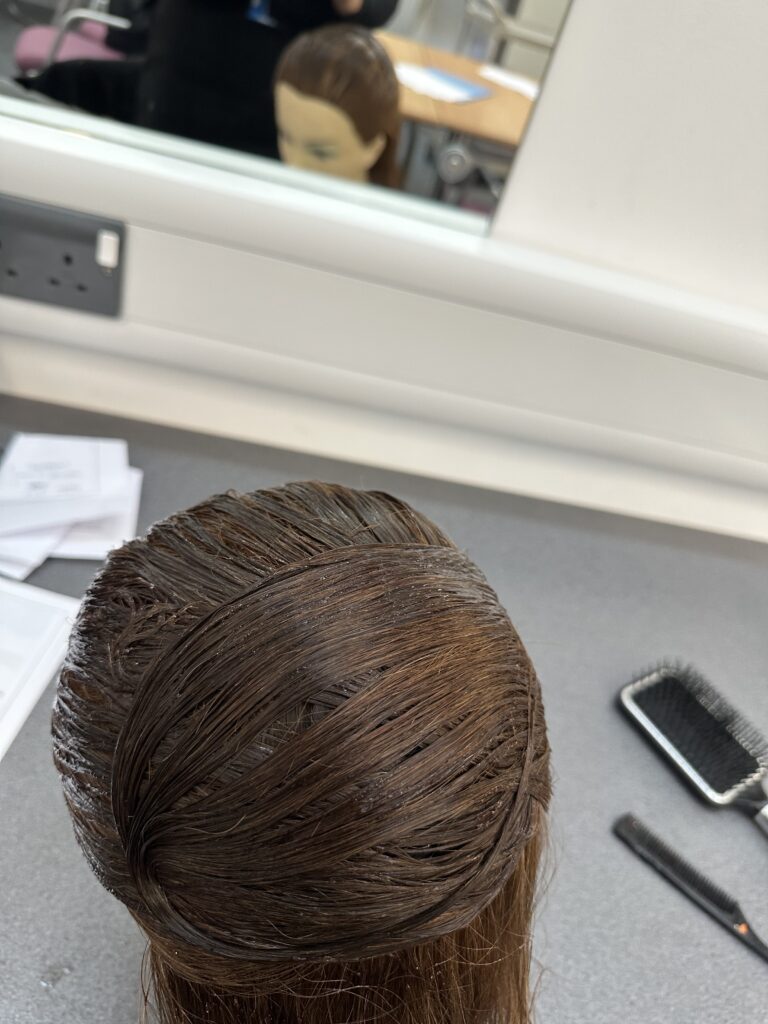
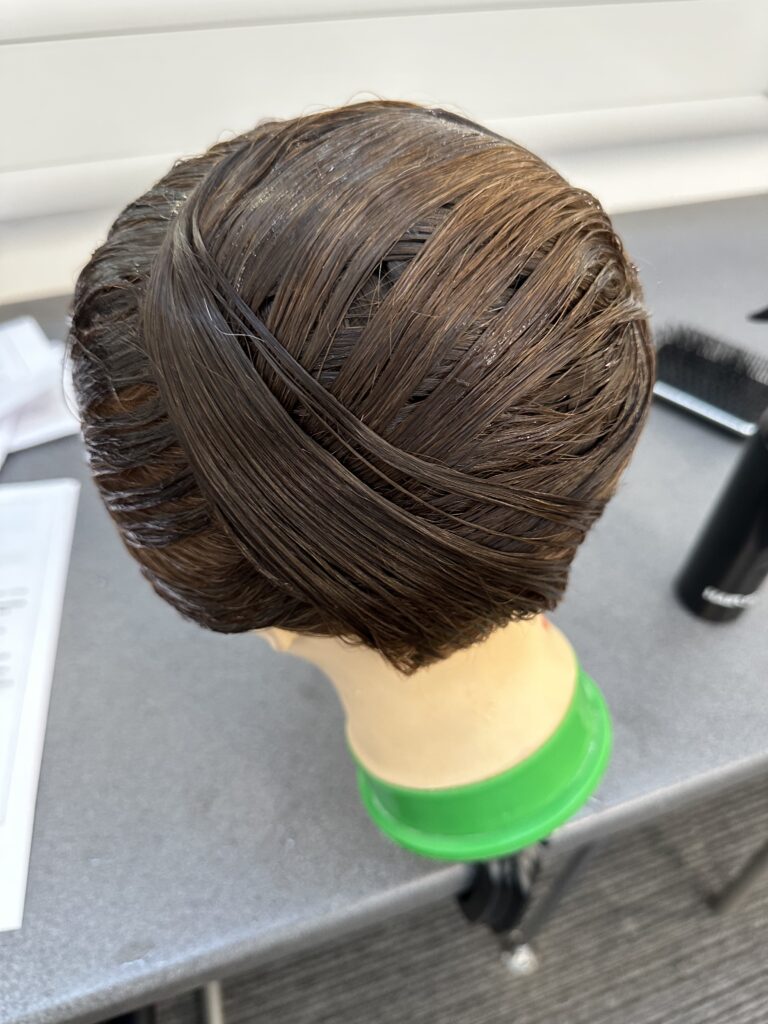

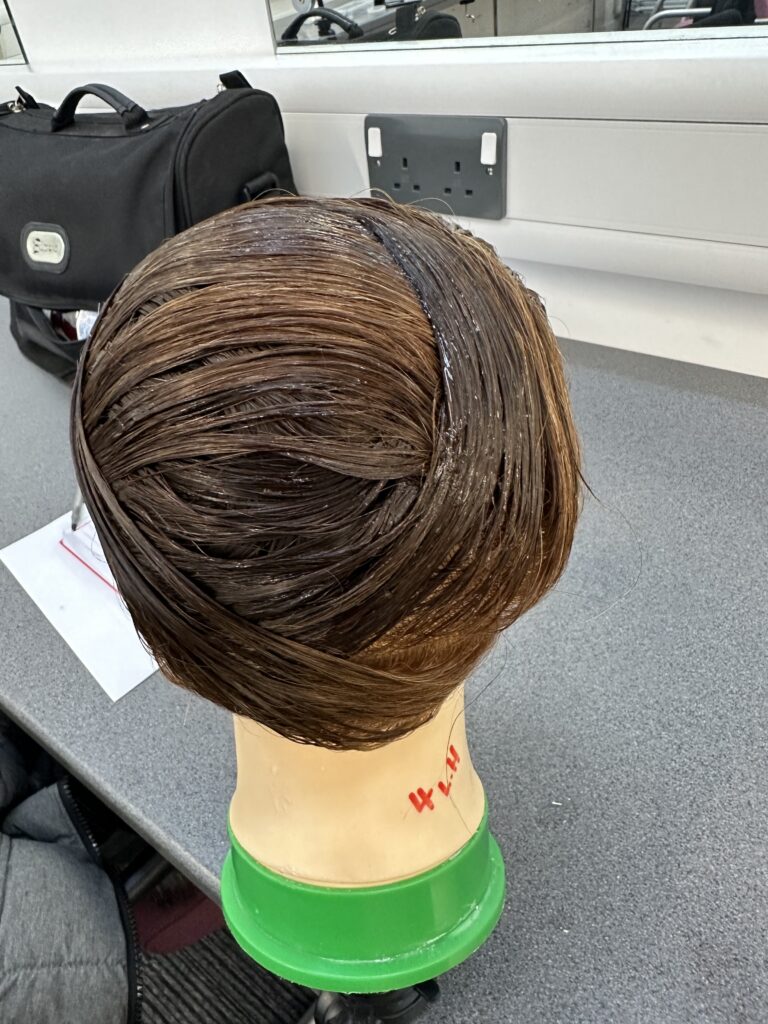
practised more hair rap styles and applying wig techniques with Jasmin.
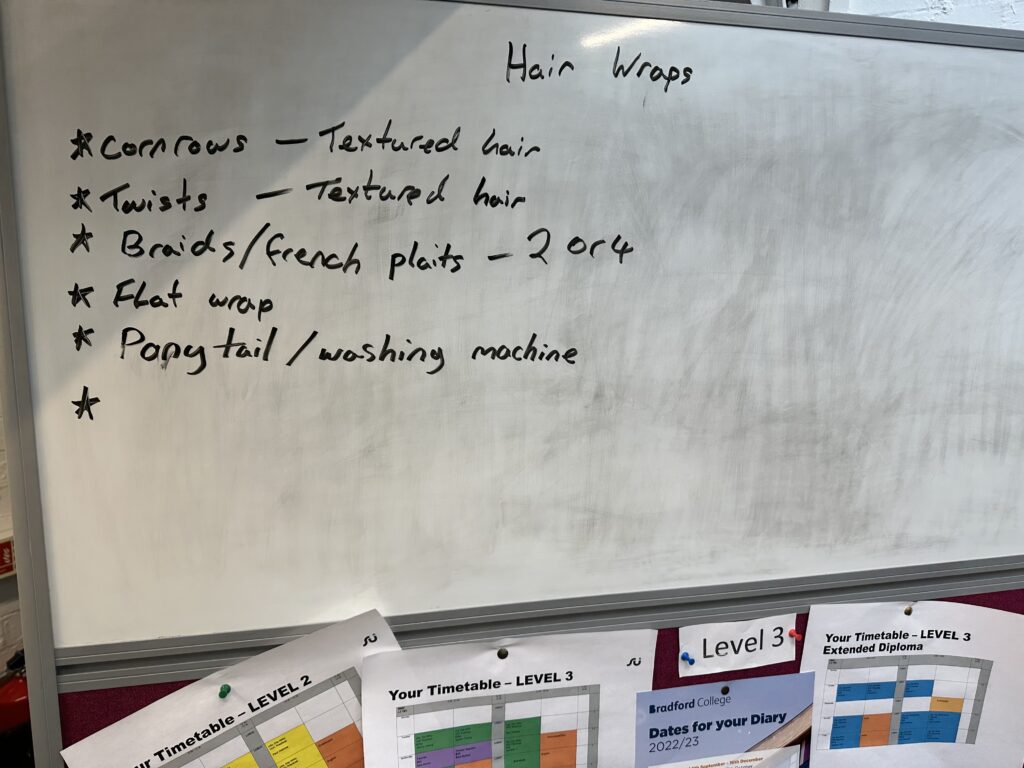


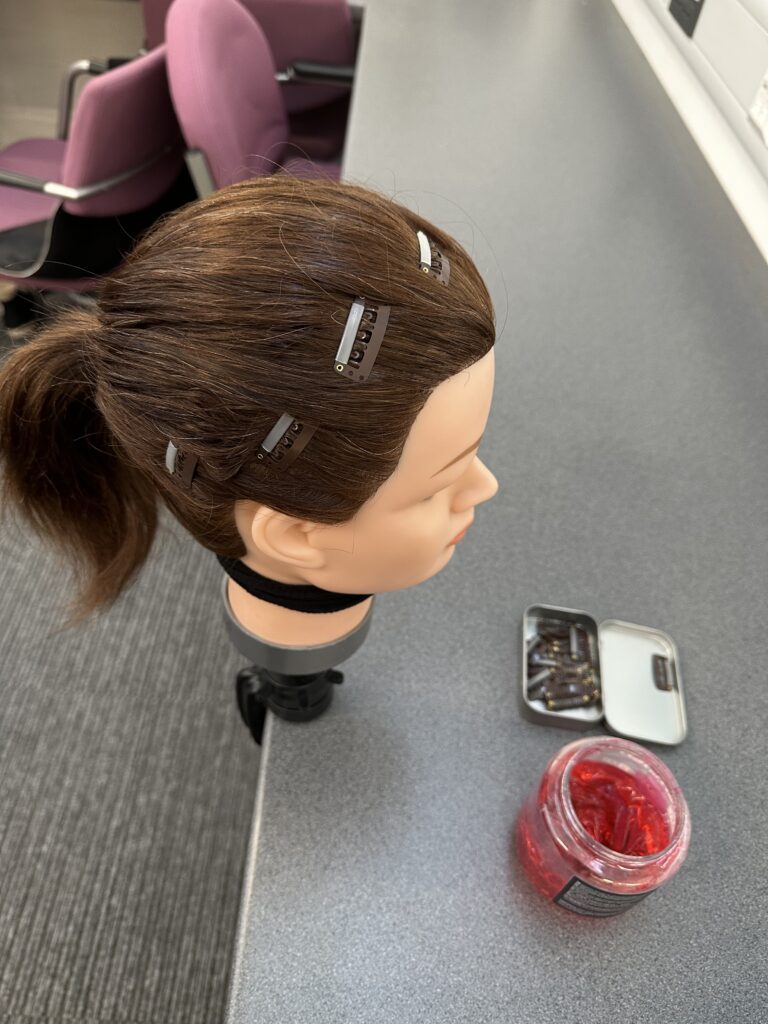

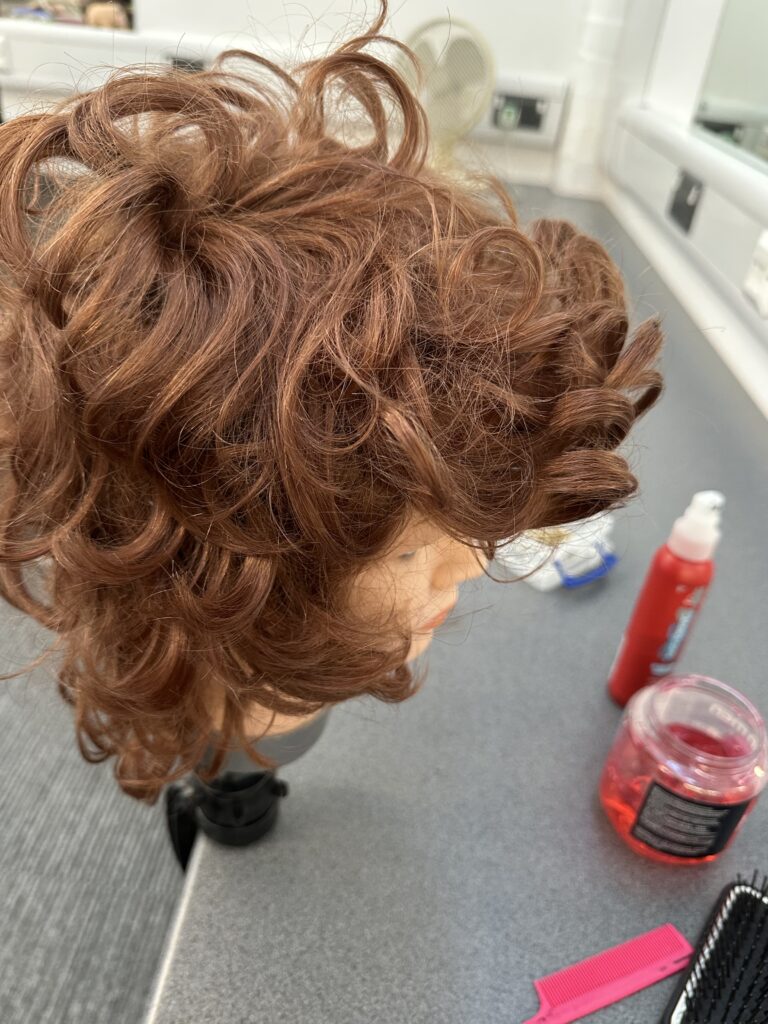
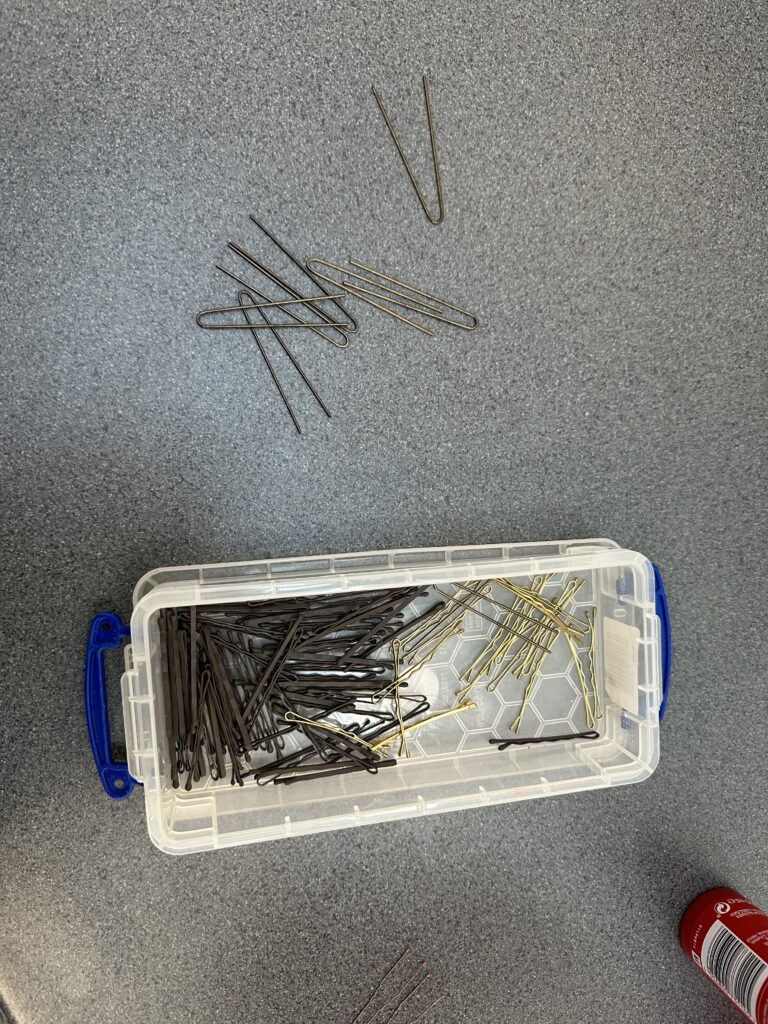
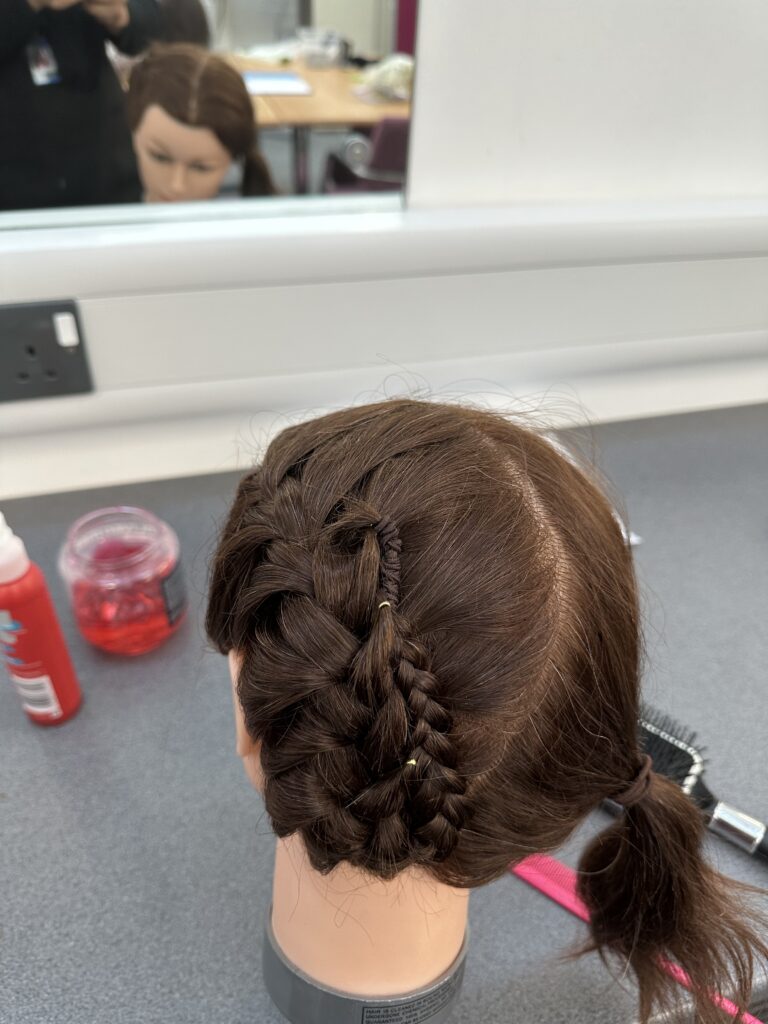

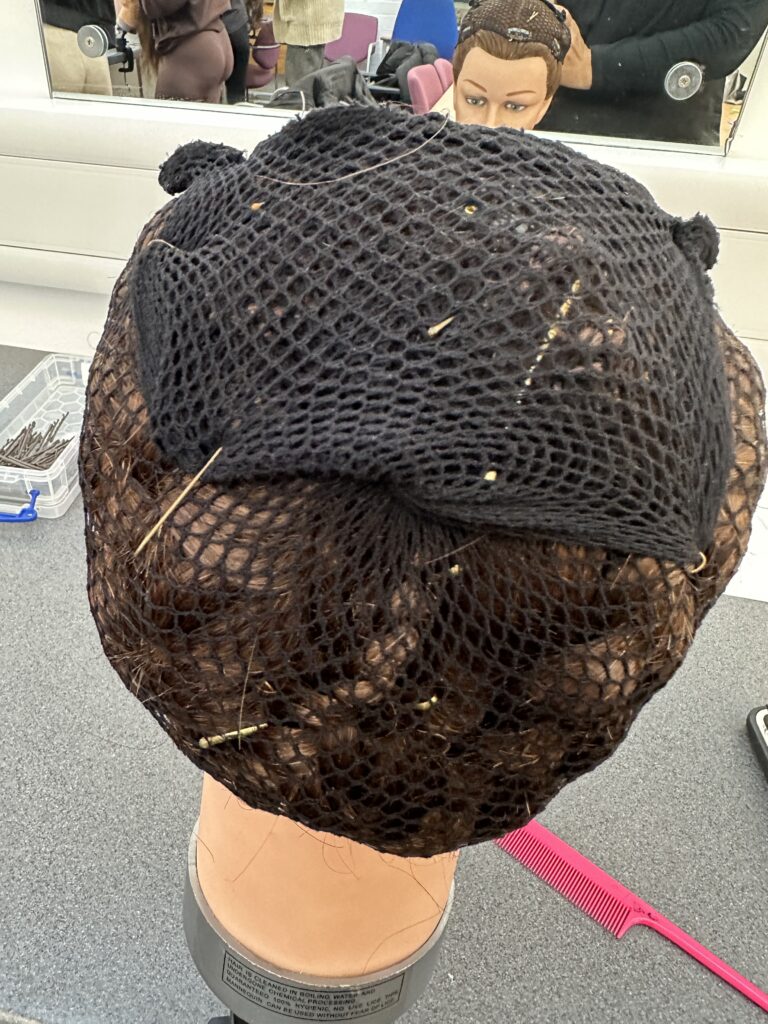
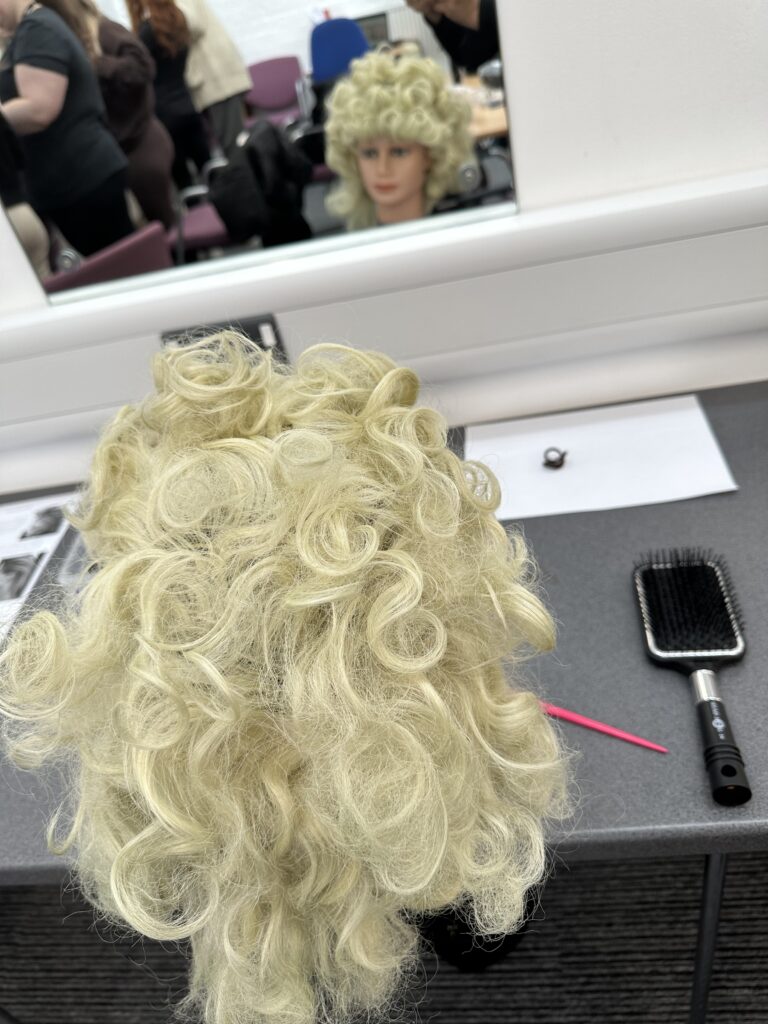

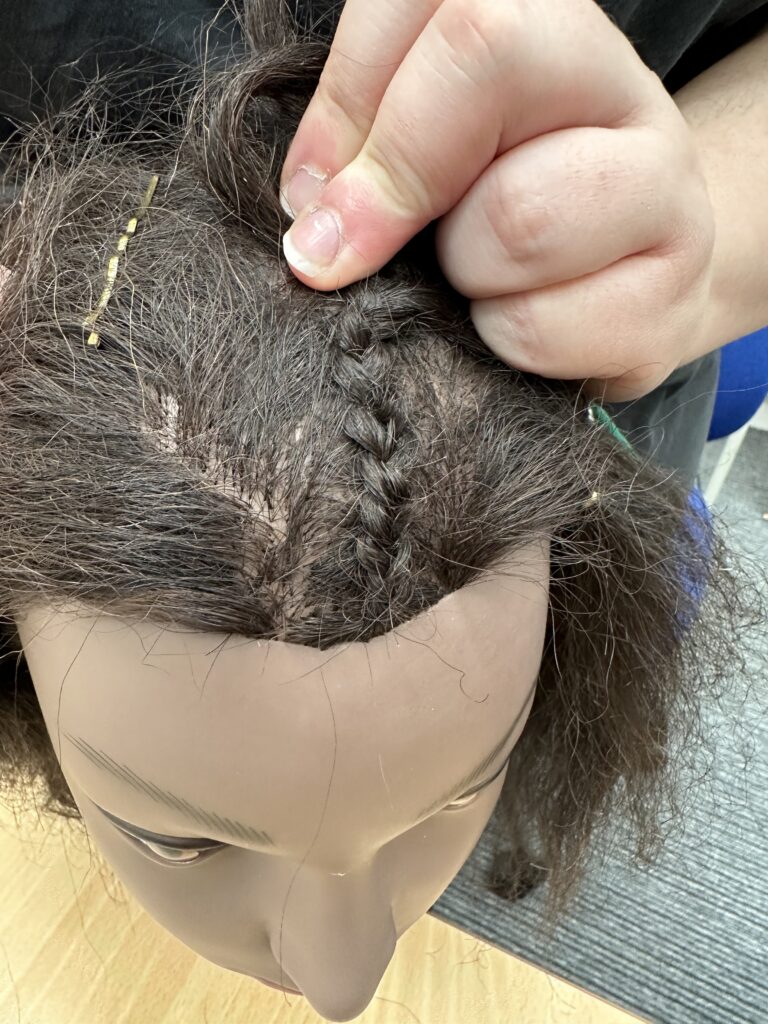
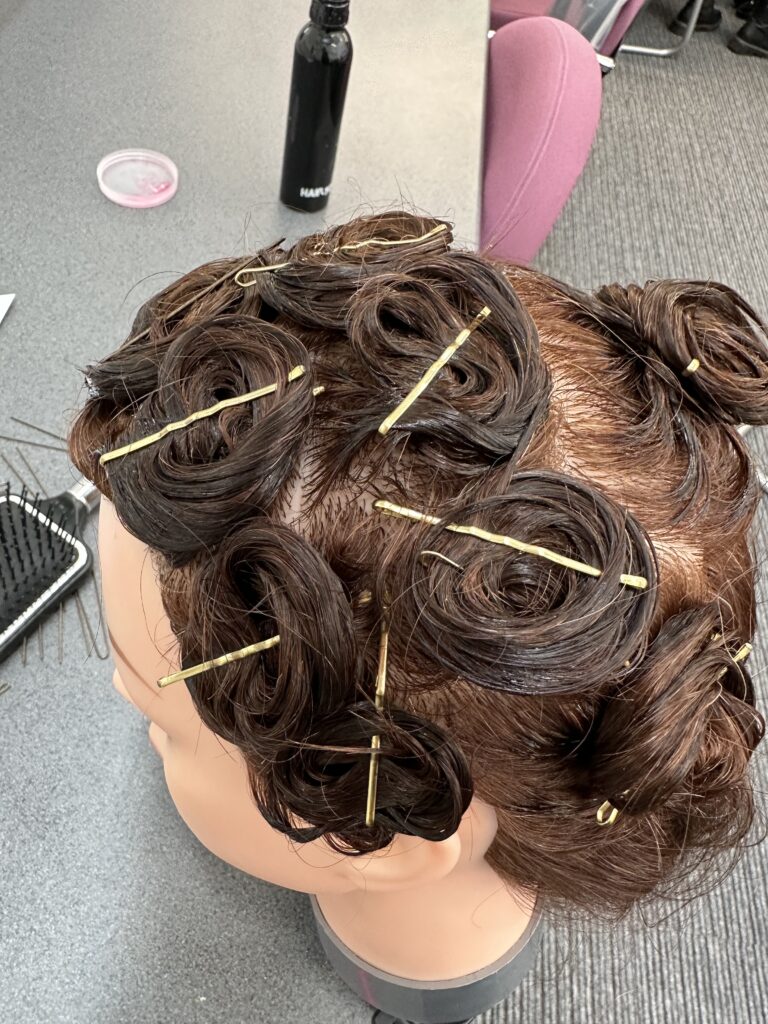
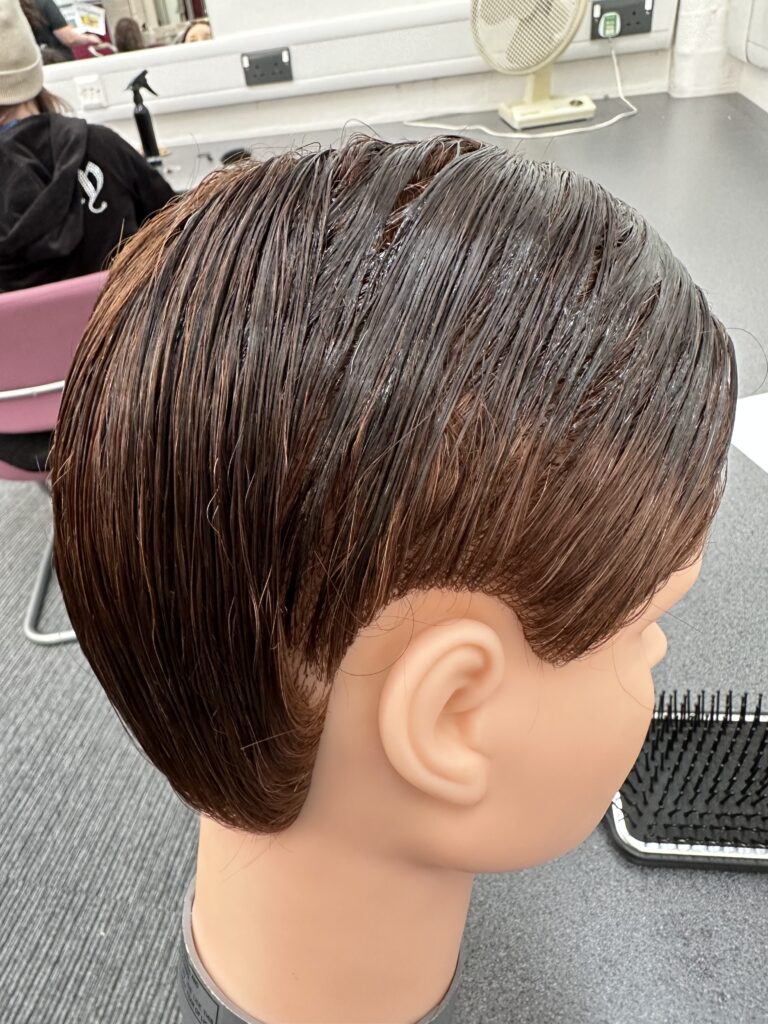
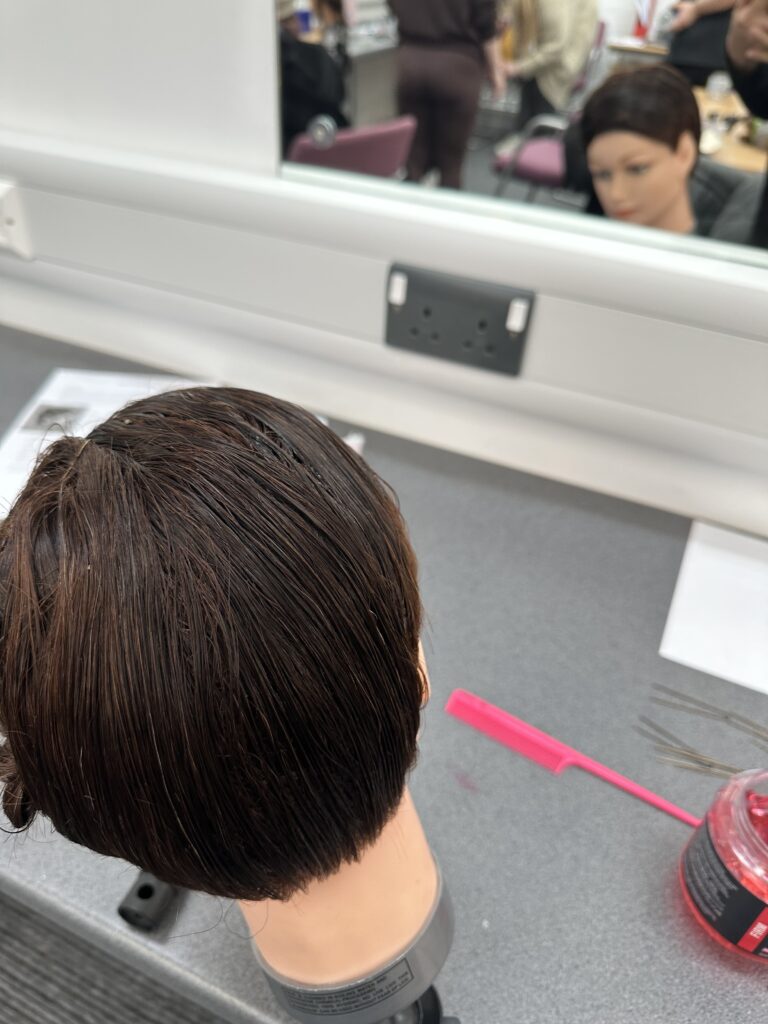
looked at different styles of wigs that were so important for upper class at the vVictorian times.
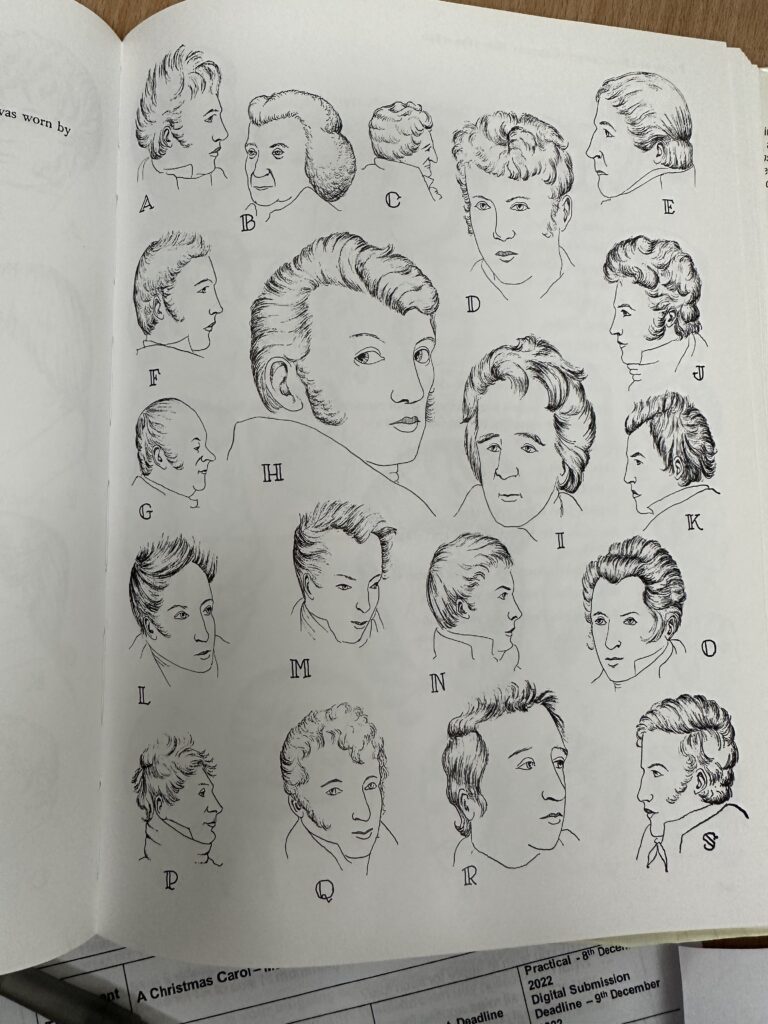
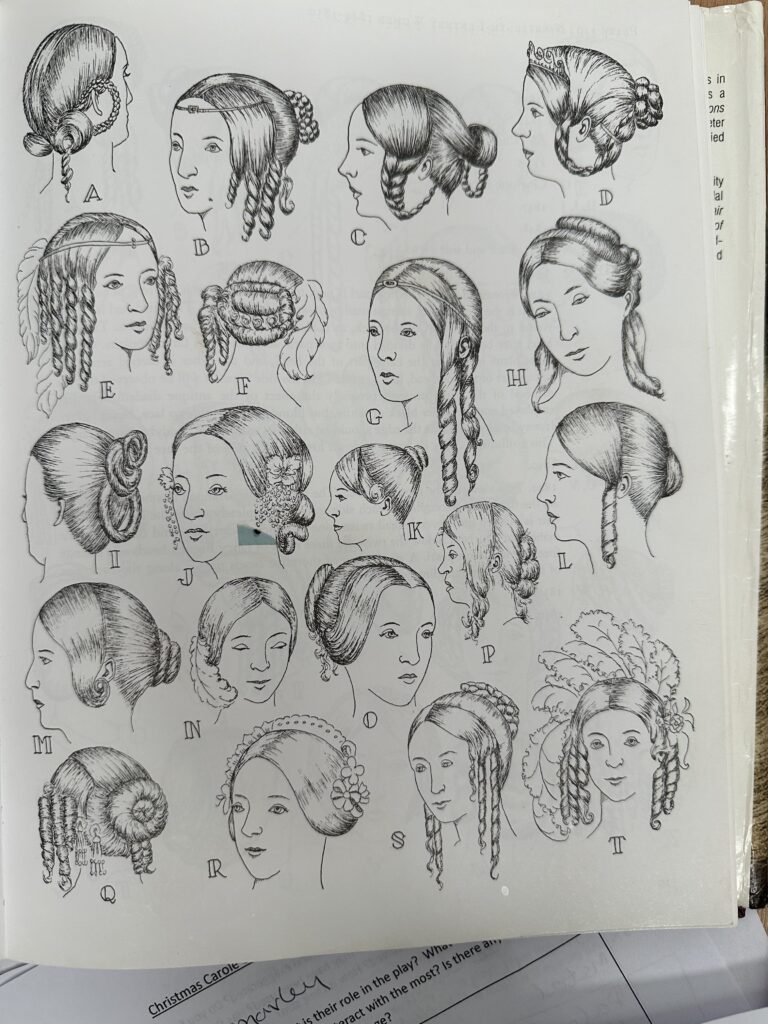
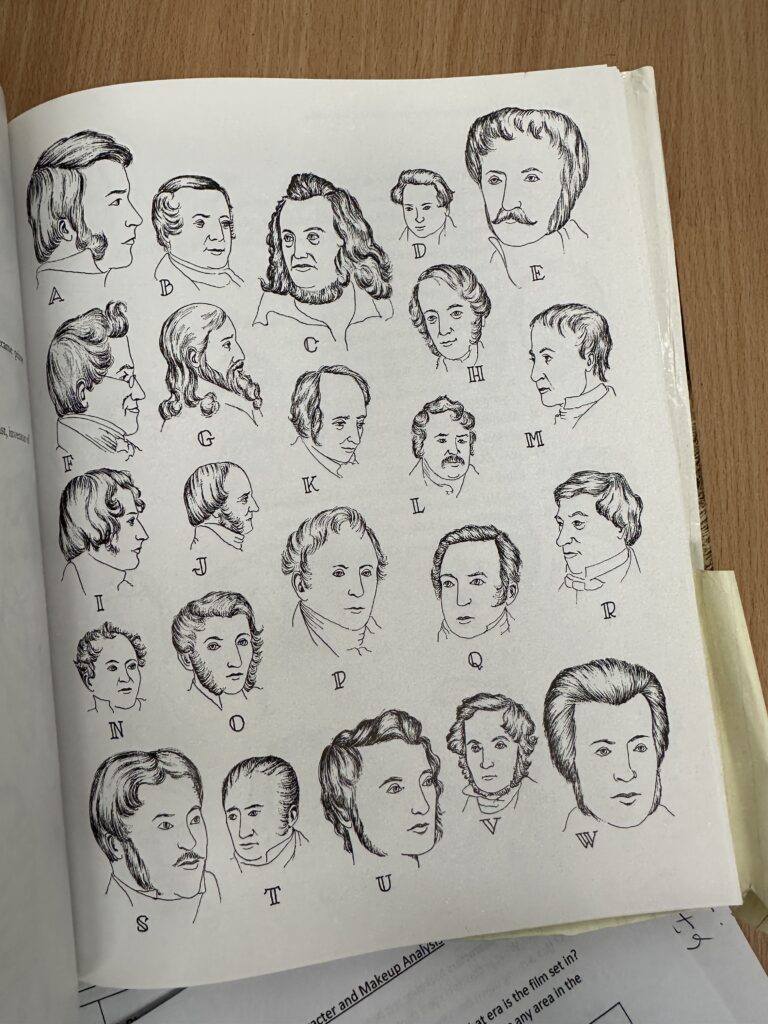
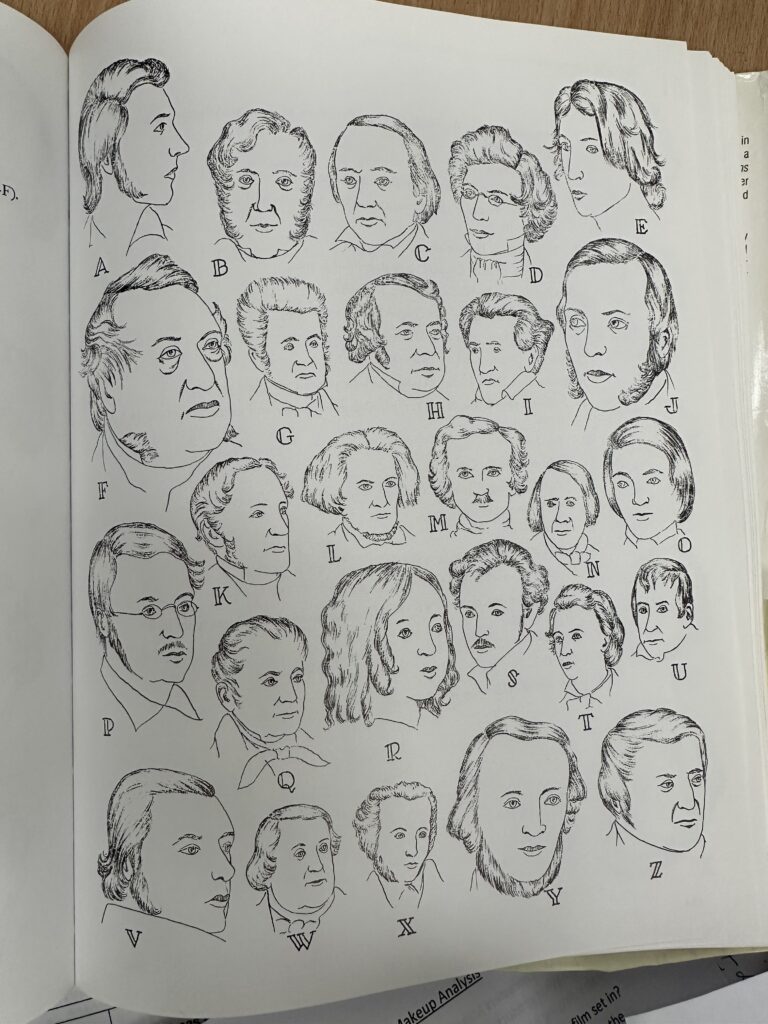
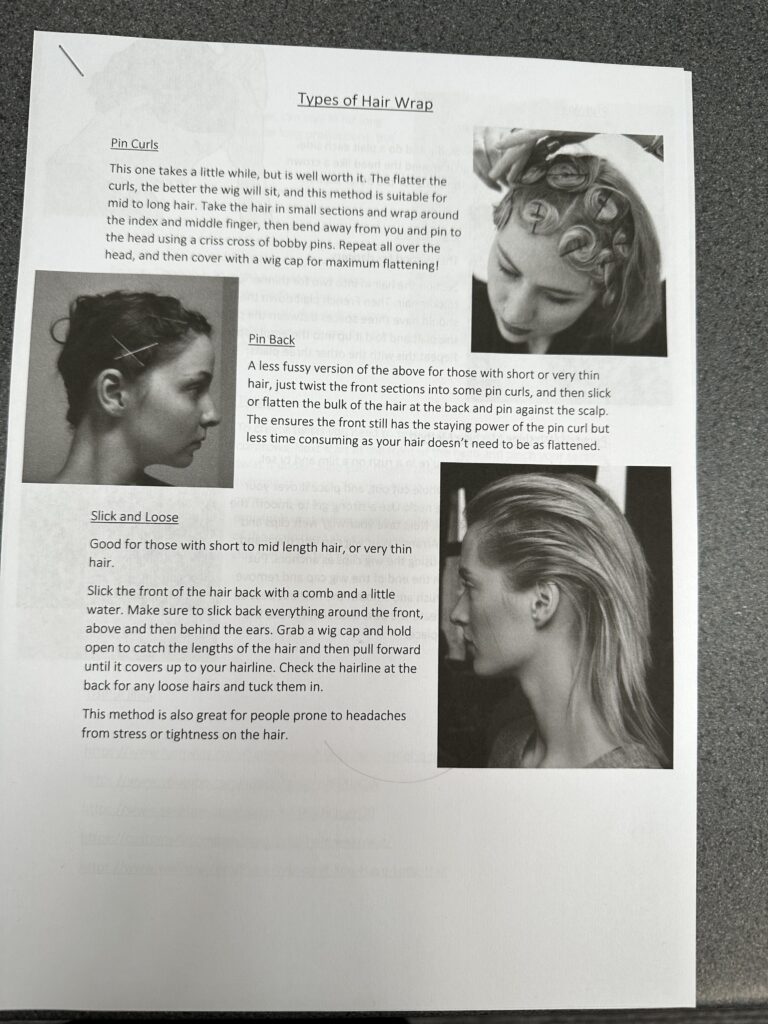
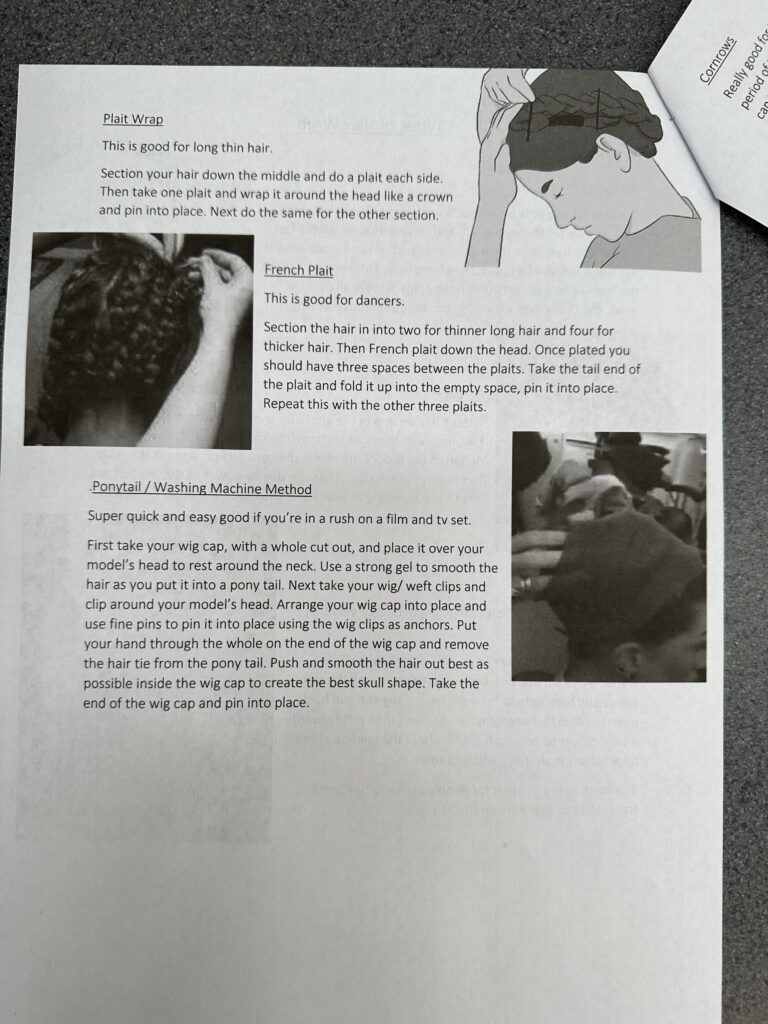
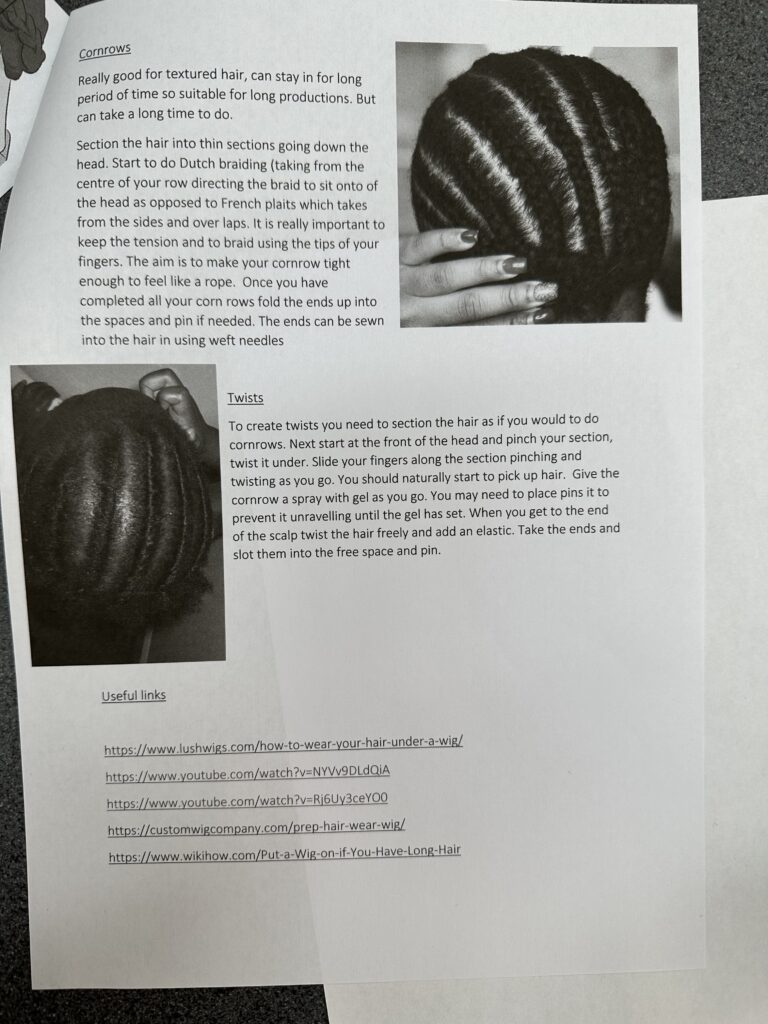
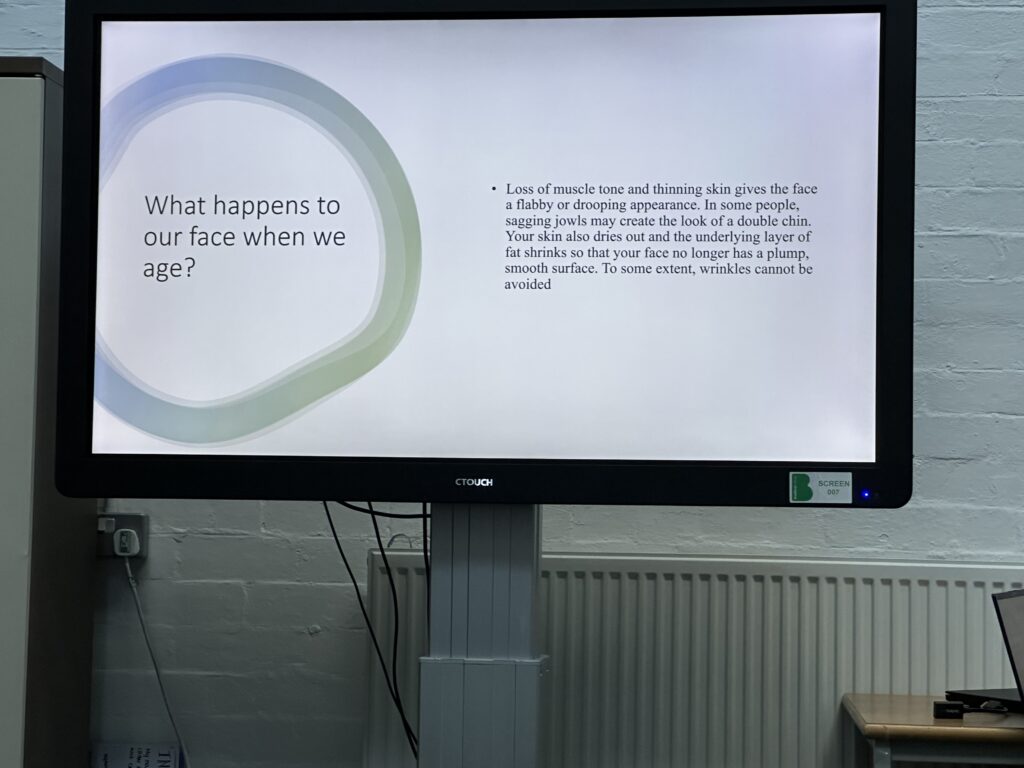
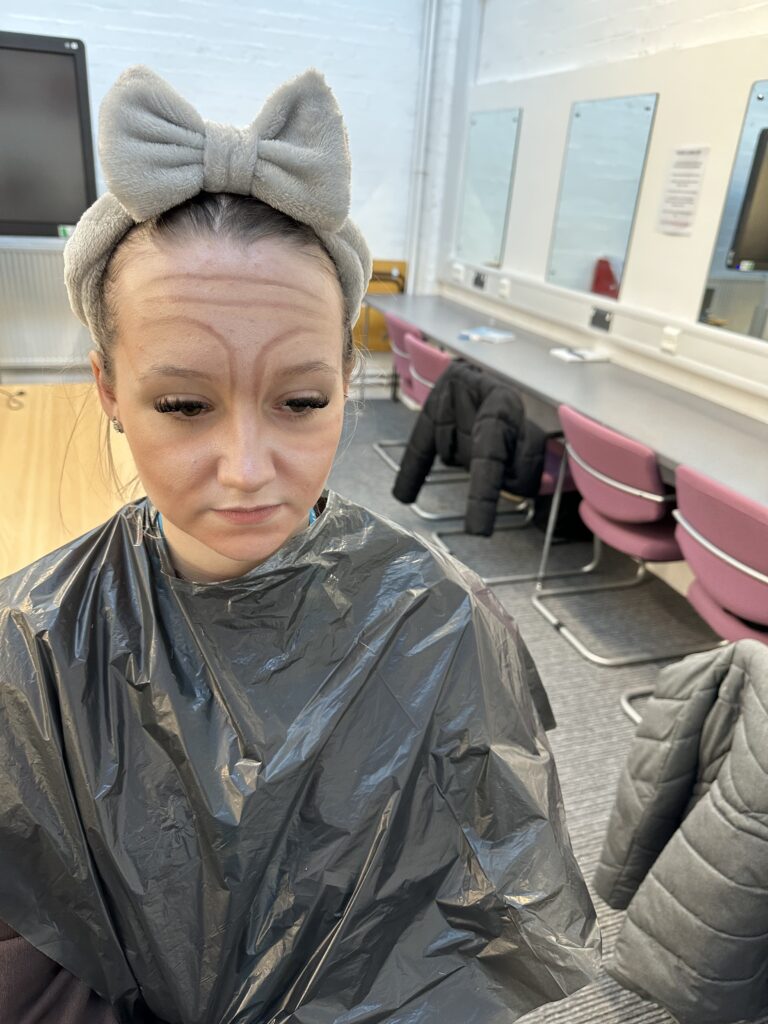



What changes take place when aging?
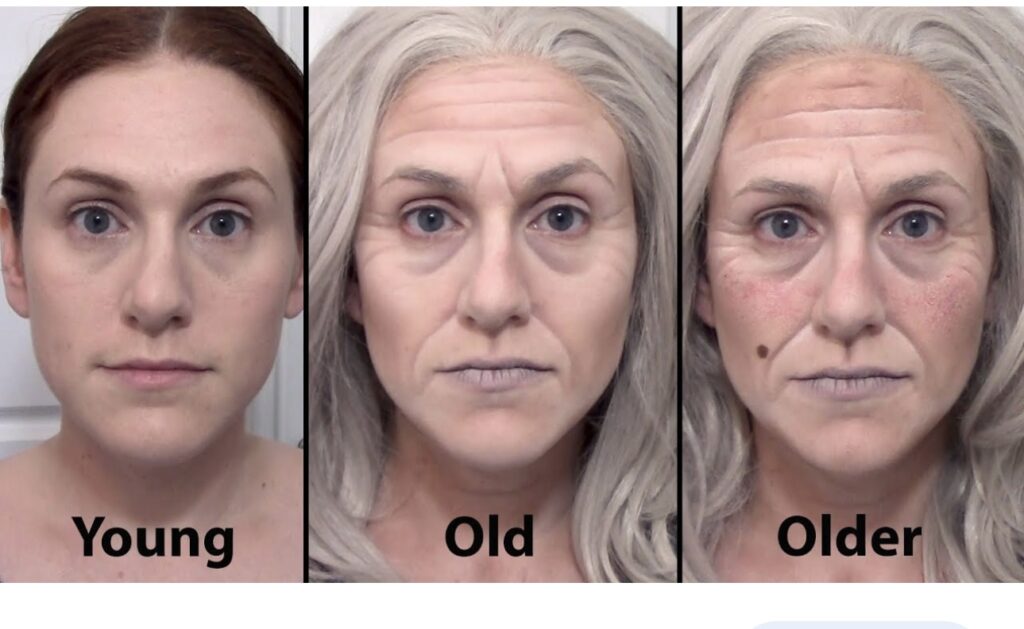
9 Physical Changes That Come With Aging
Posted by Johnson Memorial Health on Sep 22, 2015
As we age, our bodies go through a lot of changes. On the outside we change physically, but there are a lot of internal changes that occur too.

Knowing what to expect and how to slow some of those changes can help you stay as comfortable and active as possible.
1. Heart
Your heart pumps all day and night, whether you are awake or asleep. It will pump more than 2.5 billion beats during your lifetime! As you age, blood vessels lose their elasticity, fatty deposits build up against artery walls and the heart has to work harder to circulated the blood through your body. This can lead to high blood pressure (hypertension) and atherosclerosis (hardening of the arteries).
Taking care of your body with the right types of fuel will help you keep your heart healthy and strong. You can take care of your heart by exercising and eating heart-healthy foods.
2. Bones, Muscles & Joints
As we age, our bones shrink in size and density. Some people actually become shorter! Others are more prone to fractures because of bone loss. Muscles, tendons, and joints may lose strength and flexibility.
Exercise is a great way to slow or prevent the problems with bones, muscles and joints. Maintaining strength and flexibility will help keep you strong. In addition, a healthy diet including calcium can help your bones strong. Be sure to talk to your doctor about what types of diet and exercise are right for you.
3. Digestive System
Swallowing and digestive reflexes slow down as we age. Swallowing may become harder as the esophagus contracts less forcefully. The flow of secretions that help digest food in the stomach, liver, pancreas and small intestine may also be reduced. The reduced flow may result in digestive issues that weren’t present when you were younger.
4. Kidneys and Urinary Tract
Kidneys may become less efficient in removing waste from the bloodstream because your kidneys get smaller as they lose cells as you age. Chronic diseases such as diabetes or high blood pressure can cause even more damage to kidneys.
Urinary incontinence may occur due to a variety of health conditions. Changes in hormone levels in women and having an enlarged prostate in men are contributing factors that lead to urinary incontinence.
5. Brain and Nervous System
As we age, we naturally lose cells. This is even true in the brain. Memory loss occurs because of the number of brain cells decreases. The brain can compensate for this loss by increasing the number of connections between cells to preserve brain function. Reflexes may slow down, distraction is more likely and coordination is affected.
6. Eyes
There are many vision changes that occur as we age. We may need help seeing objects that are closer as our lens stiffens. We may have a more difficult time seeing in low-light conditions, and colors may be perceived differently. Our eyes may be less capable of producing tears and our lenses may become cloudier.
Common eye problems associated with age include cataracts, glaucoma and macular degeneration.
7. Ears
Excessive noise throughout your lifetime can cause hearing loss as you age. Many older adults have difficulty hearing higher pitched voices and sounds, trouble hearing in busy places and more frequently accumulating earwax.
8. Hair, Skin, and Nails
As you age, your skin becomes more dry and brittle, which can lead to more wrinkles. The fat layer under the skin thins, which results in less sweating. This may seem like a good thing, but it makes you more susceptible to heat stroke and heat exhaustion in the summer. Hair and nails grow slower and become brittle. Hair will thin and turn gray.
9. Weight
Decreasing levels of physical activity and a slowing metabolism may contribute to weight gain. Your body may not be able to burn off as many calories as it once could, and those extra calories will end up being stored as fat.
While you can’t prevent aging, you can prepare yourself for the various effects of aging, both outside and inside the body.
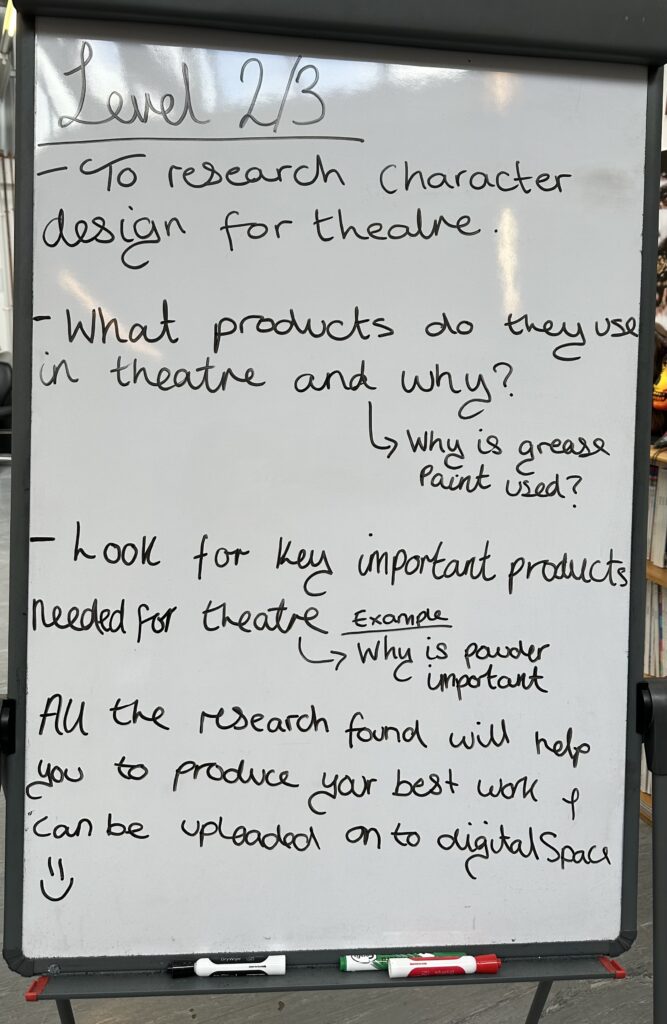

https://www.makeupfirst.com/blog/theatrical-makeup/product
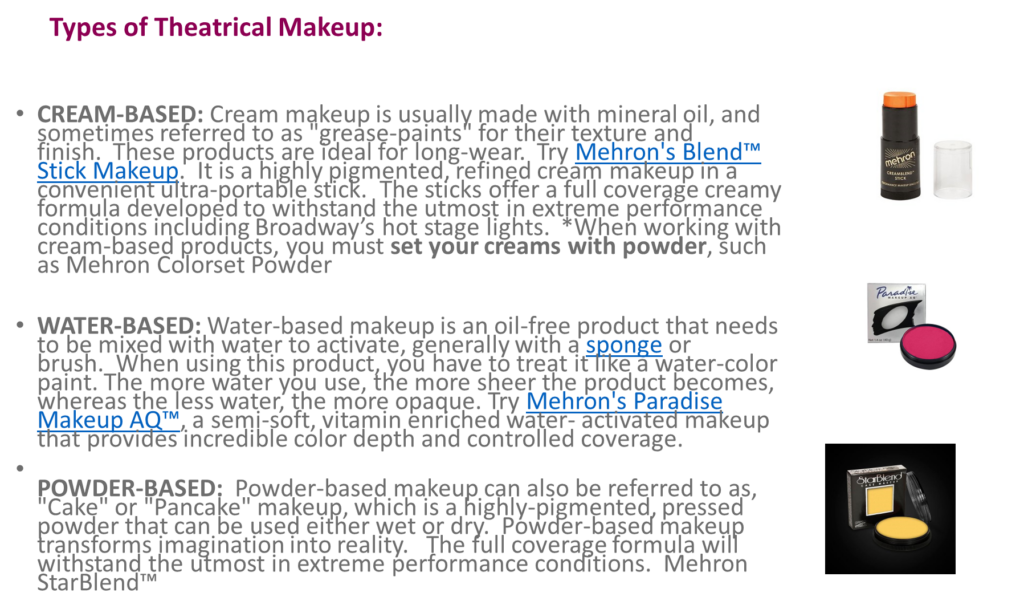
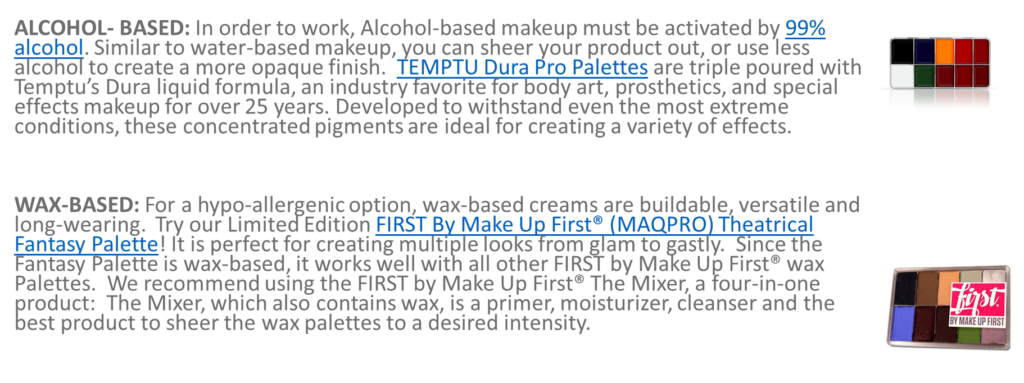
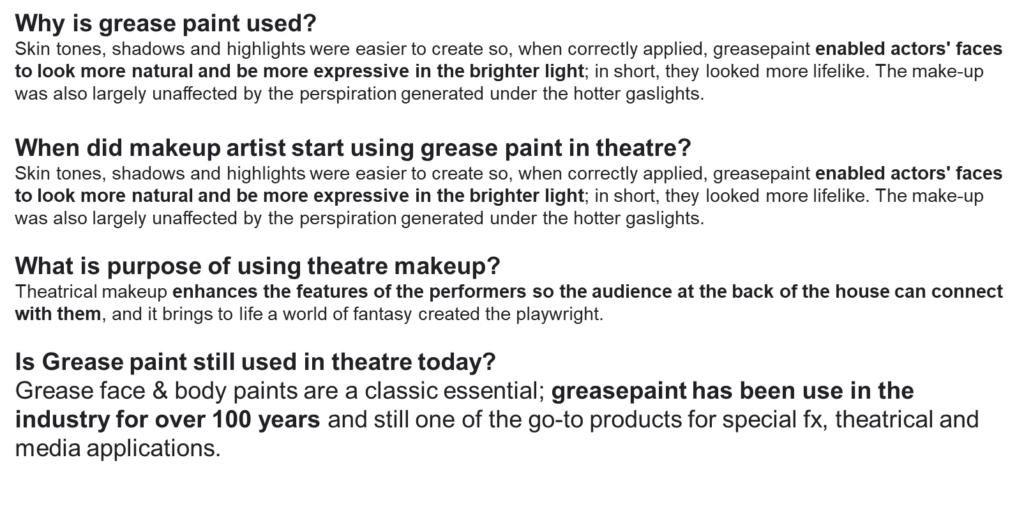
Powder: powder is used as the finishing touch to set and keep stage makeup in place. Translucent powder is the most versatile for most skin textures and colours. However, powder colours to match skin tones are available, and also consider a neutral white that works equally well for all skin tones and doesn’t ruin the bright colours of liners or foundation.
in theatre/stage Supplied as a powder, when mixed with water it becomes a fast-setting mould-making material which is used to make casts of body parts or delicate prop items. The resulting mould is very detailed and strong.
NICK DUDMAN
Makeup Effects Artist, Prosthetics Designer and Practical Creature Effects Producer
SPECIAL MAKEUP EFFECTS and PROSTHETICS
DESIGNER / PRODUCER / SUPERVISOR
Nick Dudman is a multi award-winning special make-up effects artist with four decades of experience in the film industry; working as the designer / supervisor on a huge range of successful motion pictures and TV shows.
Among his latest Projects:
Makeup Effects Designer on Amazon / Sony’s “The Wheel of Time”, Seasons 1 and 2.

Inside The The Wheel Of Time – Makeup Special Effects https://www.amazon.com/Wheel-Time-Season-1/dp/B09F59CZ7R
Makeup Effects Designer on Amazon / Legendary’s “Carnival Row”, Seasons 1 and 2,
Credited as Co-Producer on the final 2 episodes
Carnival Roe – https://youtu.be/Xt6tUc0p8pY –

He also designed the prosthetic makeup effects for Showtime’s “Penny Dreadful”

His Creatures Department’s work from all 8 Harry Potter movies is on show at the Studio Tour at Warner Bros Studios, Leavesden,UK.

HARRY POTTER
Making a move into producing, he is developing a major TV Series based on the best-selling “The Saga of The Exiles” novels by Julian May.

Other projects in development include “The Downstairs Bathroom”, a wartime battle of the sexes over a ladies convenience.

Biography
Nick Dudman and his team created the makeup effects and the magical animatronic creatures ( and the CG scanning models ) in all of the Harry Potter films, garnering BAFTA nominations for the first four in the series, and also for the seventh. The final installment, “Harry Potter and The Deathly Hallows-Part 2” earned him an Oscar nomination for best makeup as well as another BAFTA nomination.
In 2006 Nick Dudman was invited to join the Academy of Motion Picture Arts and Sciences. In 2007 he was presented with the Canadian Genie Award for Special Achievement in Makeup for Beowulf and Grendel.
Dudman got his start in films working on the Jedi master Yoda, as a trainee to British makeup artist Stuart Freeborn, on the second in the Star Wars series – The Empire Strikes Back.
After apprenticing with Freeborn for four years on films such as Superman II and Top Secret!, Dudman was asked to head up the English makeup prosthetics shop for Ridley Scott’s Legend, applying Tim Curry’s “Darkness” makeup amongst others. Subsequently, he has worked on Mona Lisa, High Spirits, Willow, Interview With the Vampire, Batman (creating Jack Nicholson’s Joker) and Judge Dredd among many others.
In 1995, his career path widened into animatronics and large scale creature effects when he was asked to oversee the creature department for the Luc Besson film The Fifth Element, for which he won a BAFTA for best Visual Effects.
Since then he has supervised the creatures / makeup effects departments on a series of blockbusters including Star Wars Episode 1: The Phantom Menace, The Mummy and The Mummy Returns.
Having completed the ten-year challenge of the Harry Potter franchise, Nick is looking for yet more creative challenges and expanding his role to make most use of his unique experience.
His latest work includes Paddington and all three seasons of Penny Dreadful, Showtime’s gothic horror series, which have garnered two BAFTA Craft award nominations for Best Makeup with a win for season one, three EMMY Nominations, one for each season, and two Hollywood Guild of Makeup Artists and Hairdressers nominations for Best Special Effects Makeup.
He has also supervised the installation of creatures at The Making of Harry Potter Tour at Warner Bros Leavesden Studios. The Creature Shop section of the tour houses a permanent display of the work created by Nick and his teams over the entire Harry Potter series.
His latest finished project is as the Makeup Effects Designer on Seasons One and Two of Legendary’s “Carnival Row”and as Makeup Effects Designer on Seasons One and Two of Sony’s “The Wheel of Time”.
In 2013 he was awarded an Honorary Fellowship from the Arts University, Bournemouth, and in 2022, he received an Honorary Doctorate from the University of Bolton.
Nick Dudman is currently developing Julian May’s “The Saga of the Exiles” as a Television series.
Some of the Awards

Academy Awards, USA
2012
• Nominated, Oscar
Best Achievement in Makeup for Harry Potter and the Deathly Hallows: Part 2 (2011).

BAFTA Awards
2012

Artificial Stage Blood
Nick Dudman has over many years been asked to supply this simple non-staining imitation blood to film, television and stage productions throughout the UK and around the world.

Nick Dudman Washable Blood is requested by stage management, special effects, props, wigs and wardrobe departments and make-up effects artists as it is easily and safely removed from skin and a broad range of materials and surfaces without the use of chemicals.
Additional assessment Evidence
Week-3
did curling long hair wigs using various sizes of curling rollers.
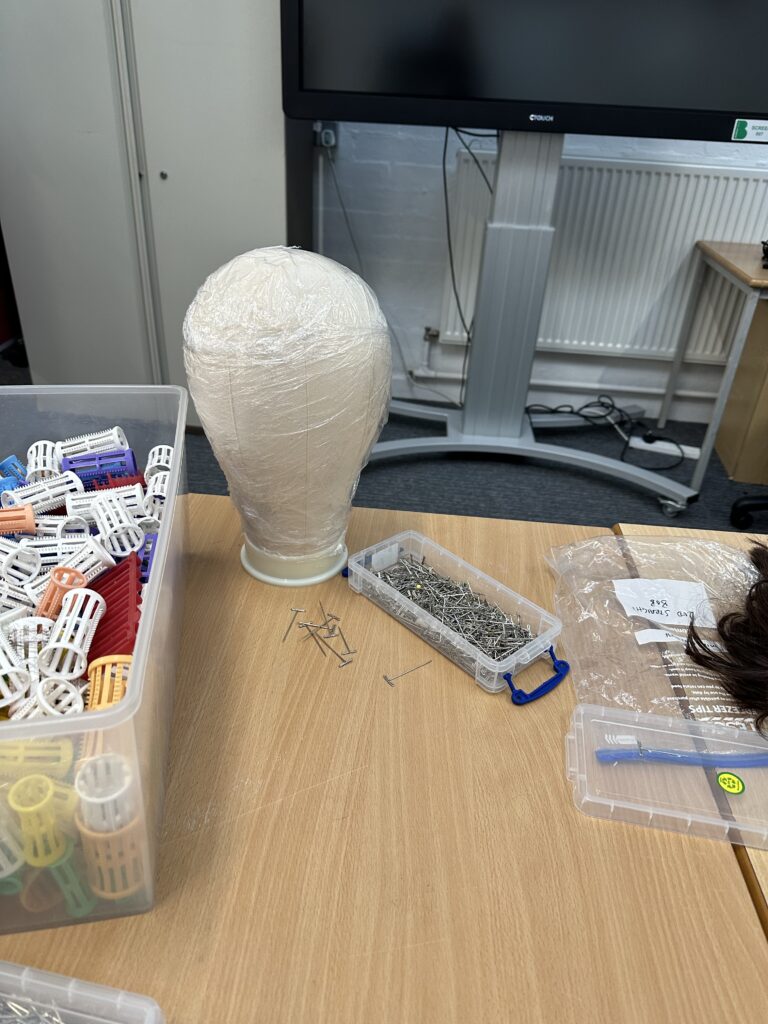
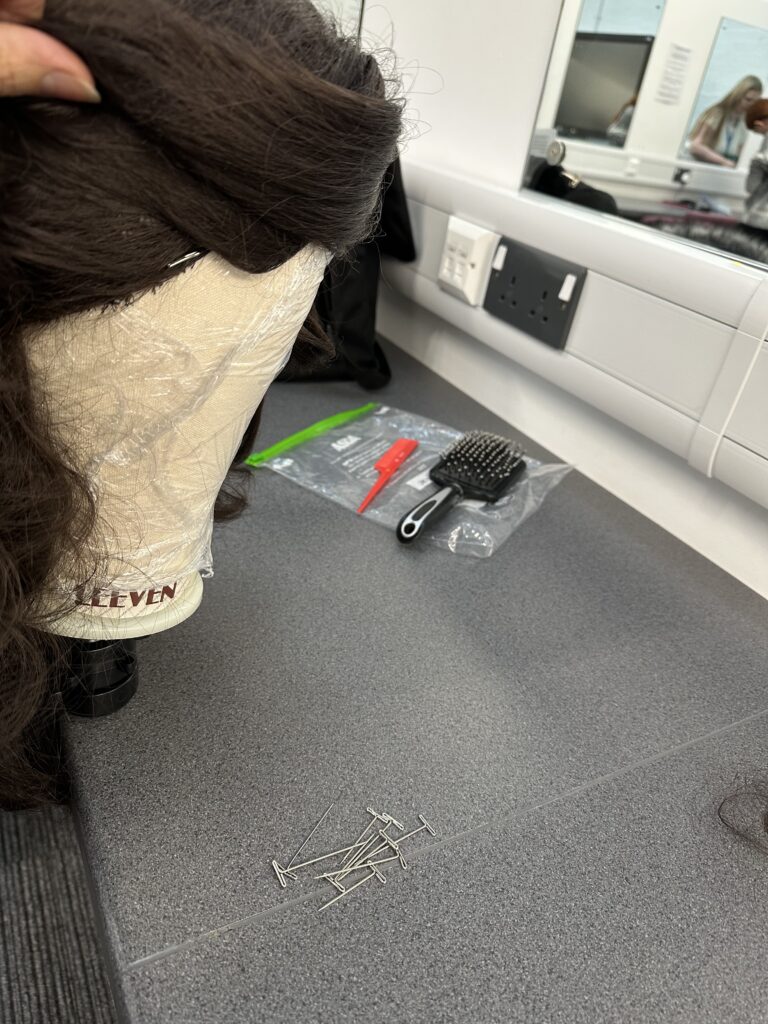
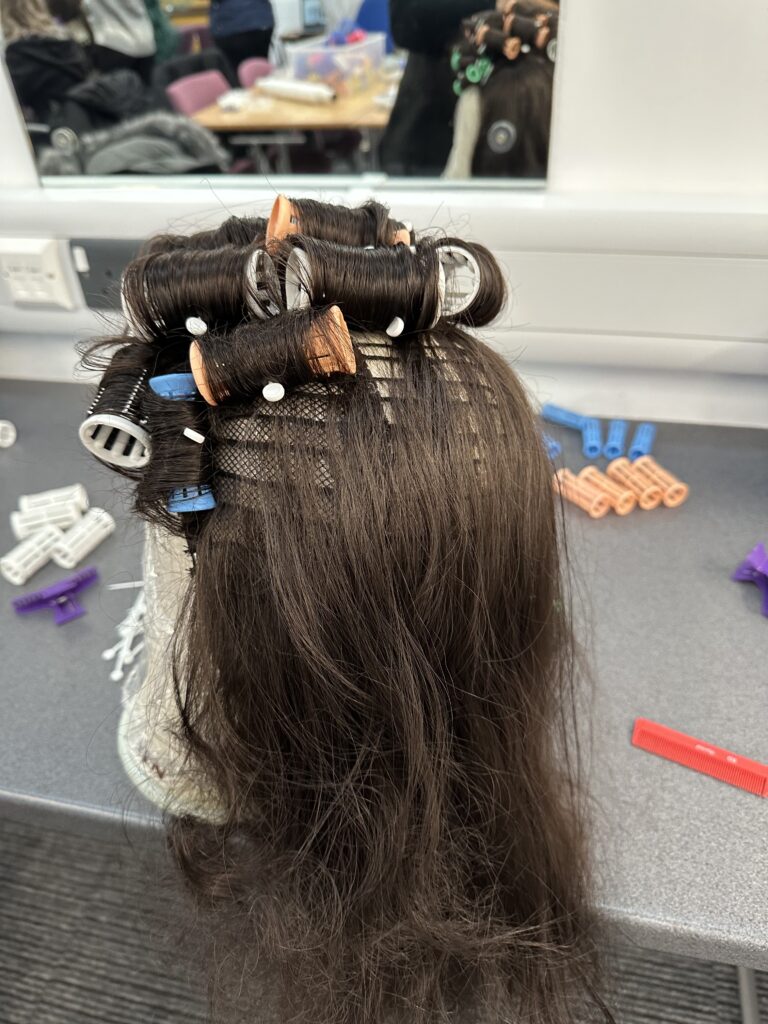

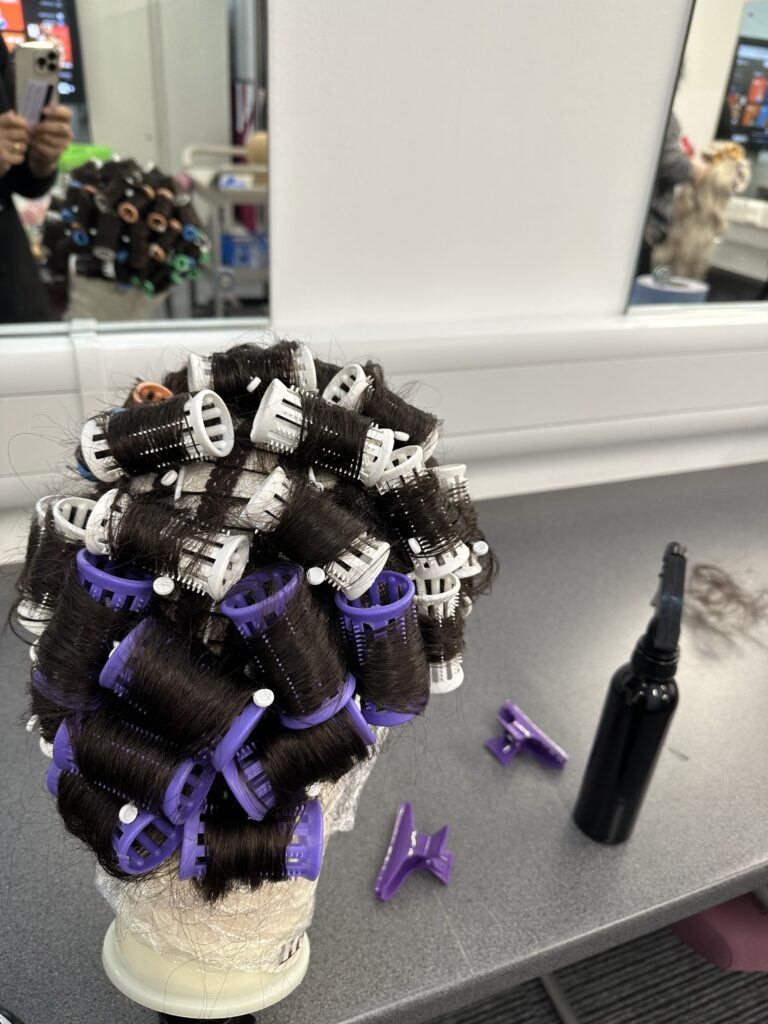
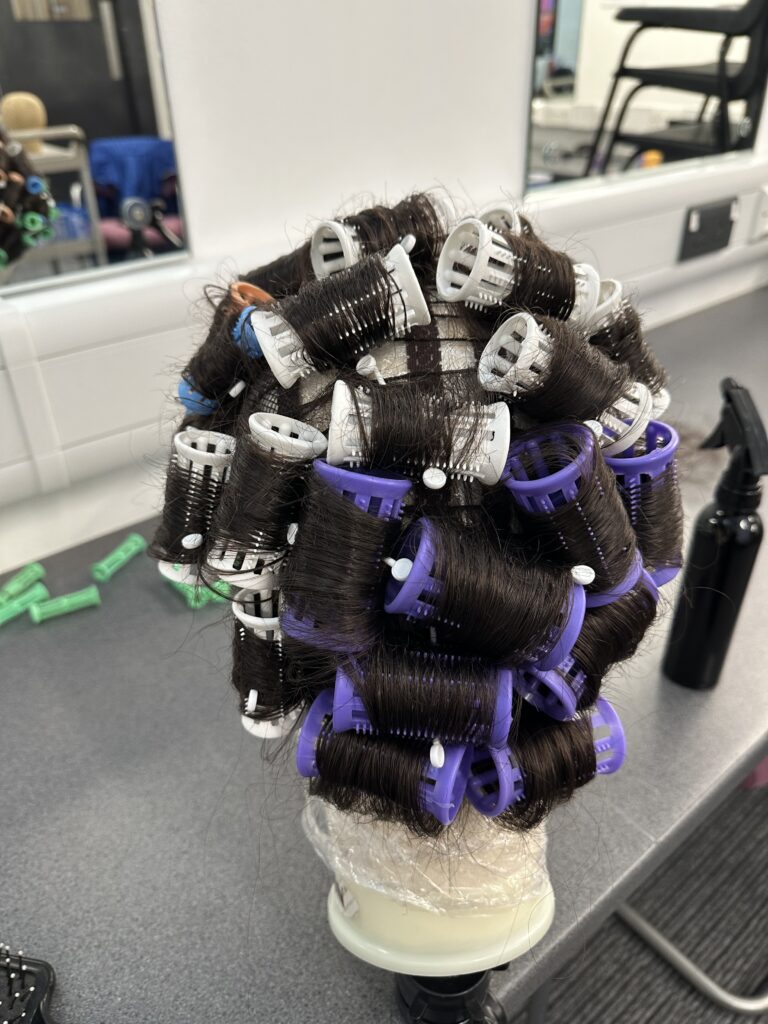
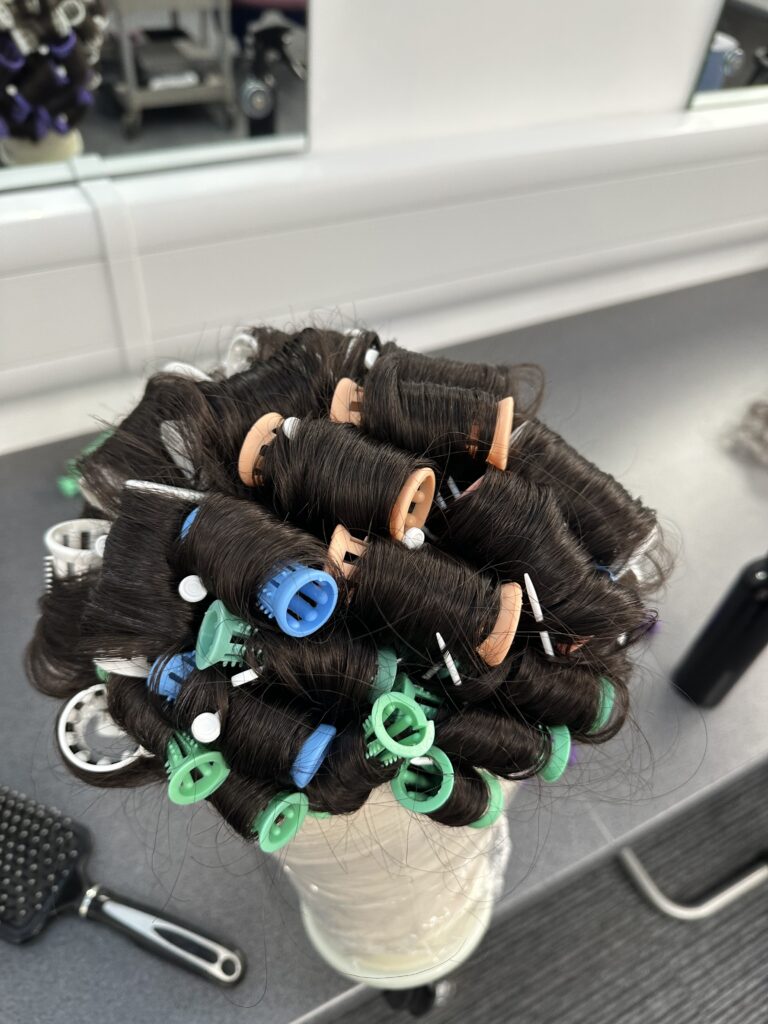
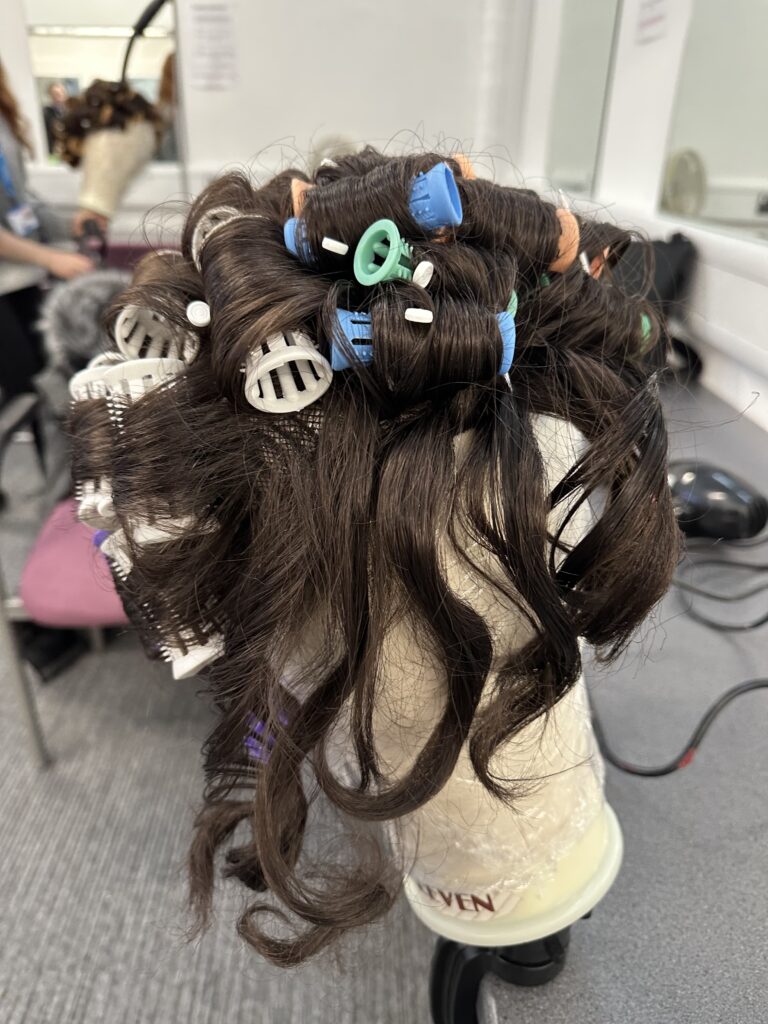
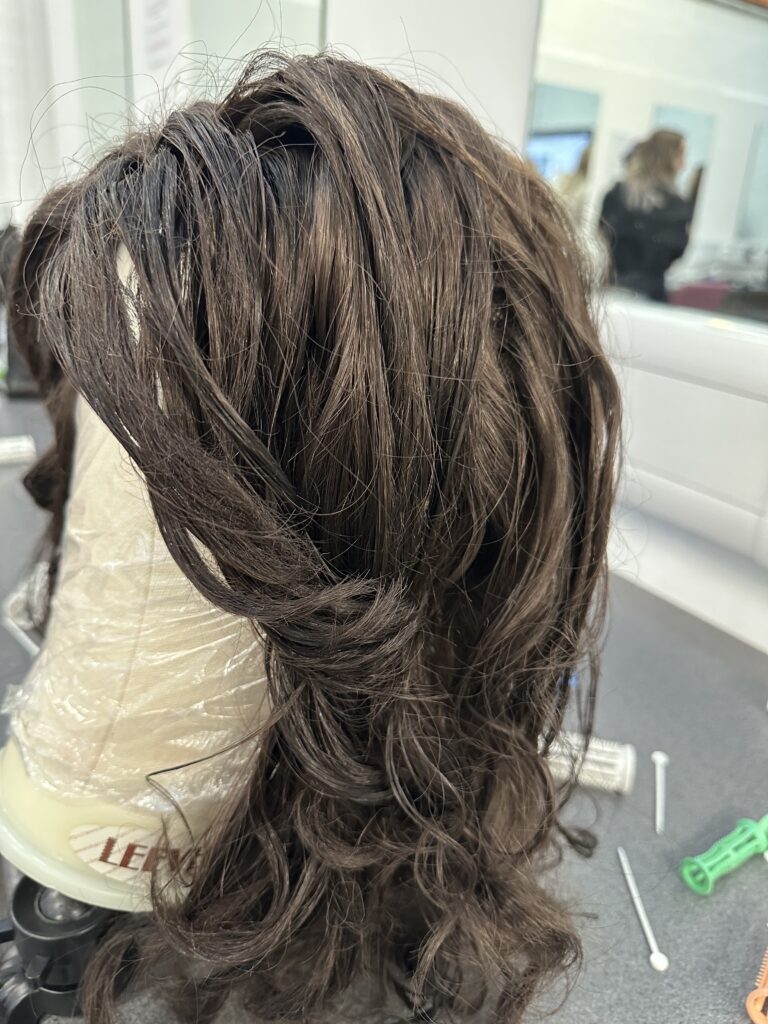
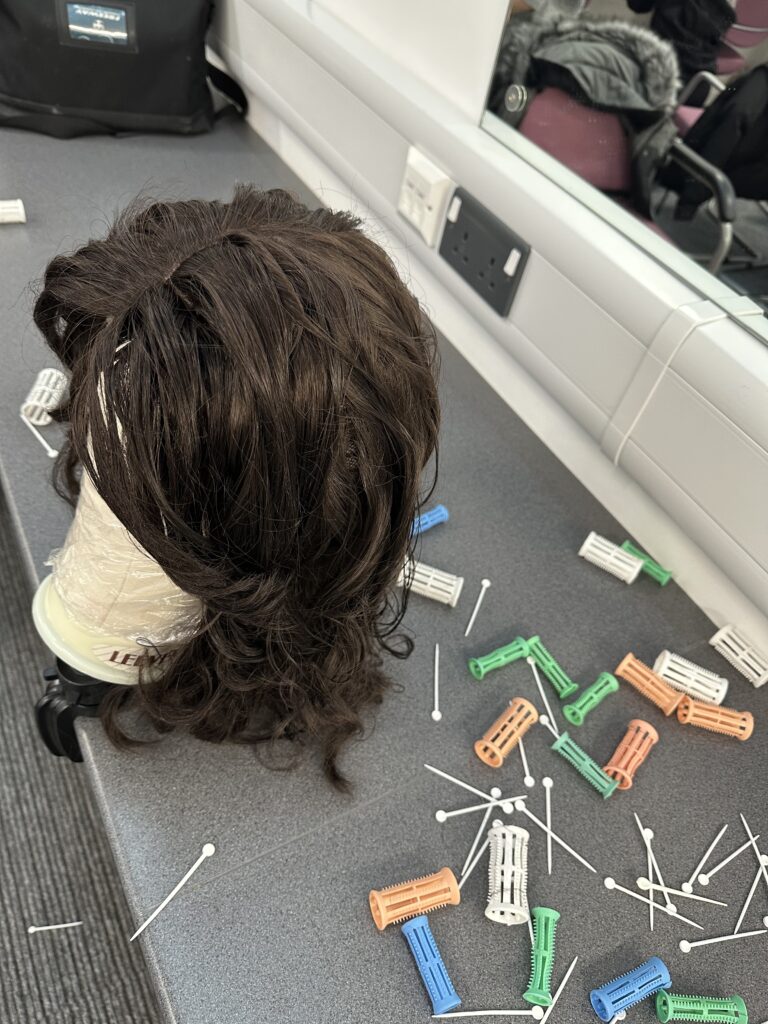
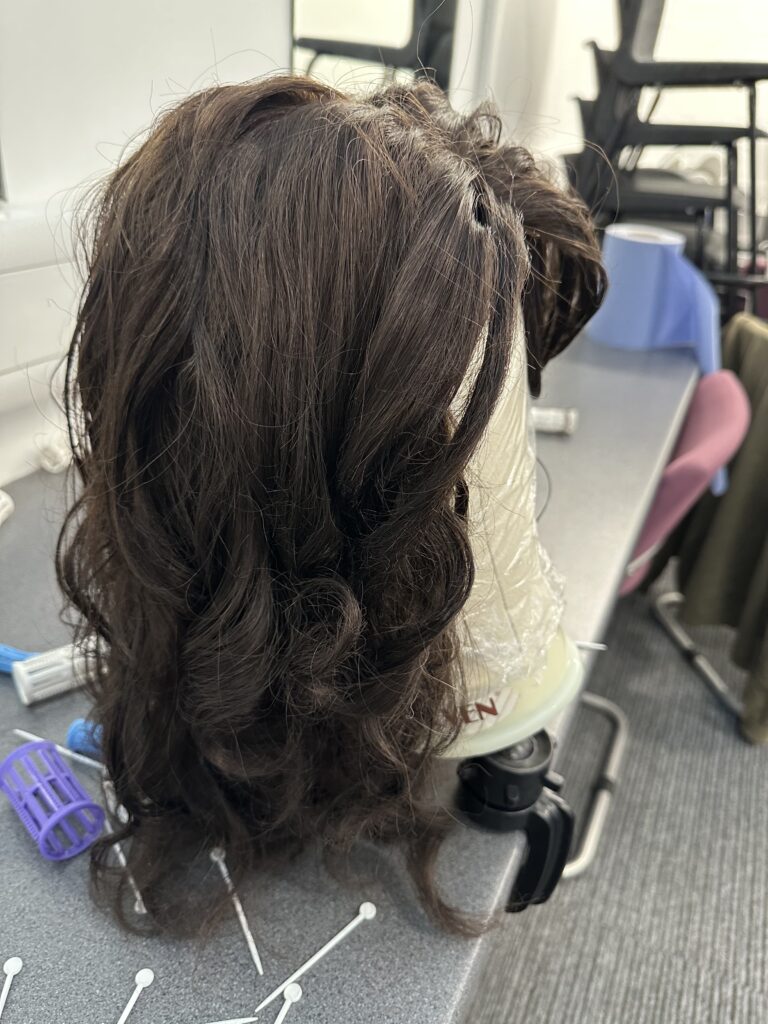

Worked on Digital Space to catch up on theory. had one to one with Sara.
More practice on Wigs curling methods with Jazmin.
Tutor-Feed back
Jazmin suggested that to create volume to roots I should role the bandy rollers outer/under side. and use small rollers around the face to create tight curls.
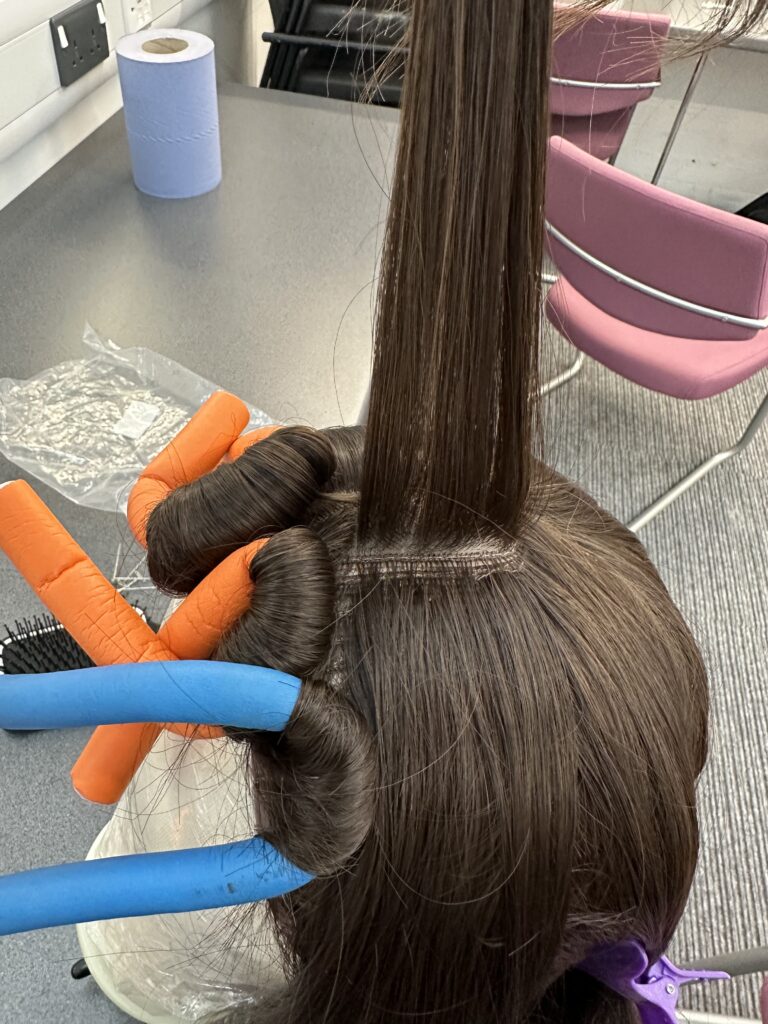
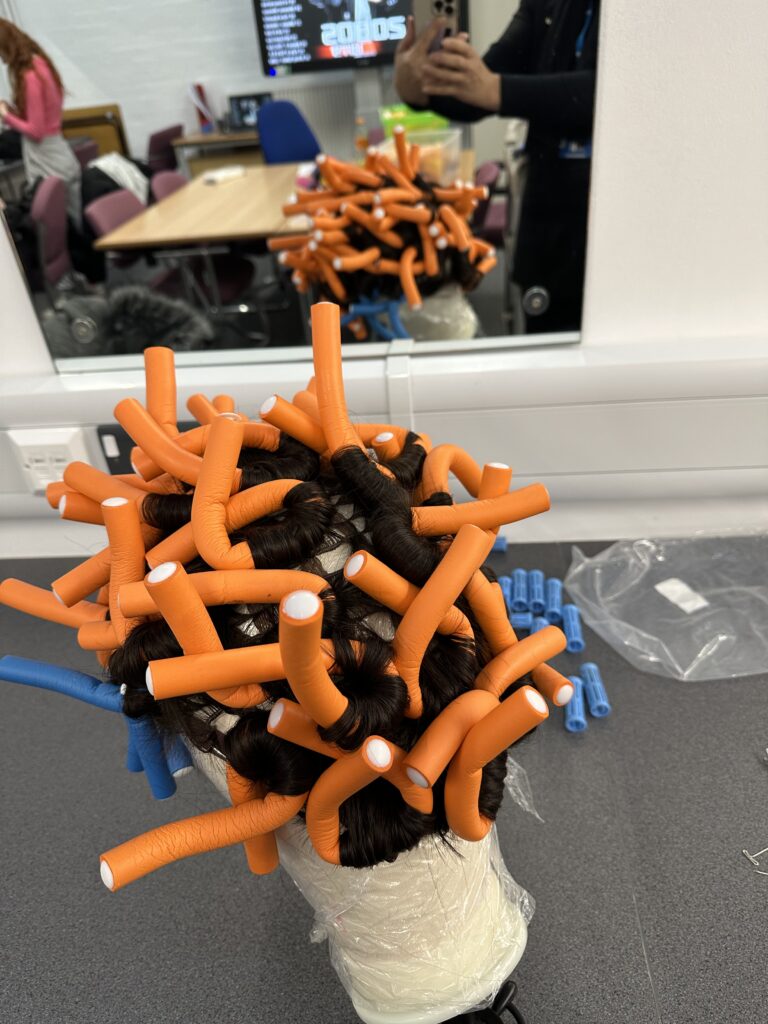
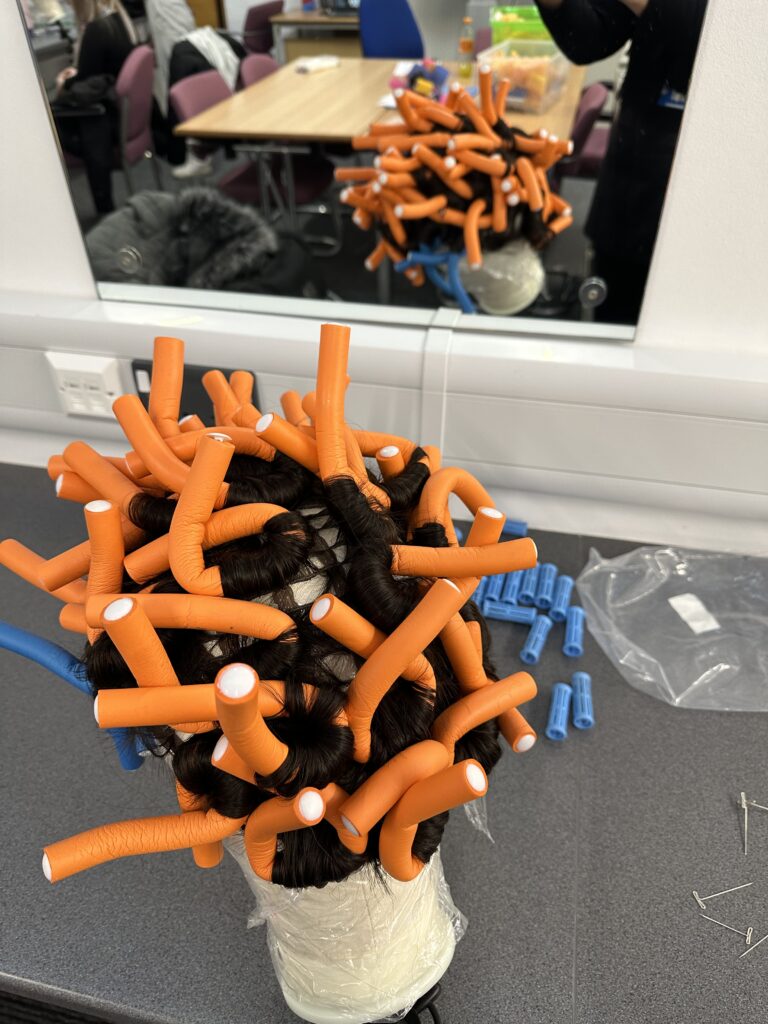
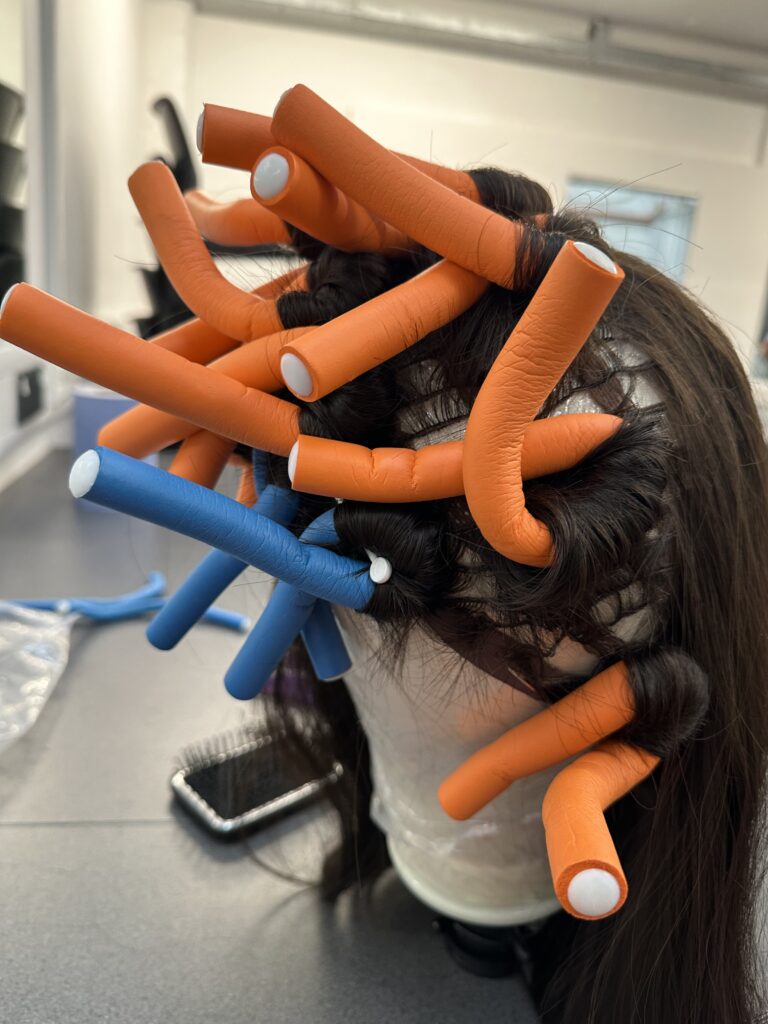
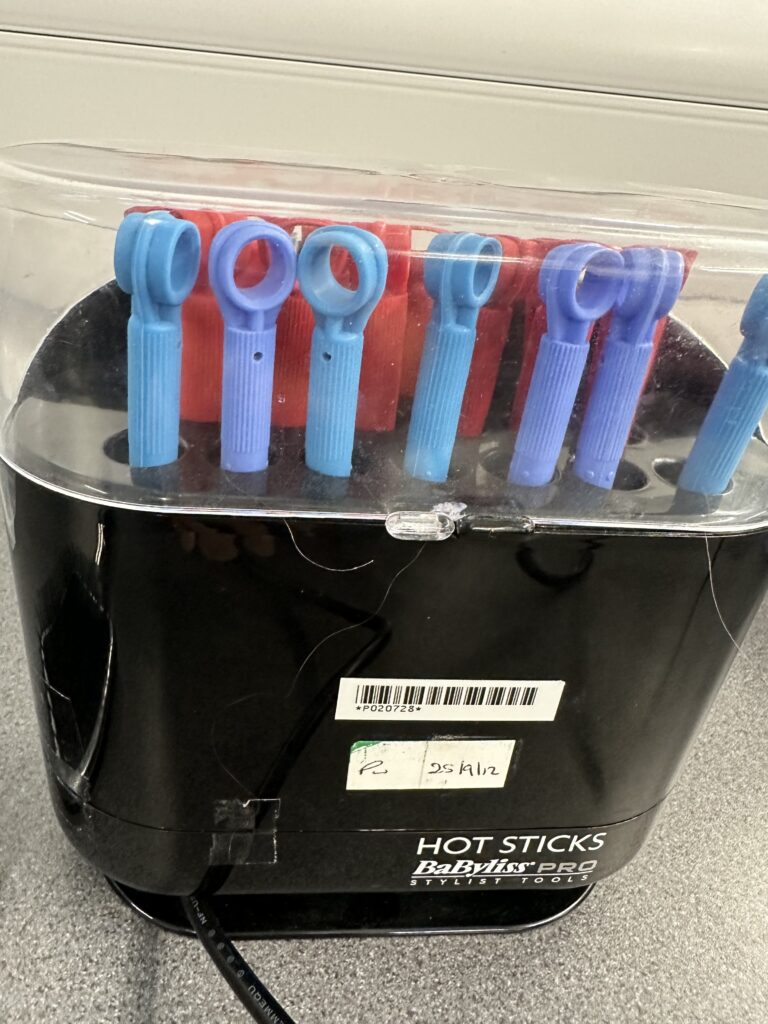


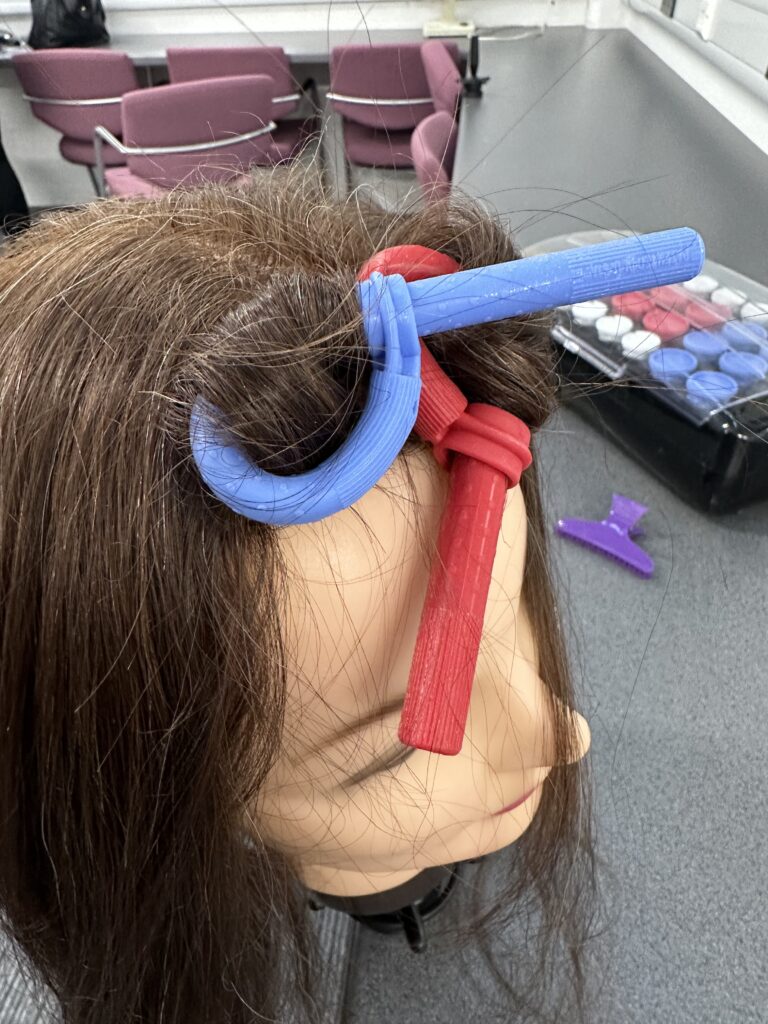

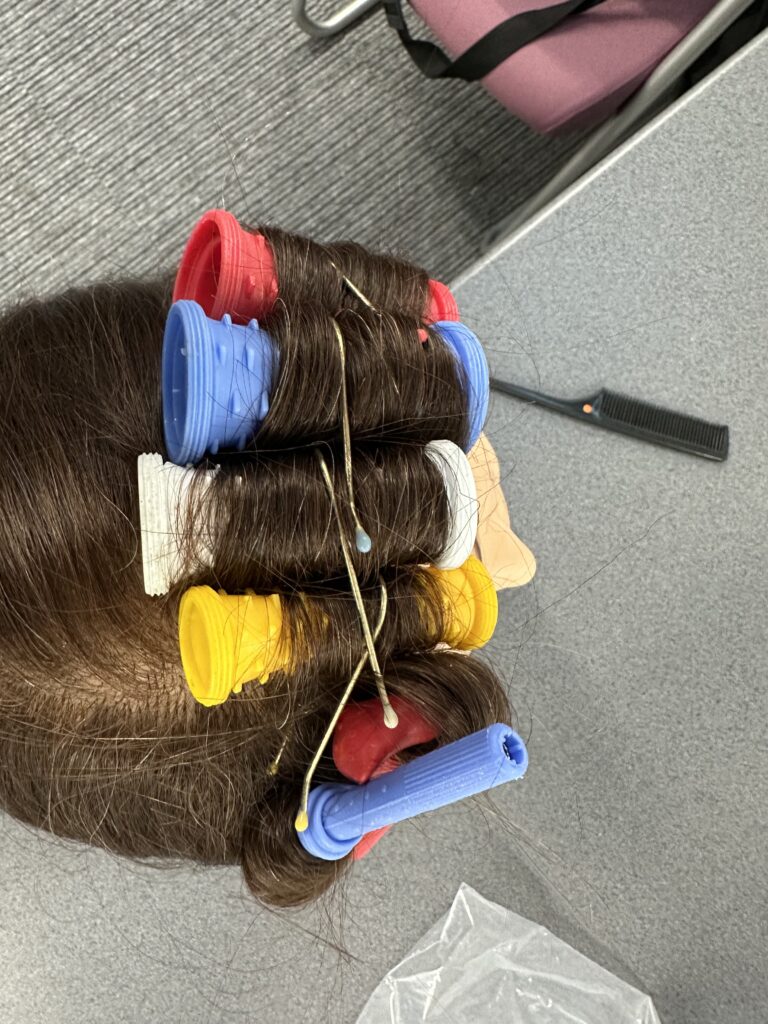
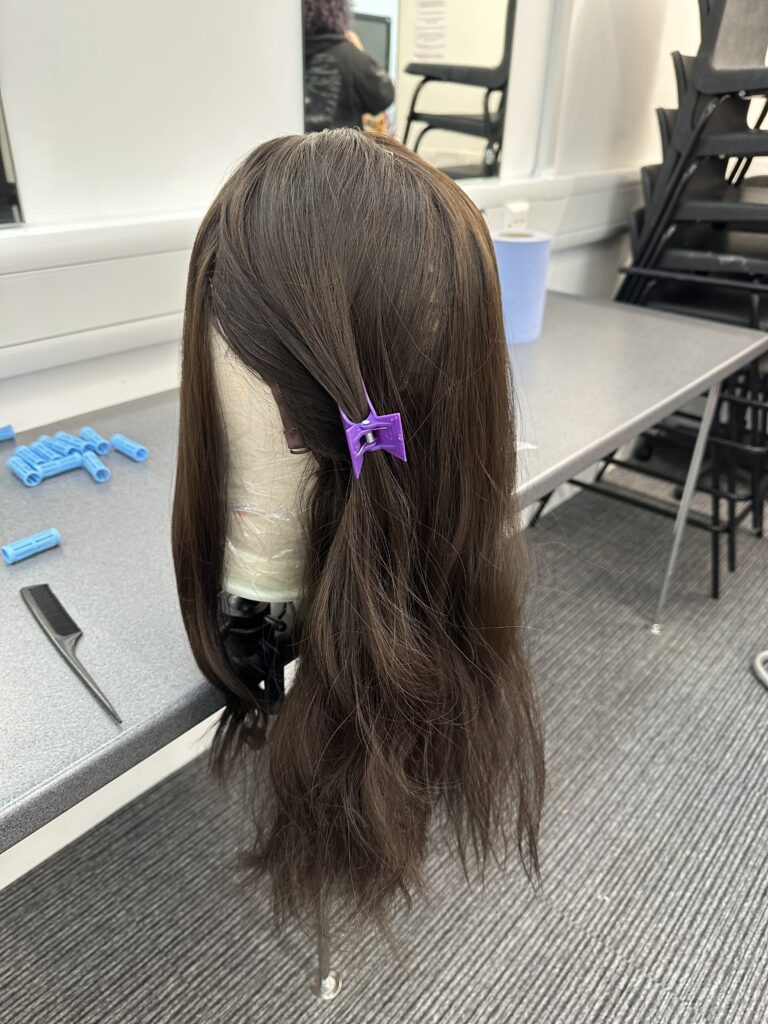
Watched a video on theatre makeup.
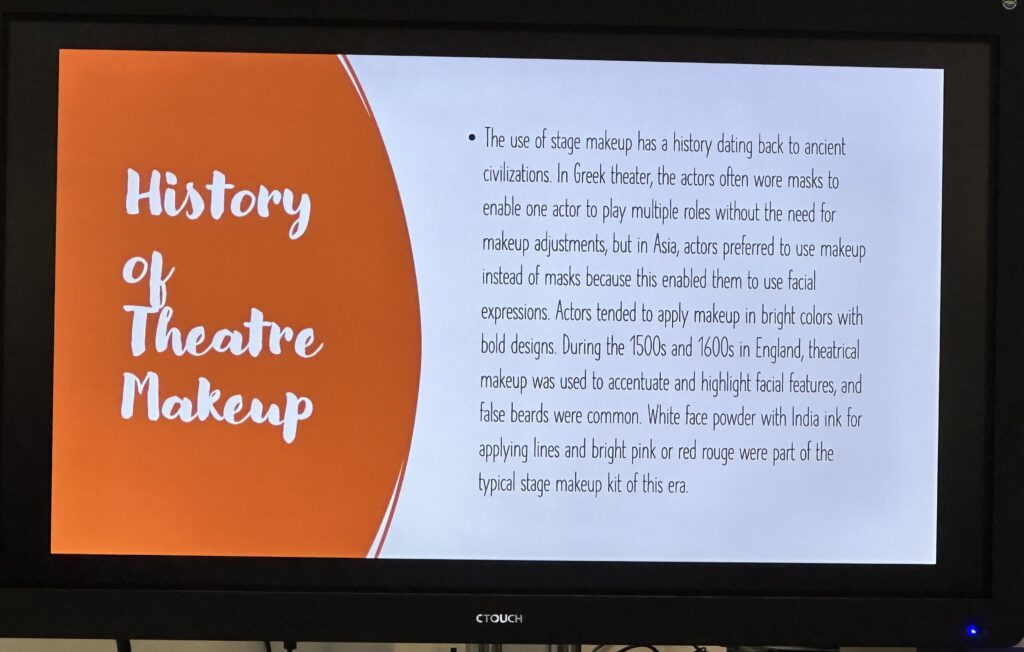
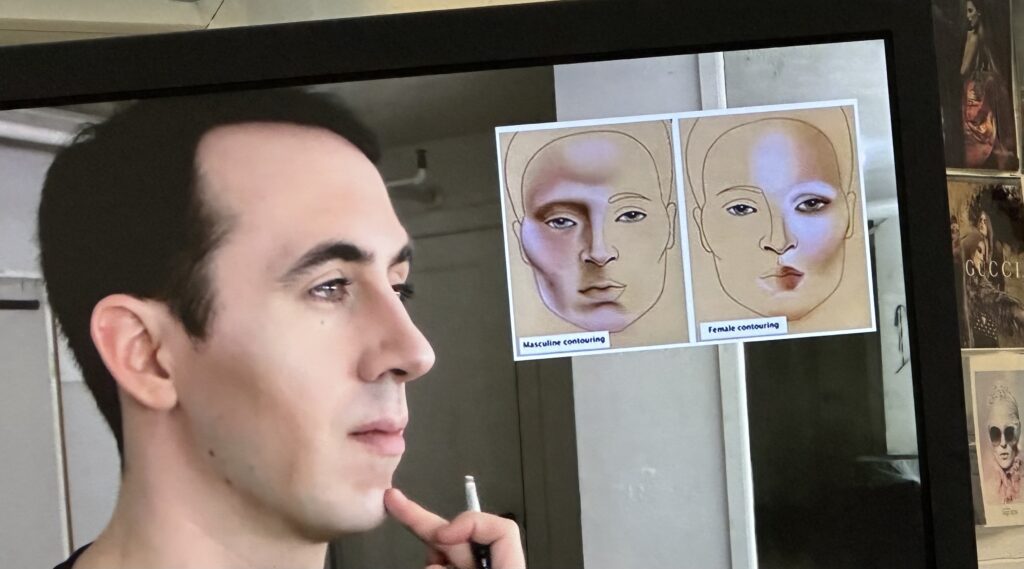
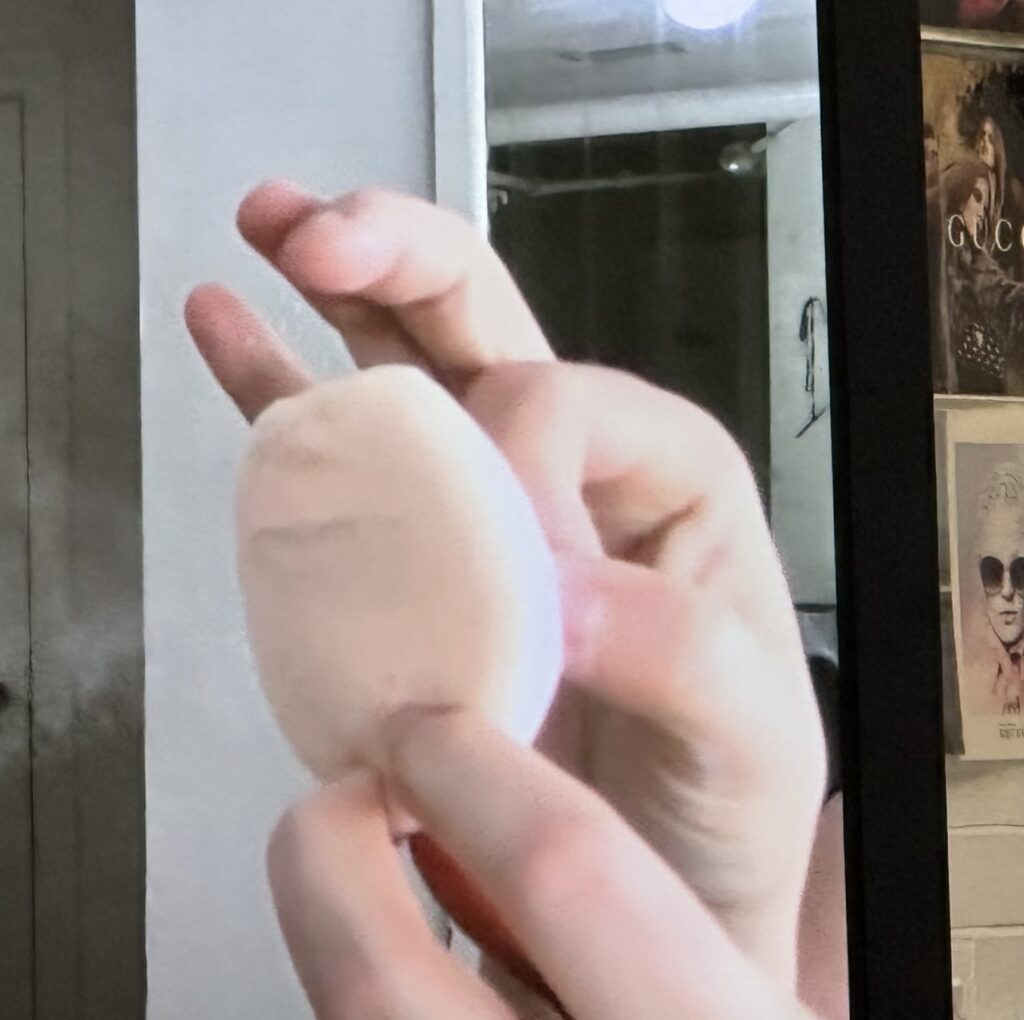

Makeup practice of Victorian Era, theatre style, thick base using foundation stick, contour forehead, nose and under chin, setting with loose powder, used peach/pink blush on cheeks and eye lids, dark brown cream base for slightly tint eyebrows, lined eye lids and lip outline then coloured lips in using peach cream base.
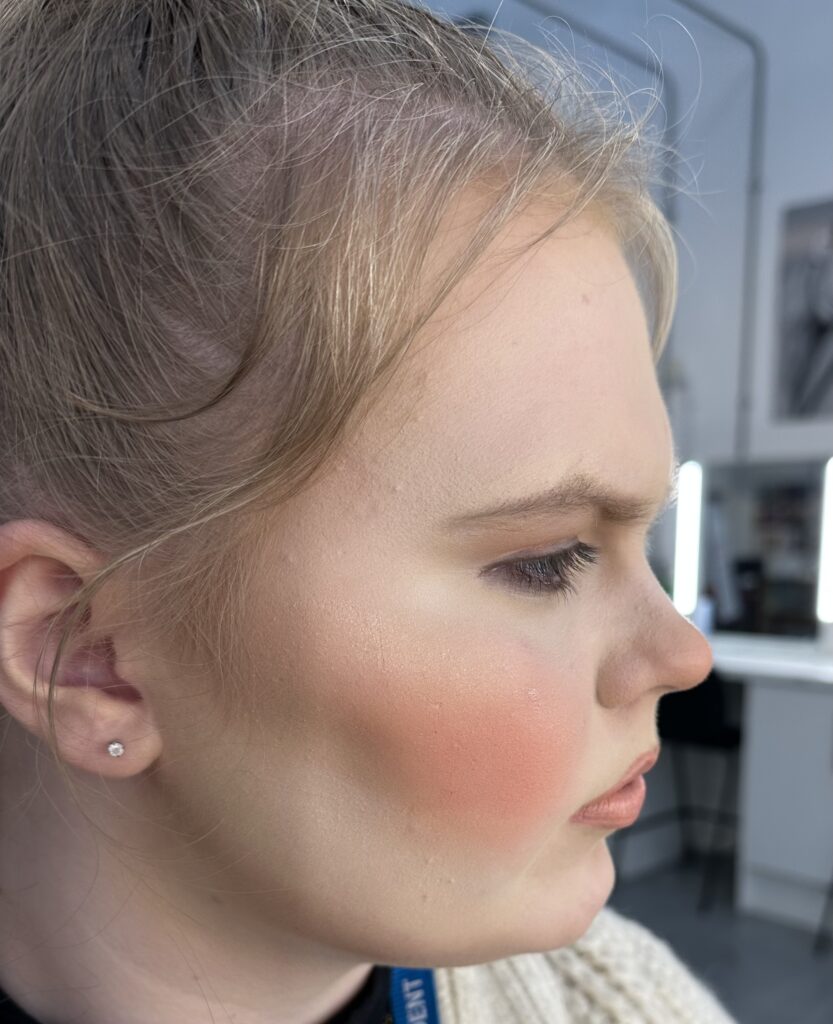



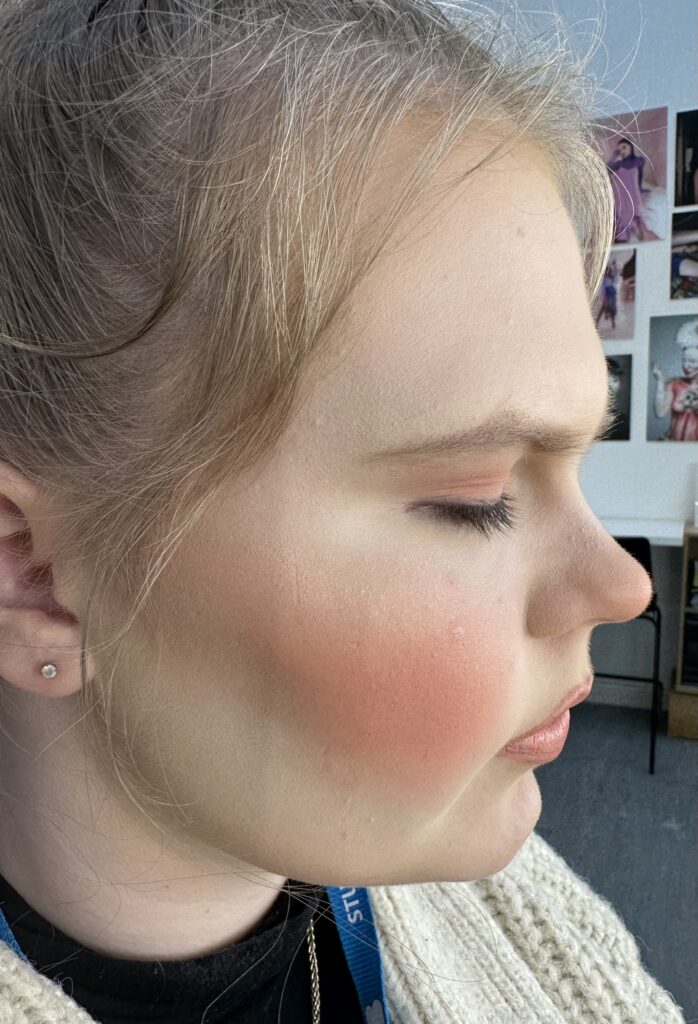


Tutor-Feed Back
Luci liked my paint stick blending and contouring, suggested that I should contour lower sides of forehead around the temples, and apply white eyeliner to widen the eyes look. This I will try my best to put in practice for the next look.
Under theatre lights makeup effects
looked at the makeup under different theatre lights to see what effects are seen. now its a little clear that under red light everything just looks red, under white light it hits the high areas of the face and blue light gives best results of the shades used.

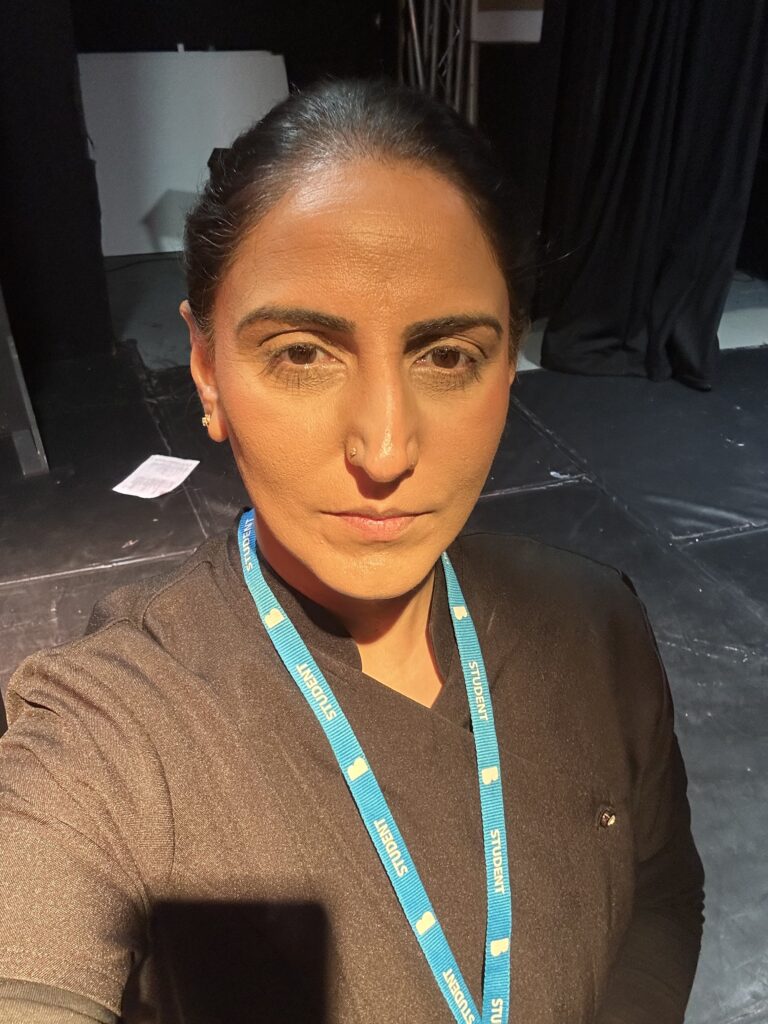
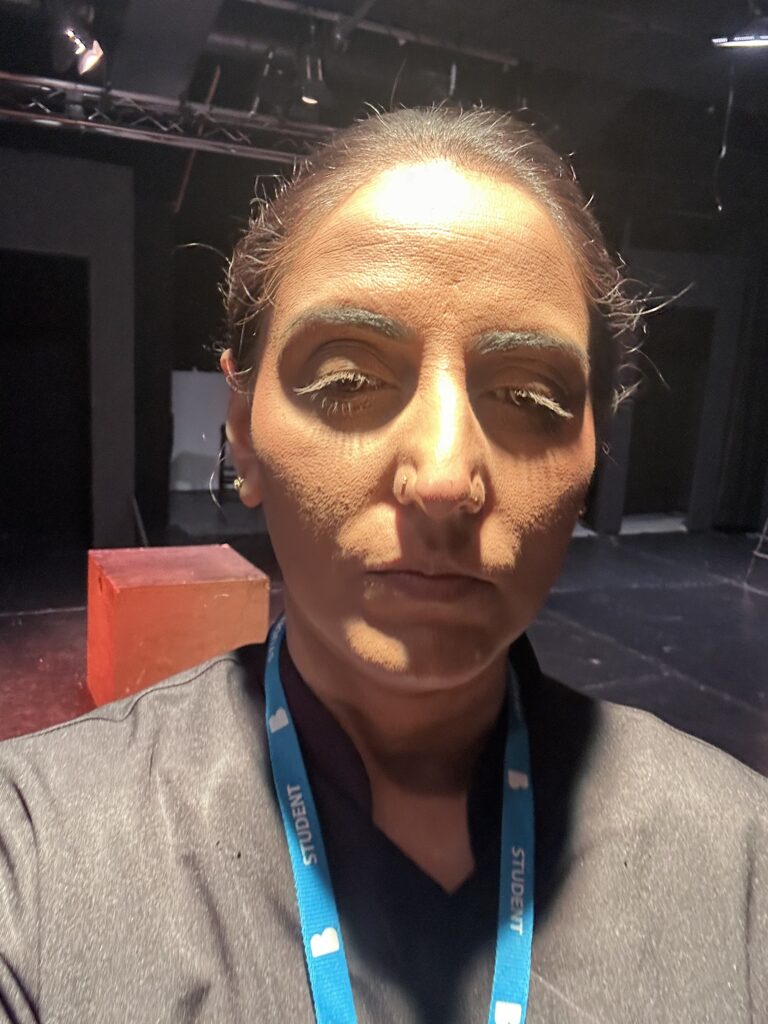
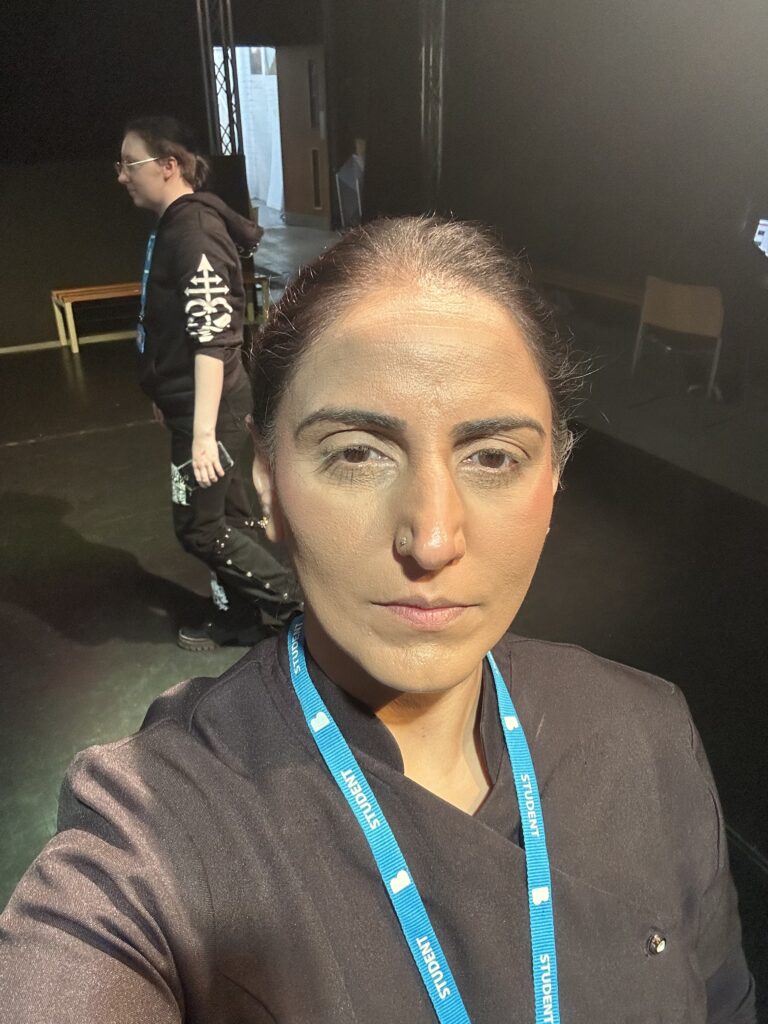

Prosthetic Event Images


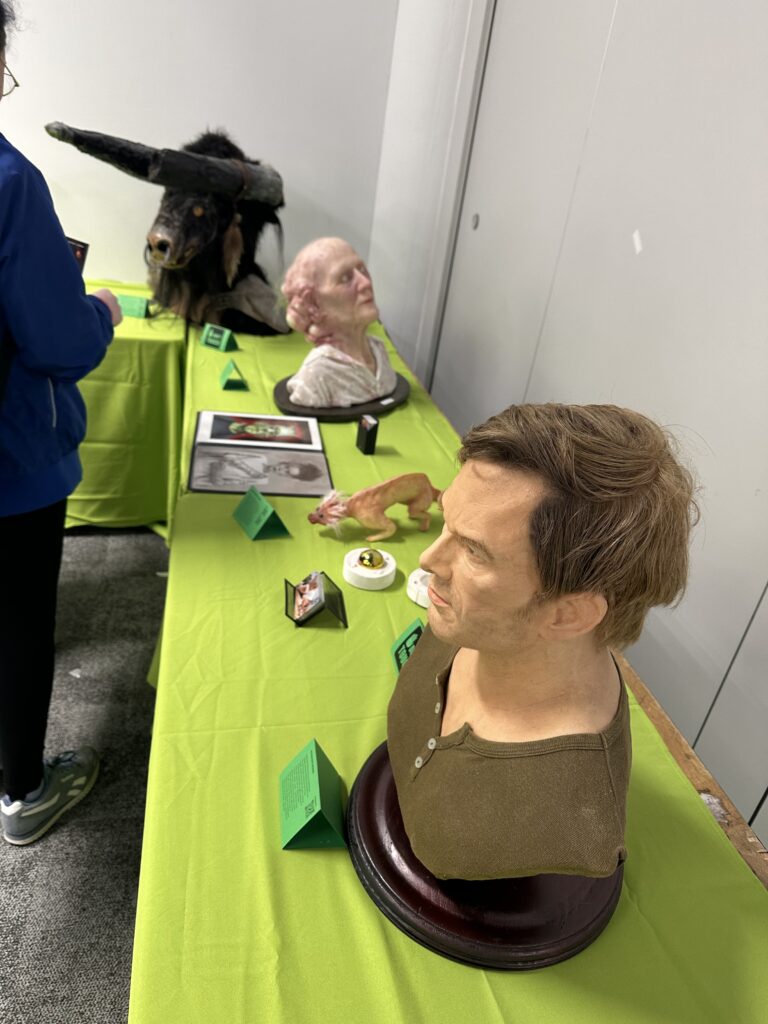
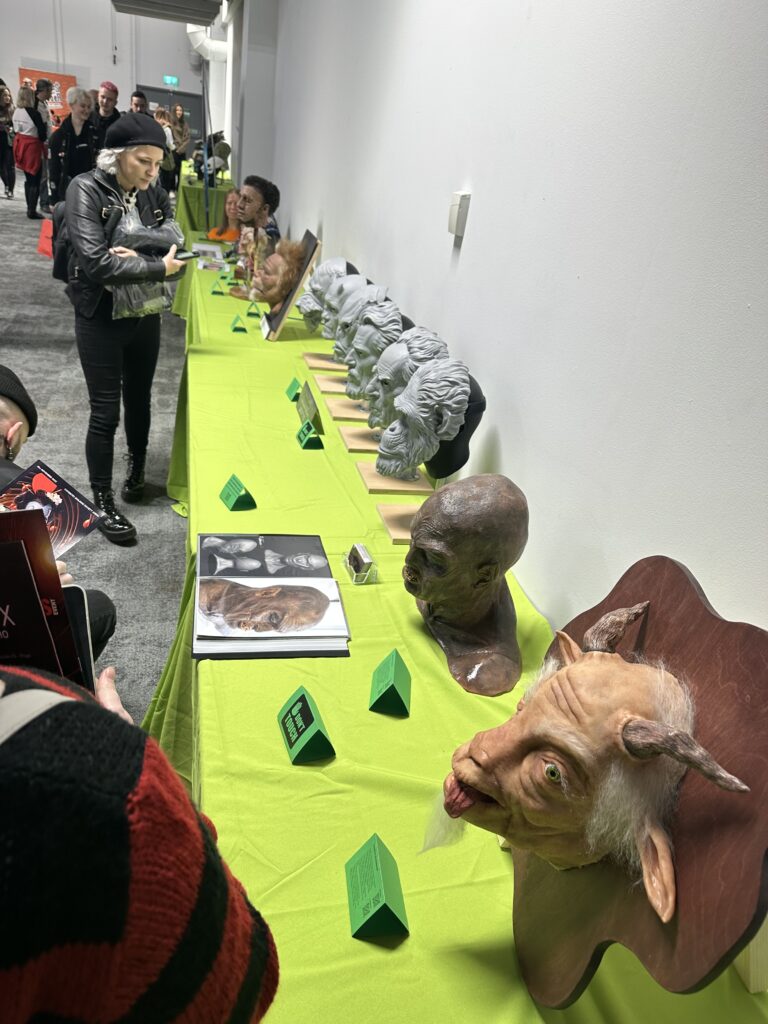
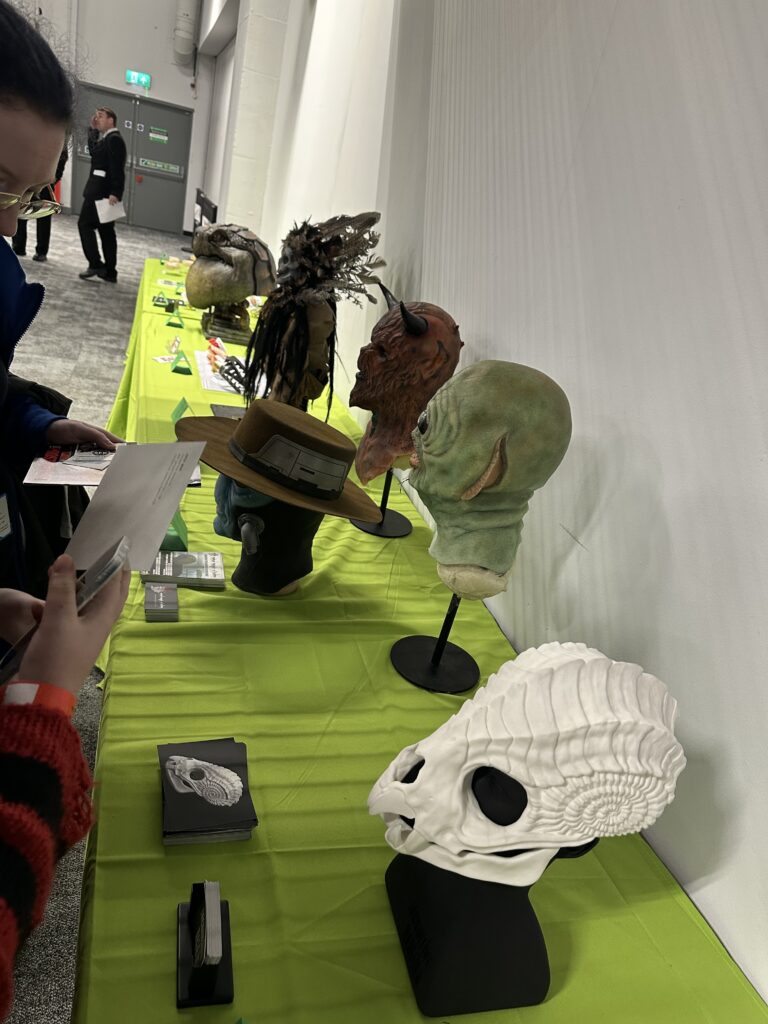
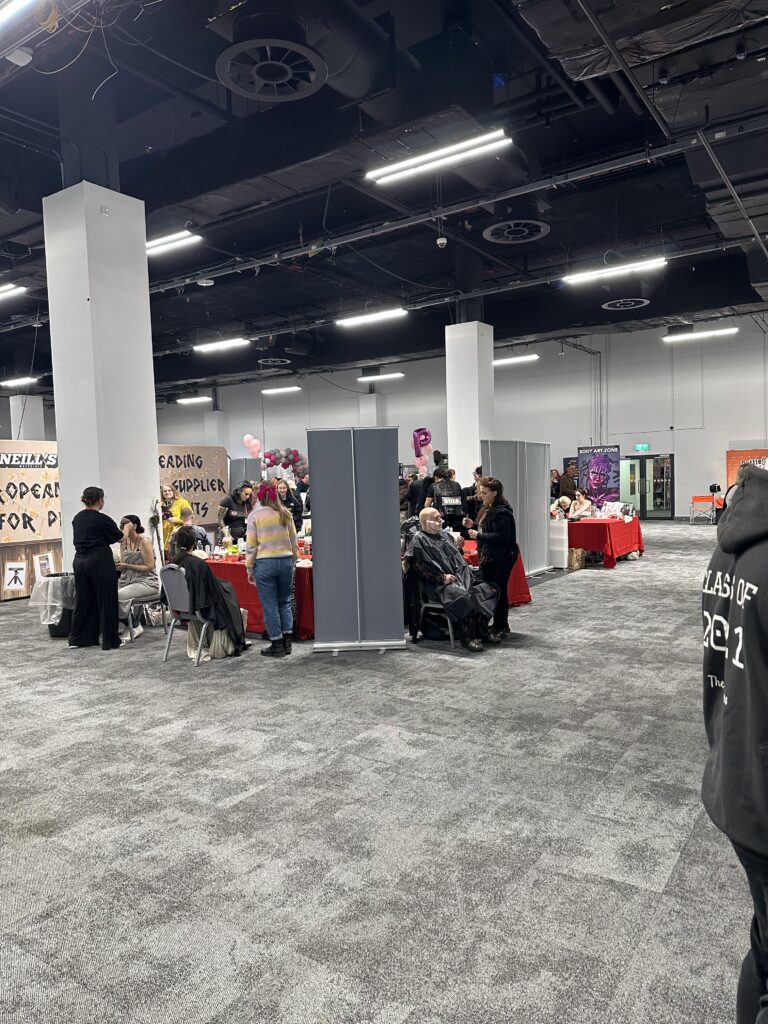

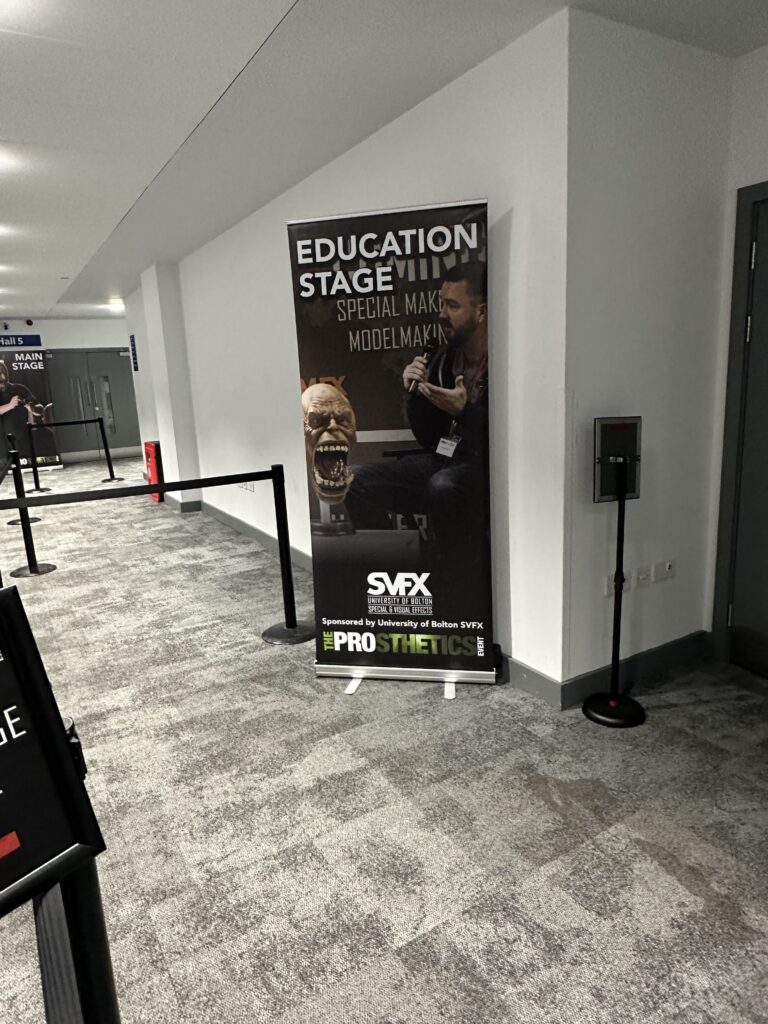
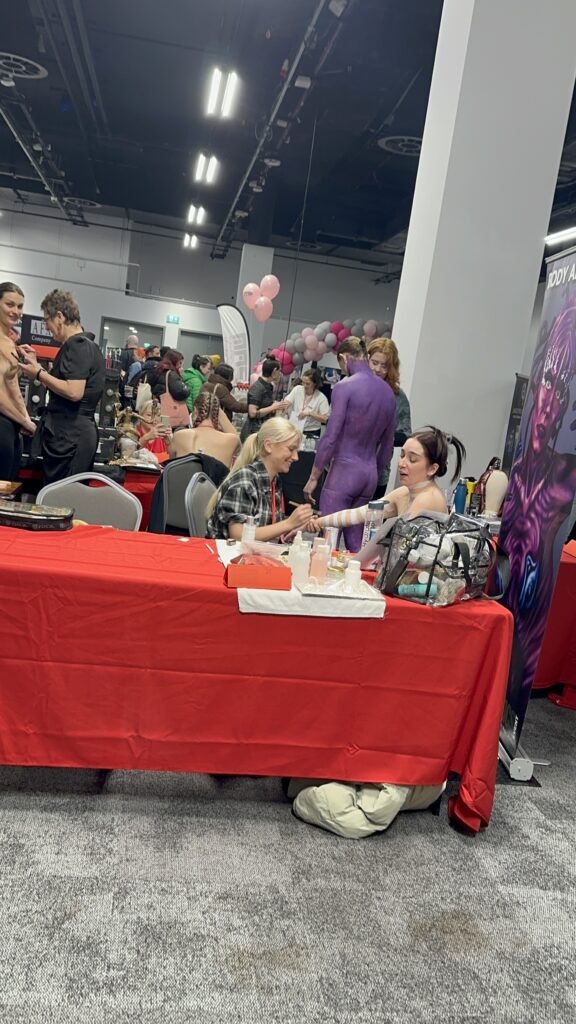
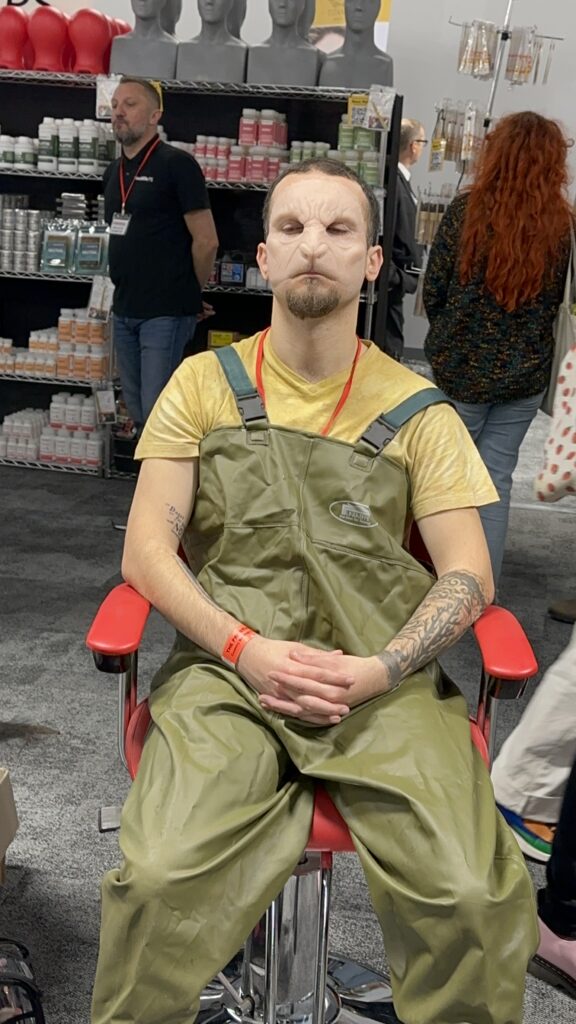

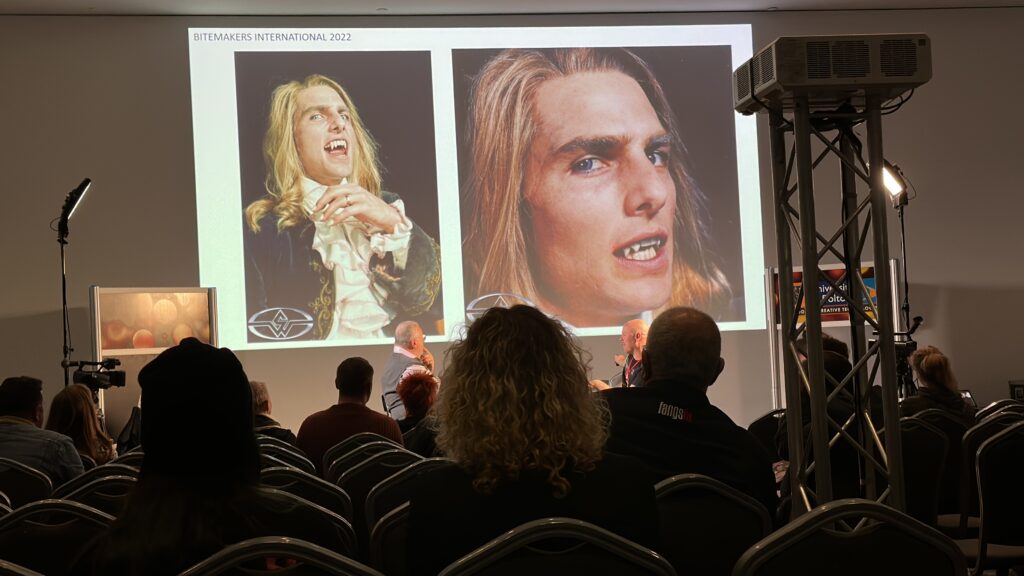
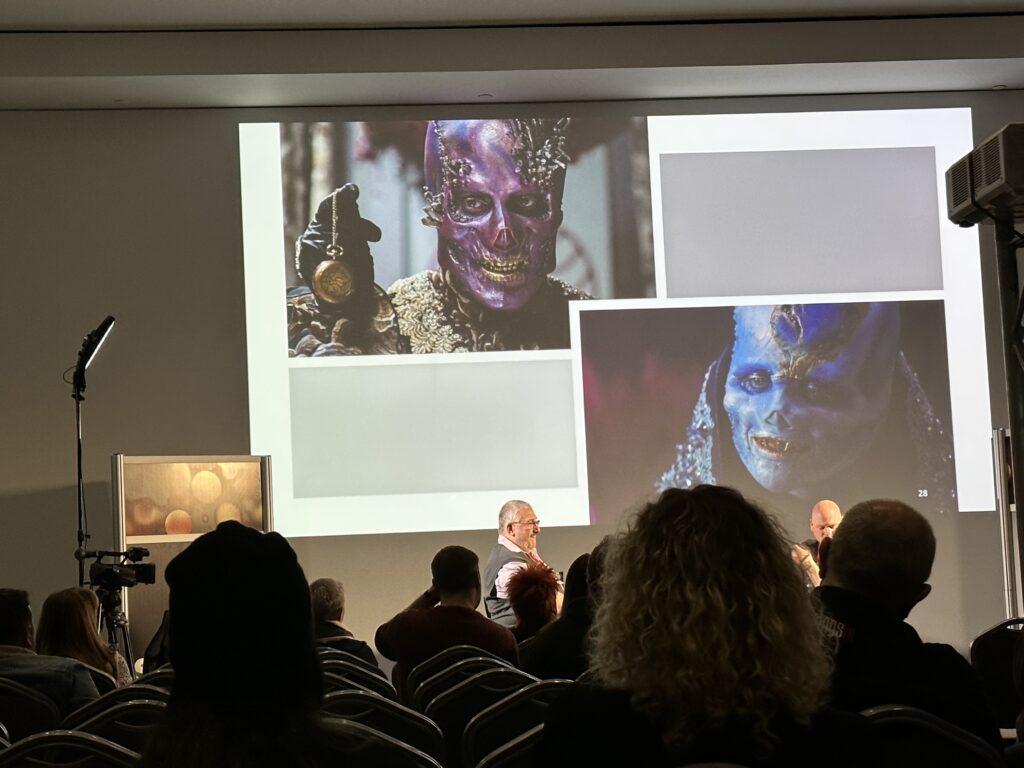
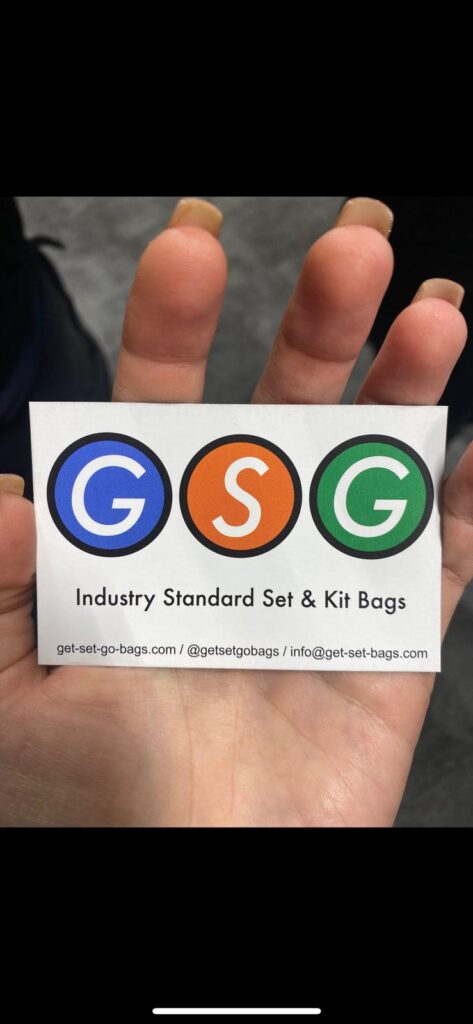

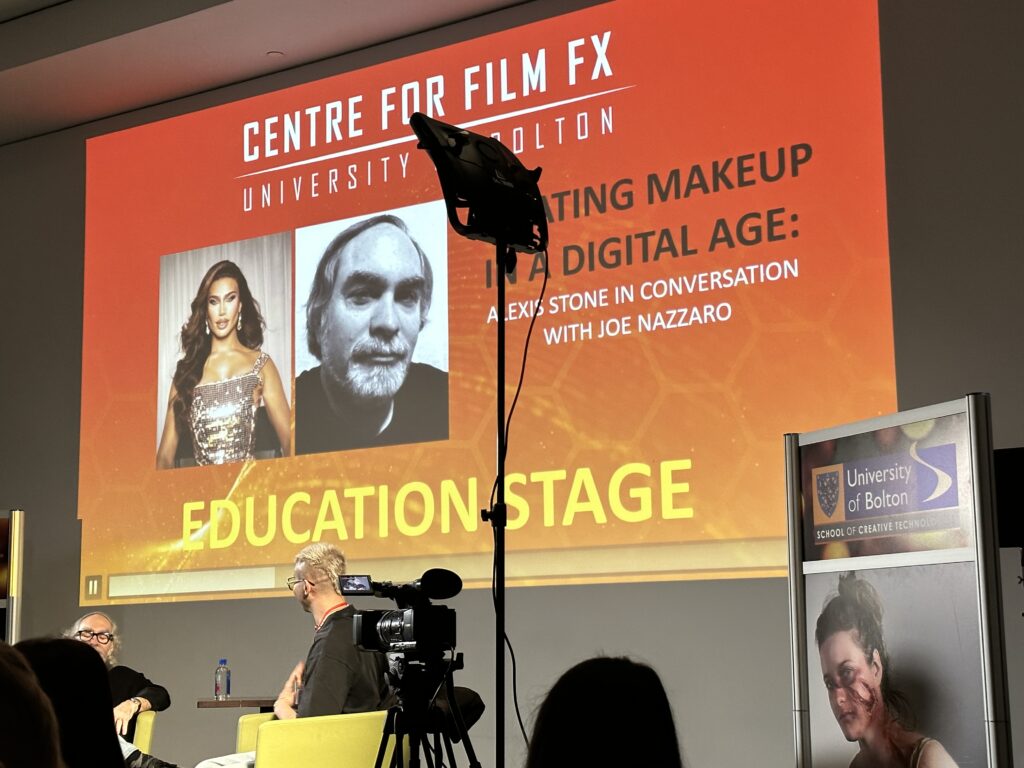
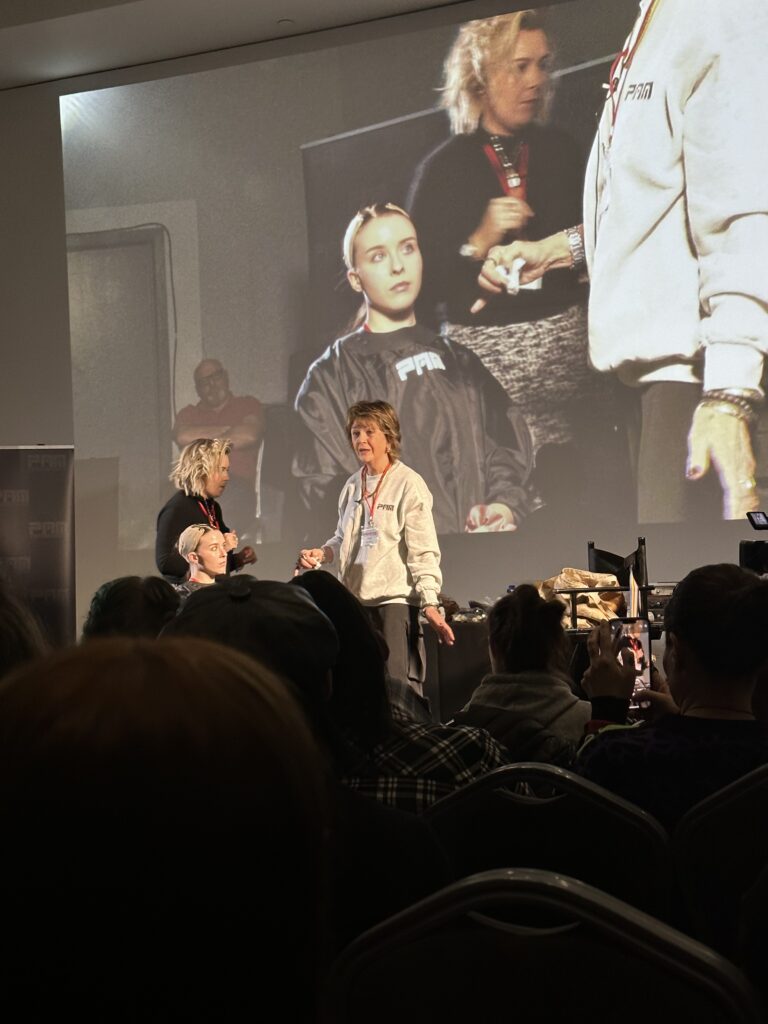
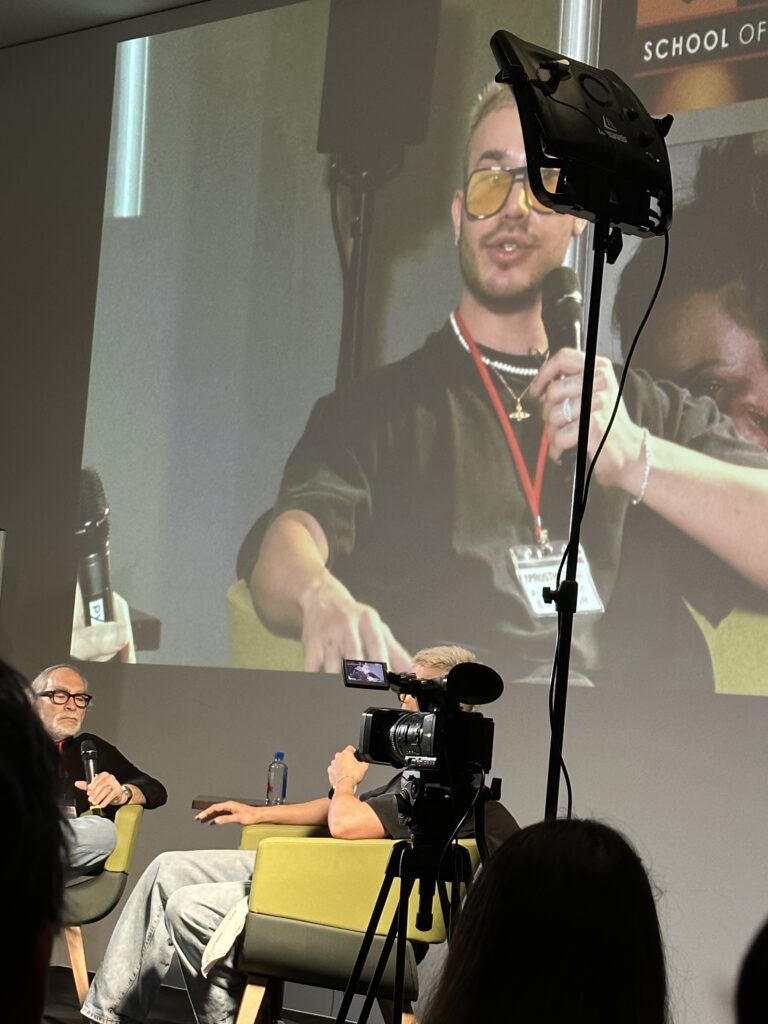


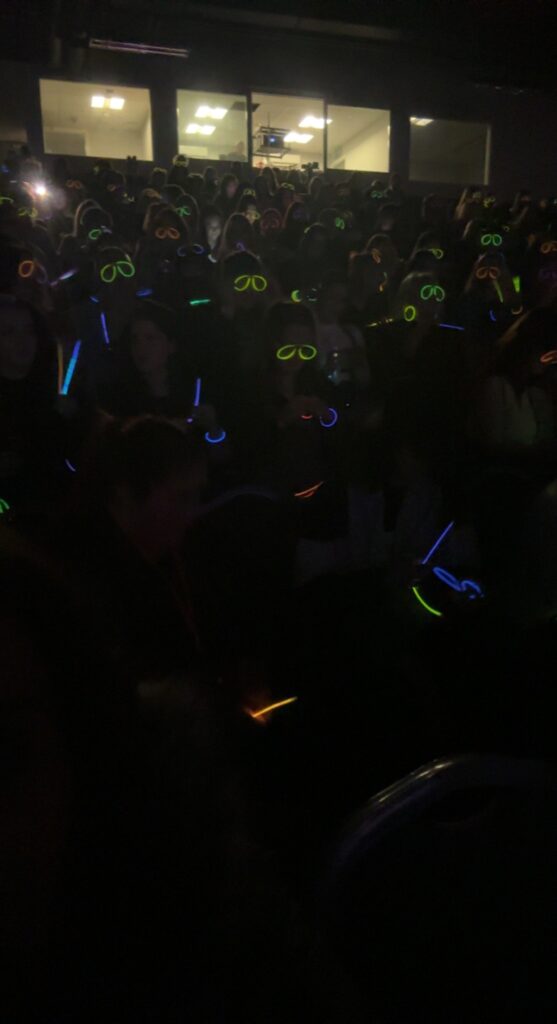
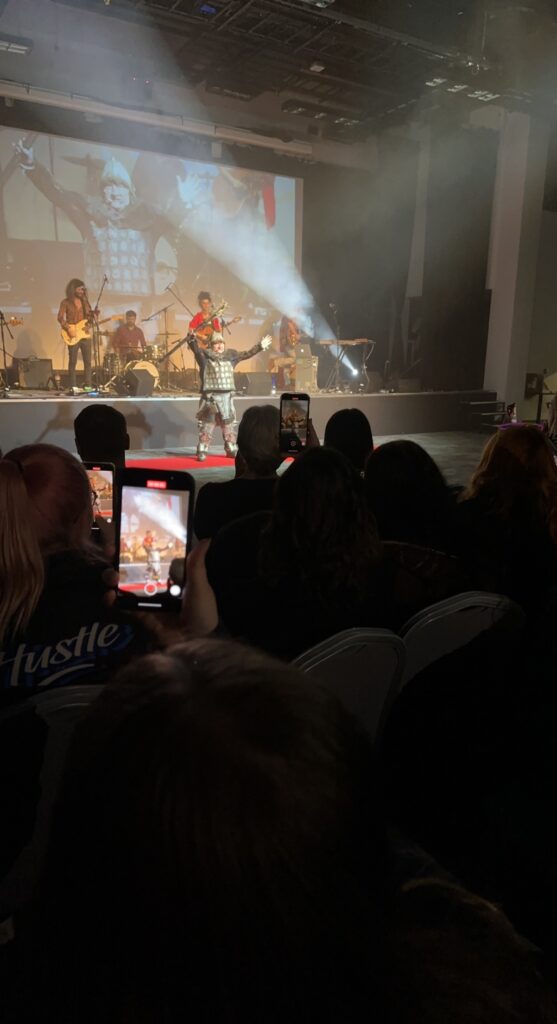
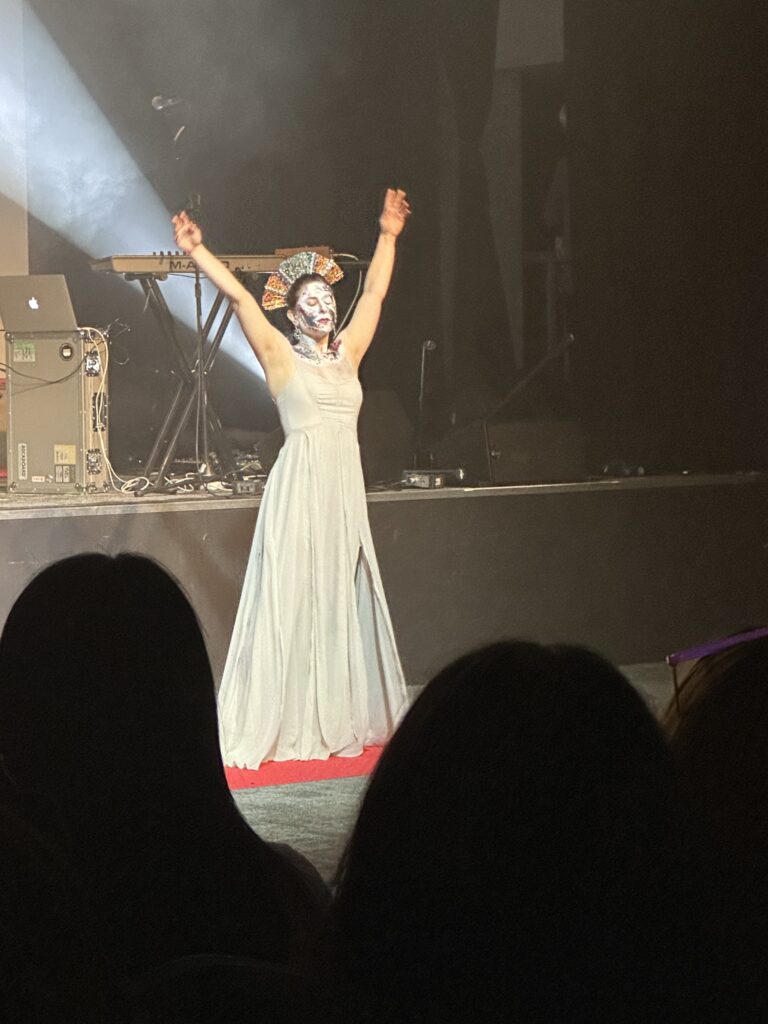
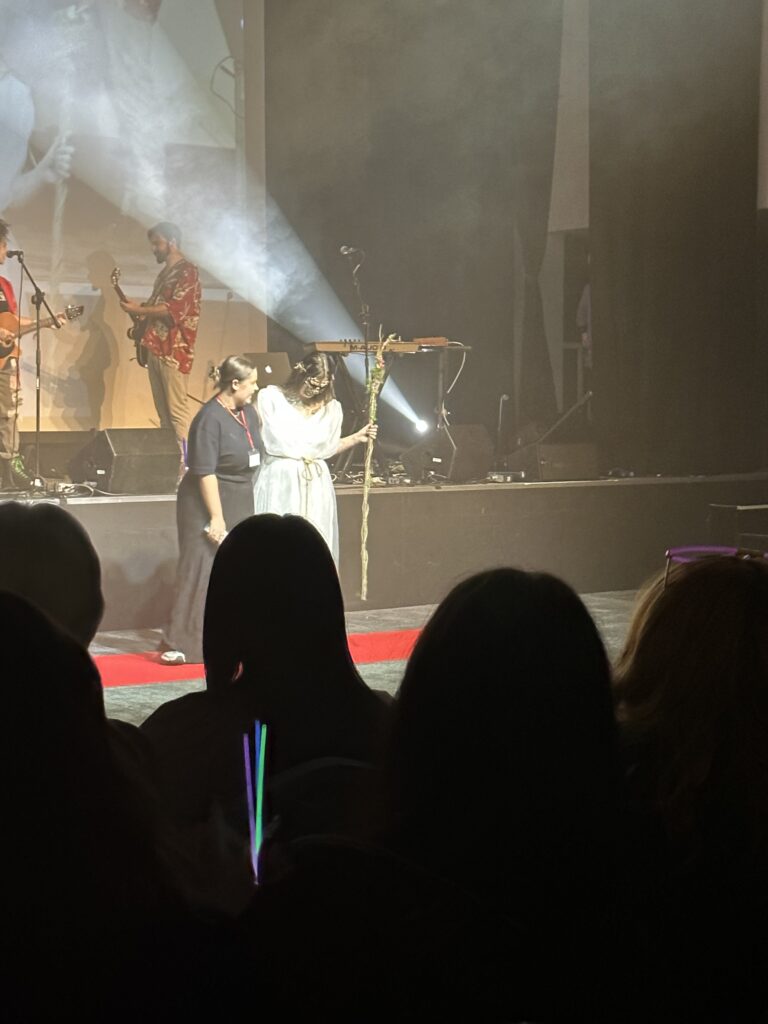
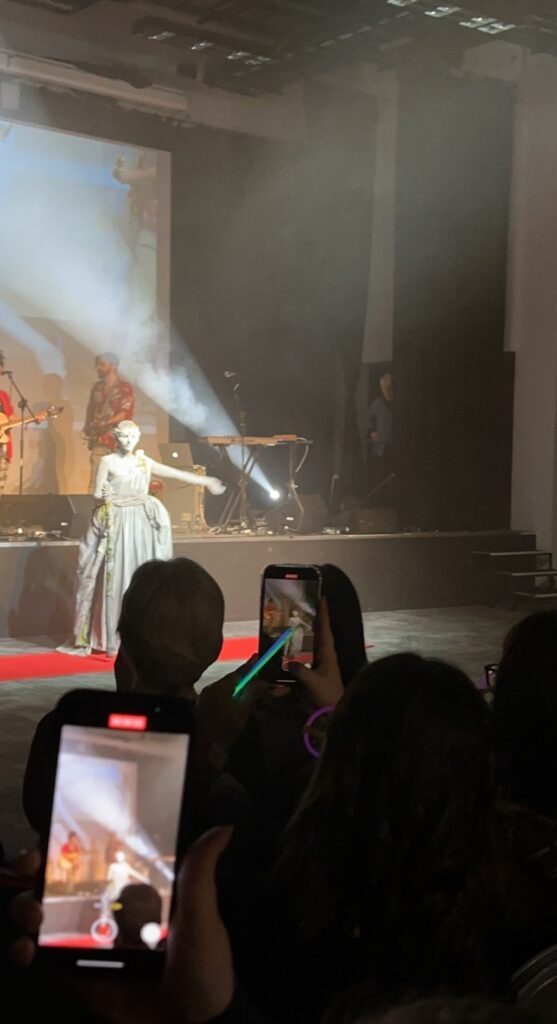


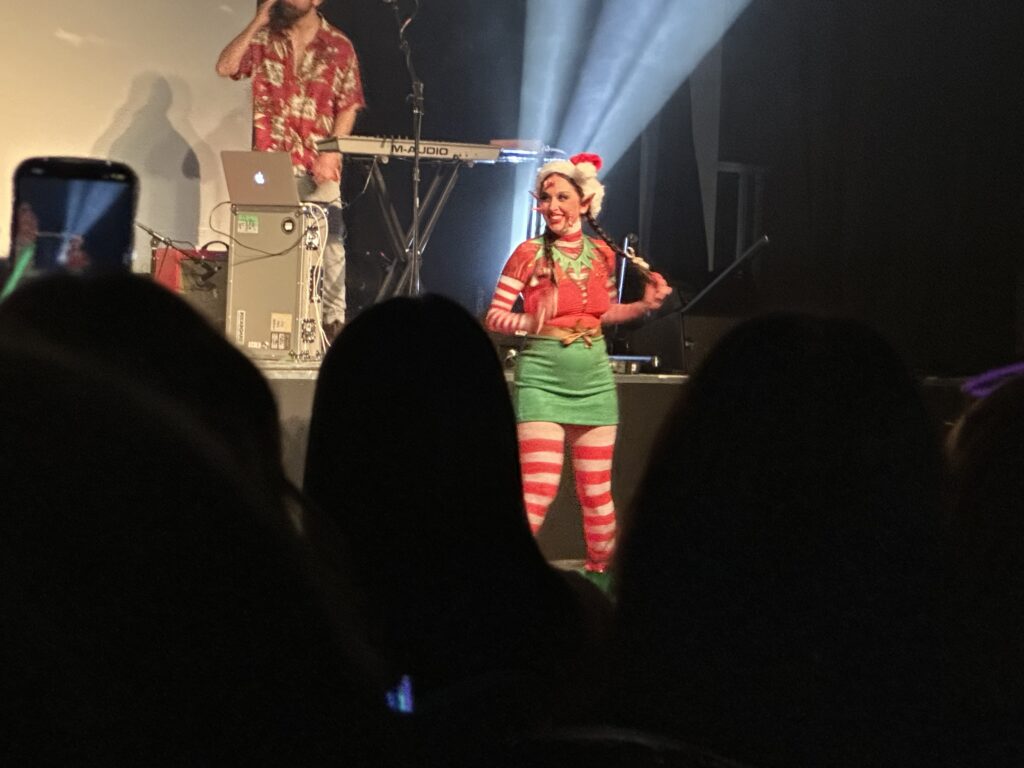
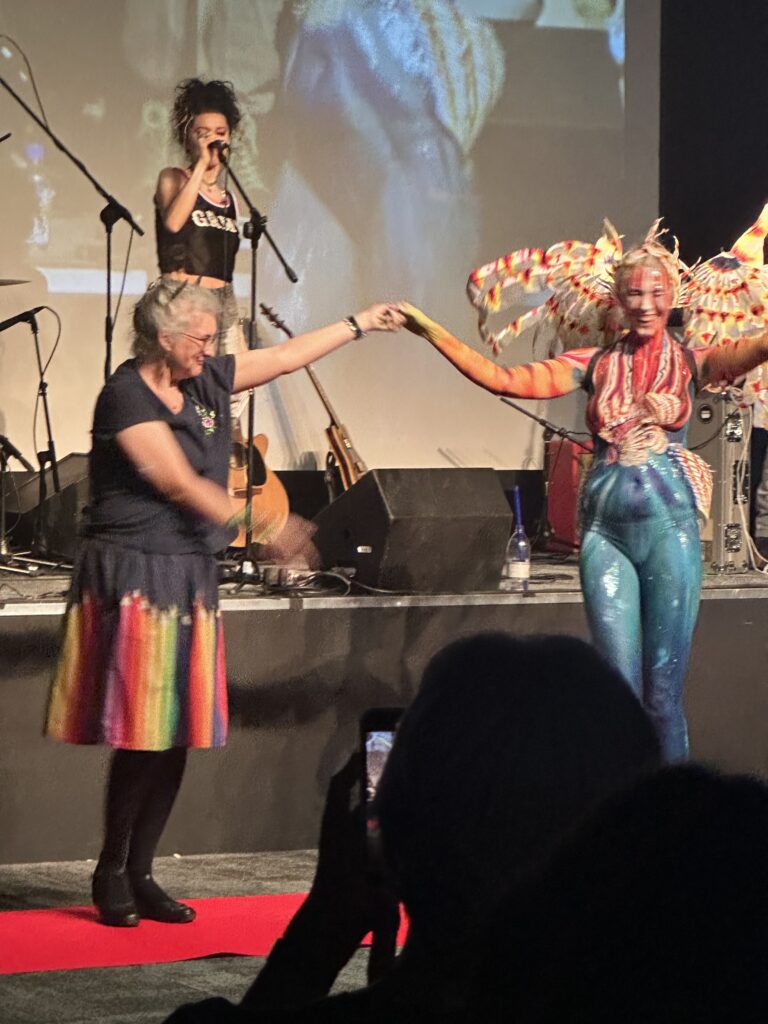


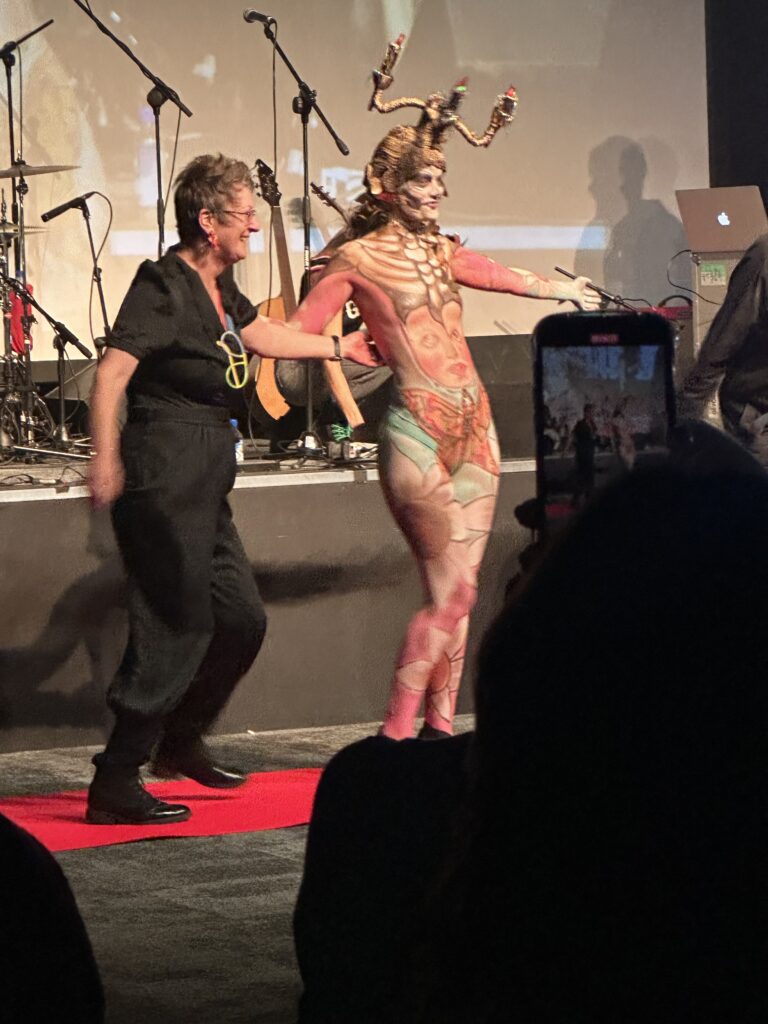

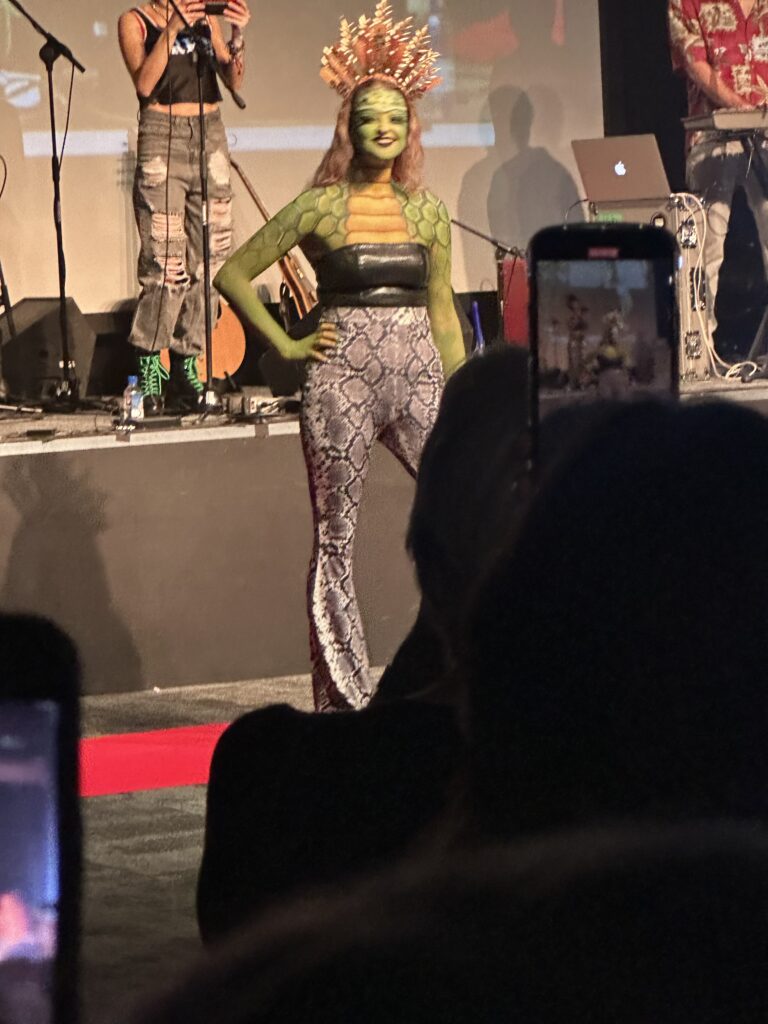
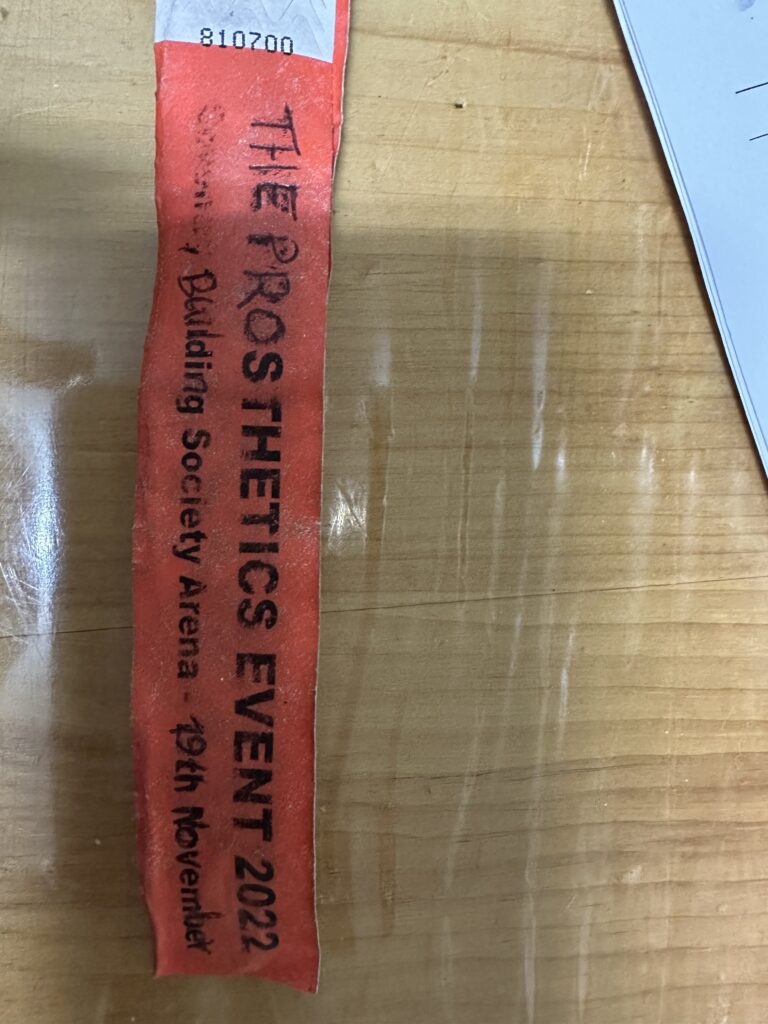
Week – 4
Carried out the patch tests on our in-house theatre performers this morning. And tried matching the foundation skin match, mix of G183 & FF7 from the grease paint pallette.
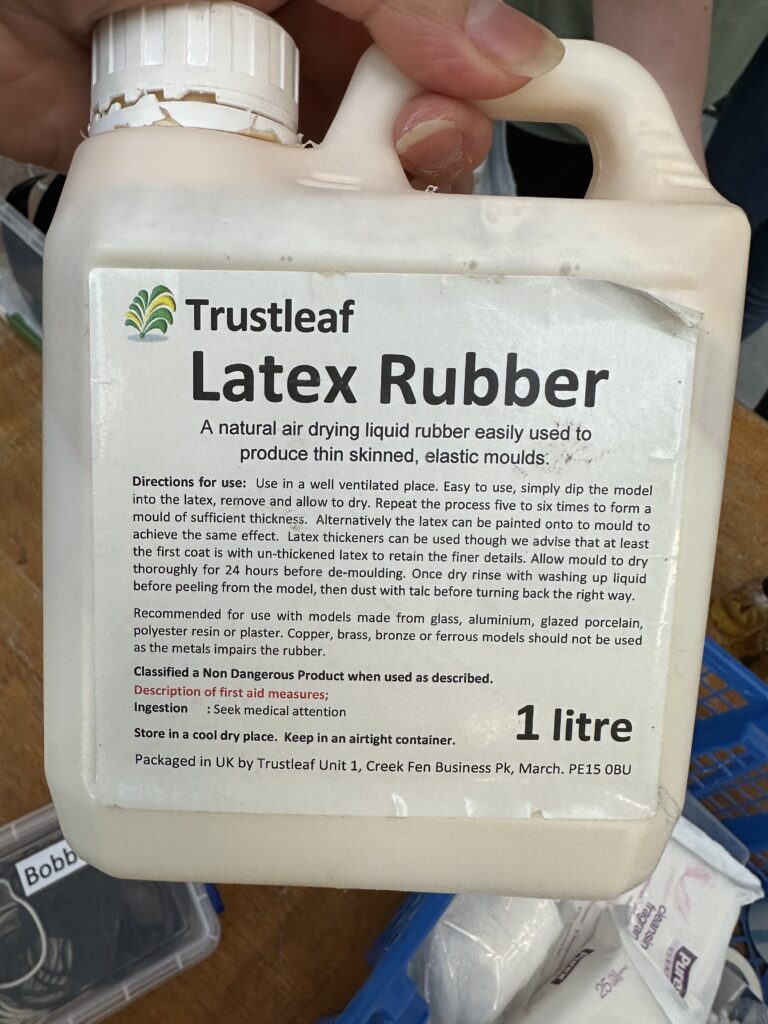

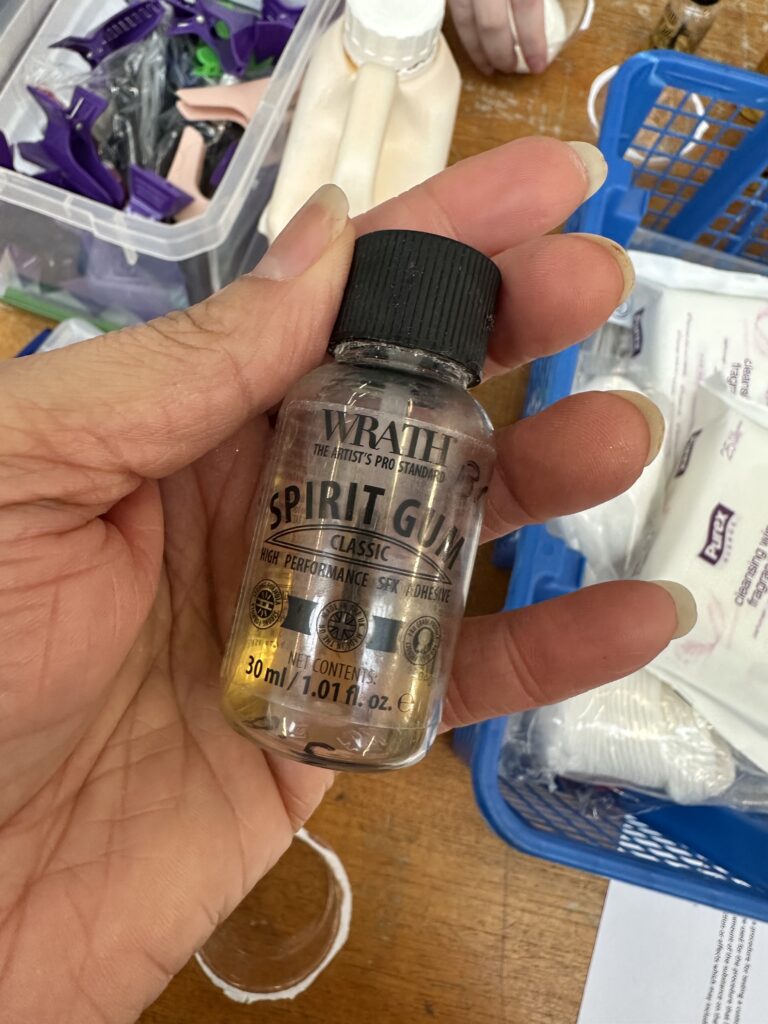
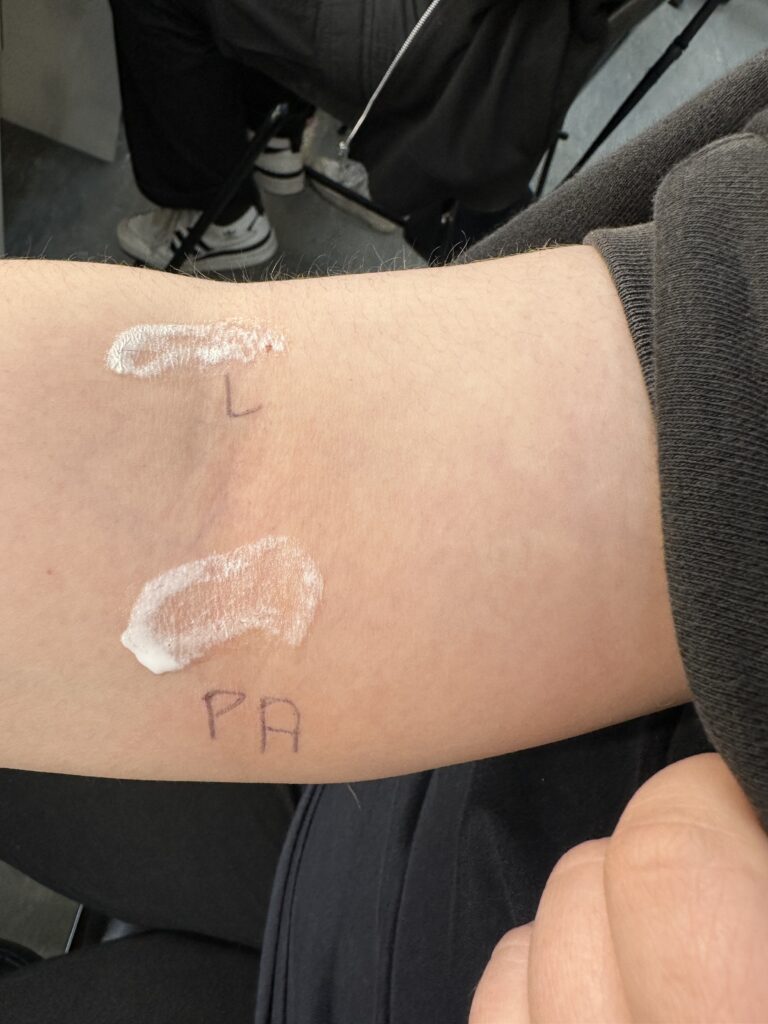
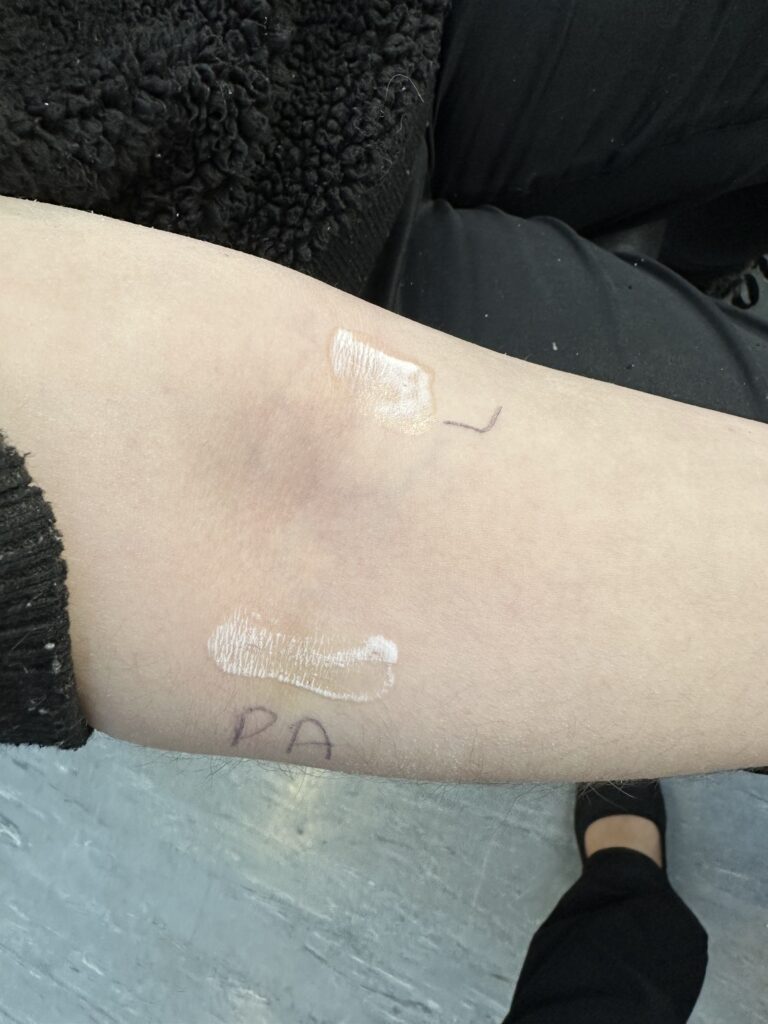
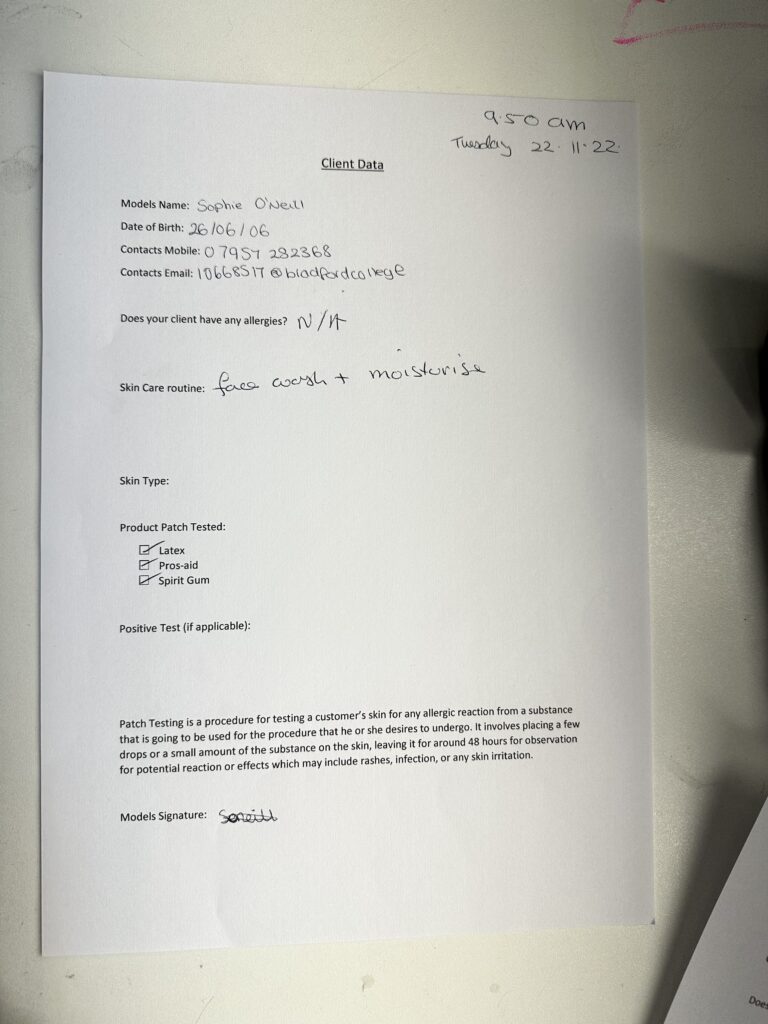
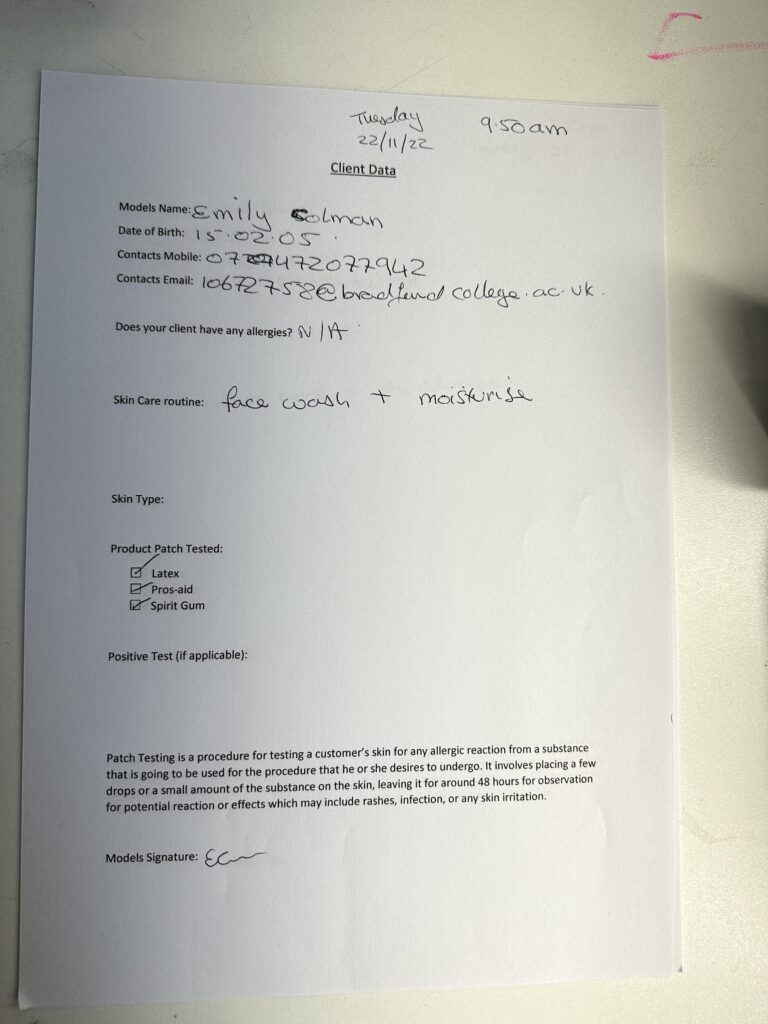
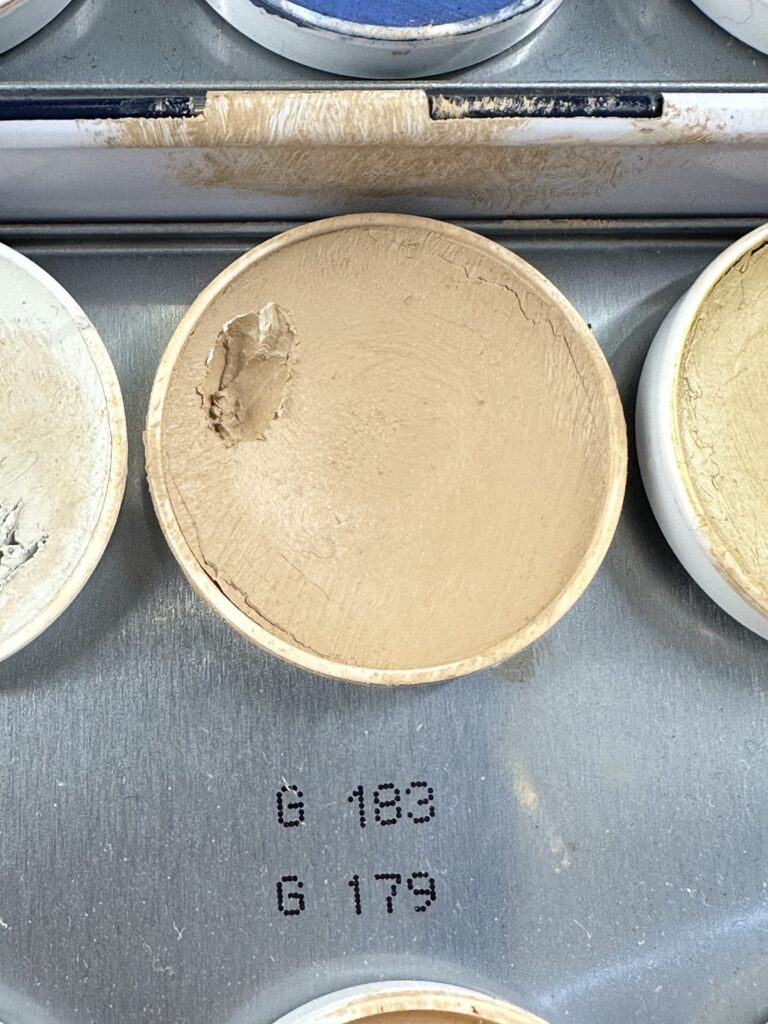
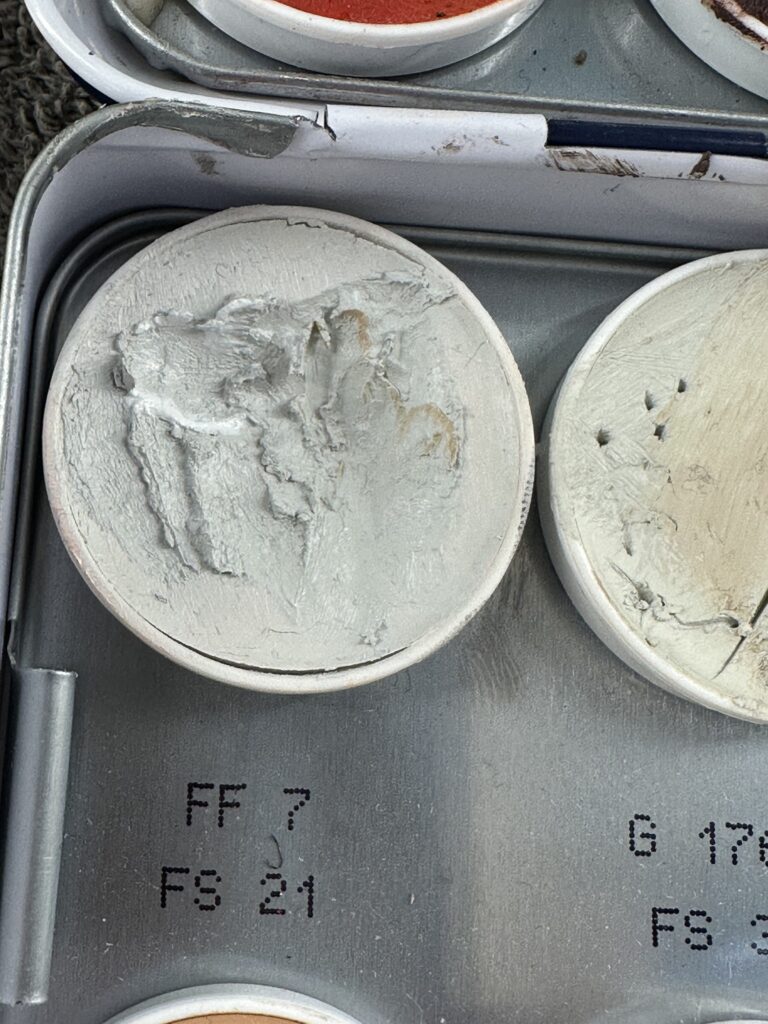
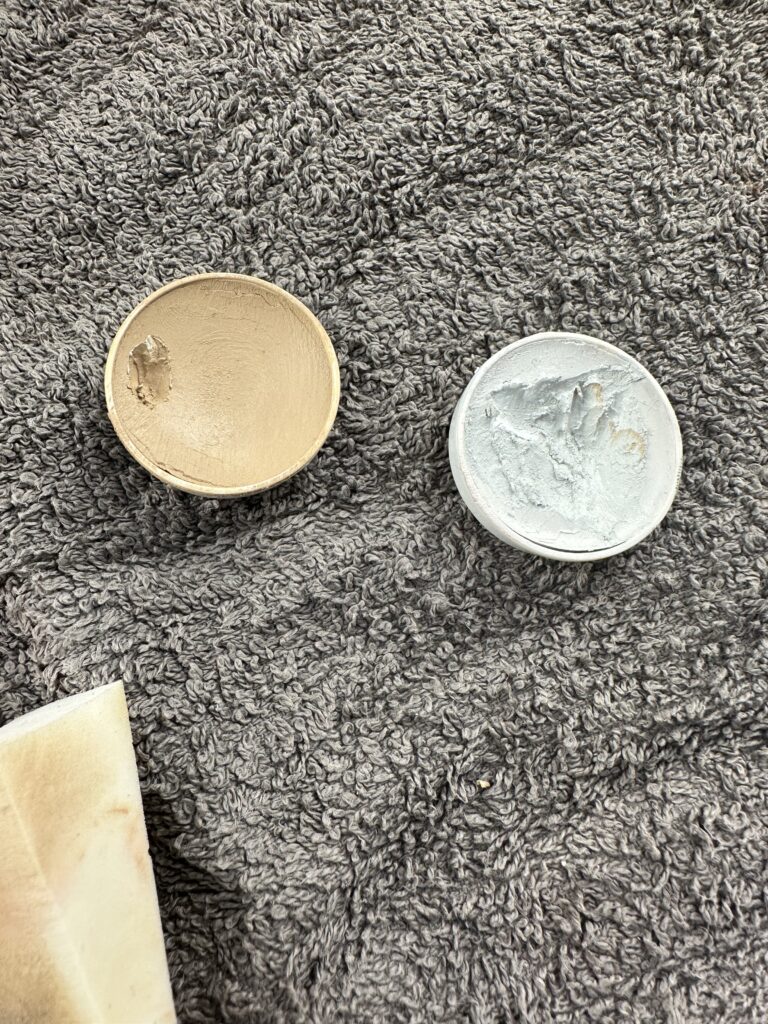

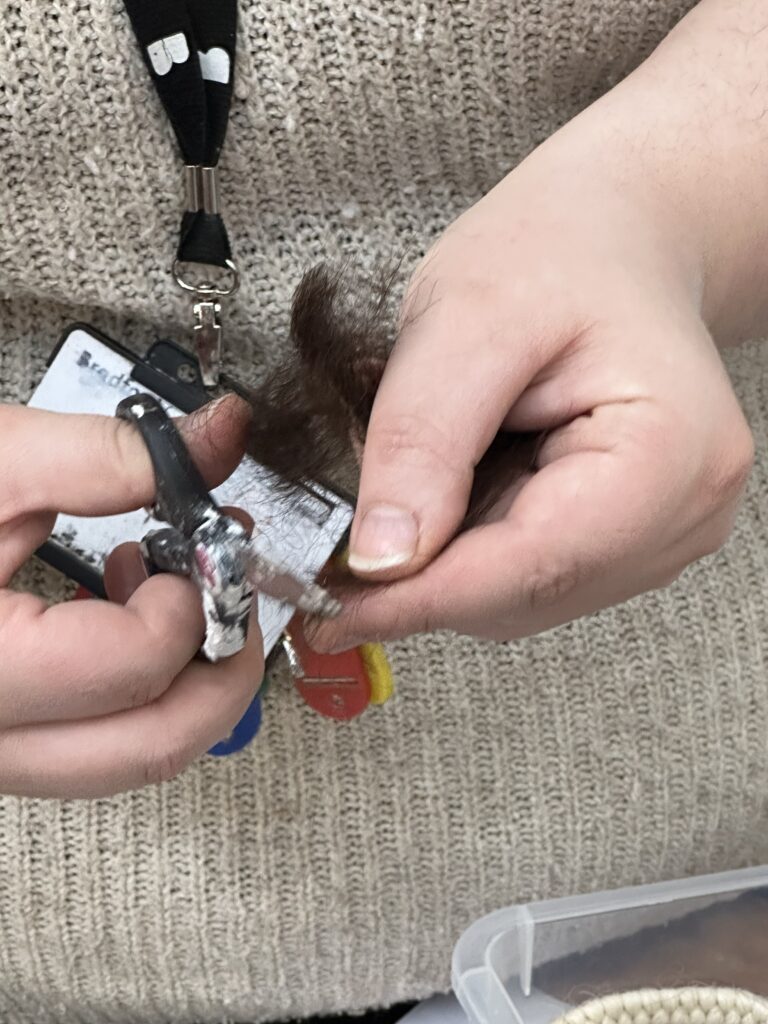

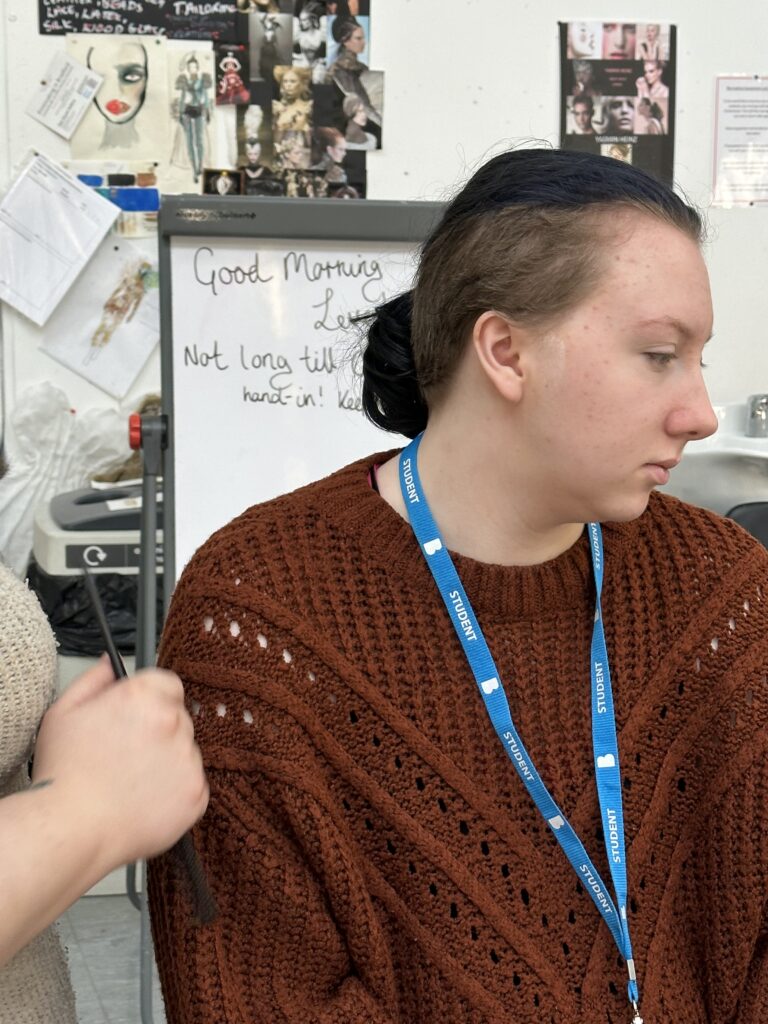
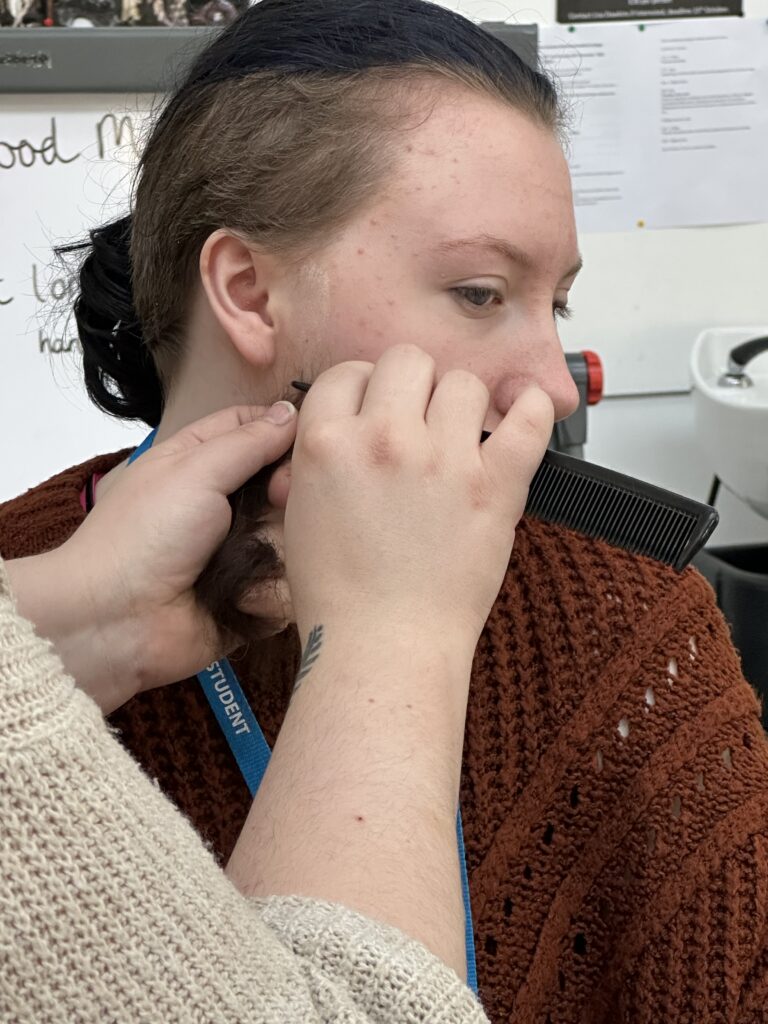
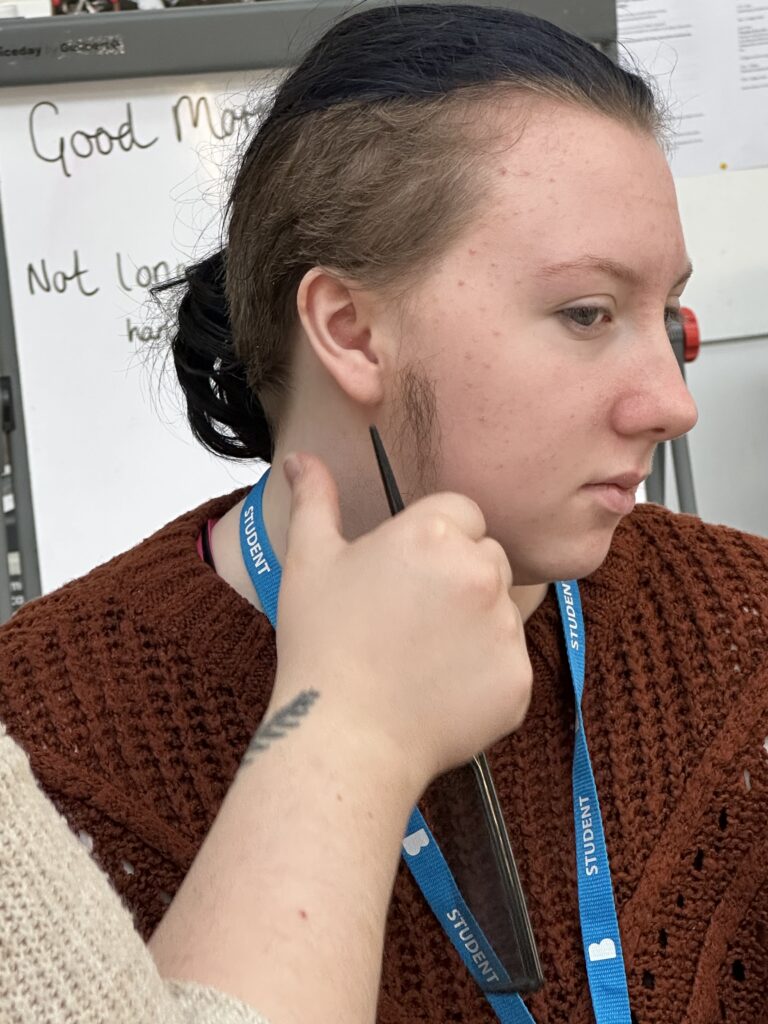
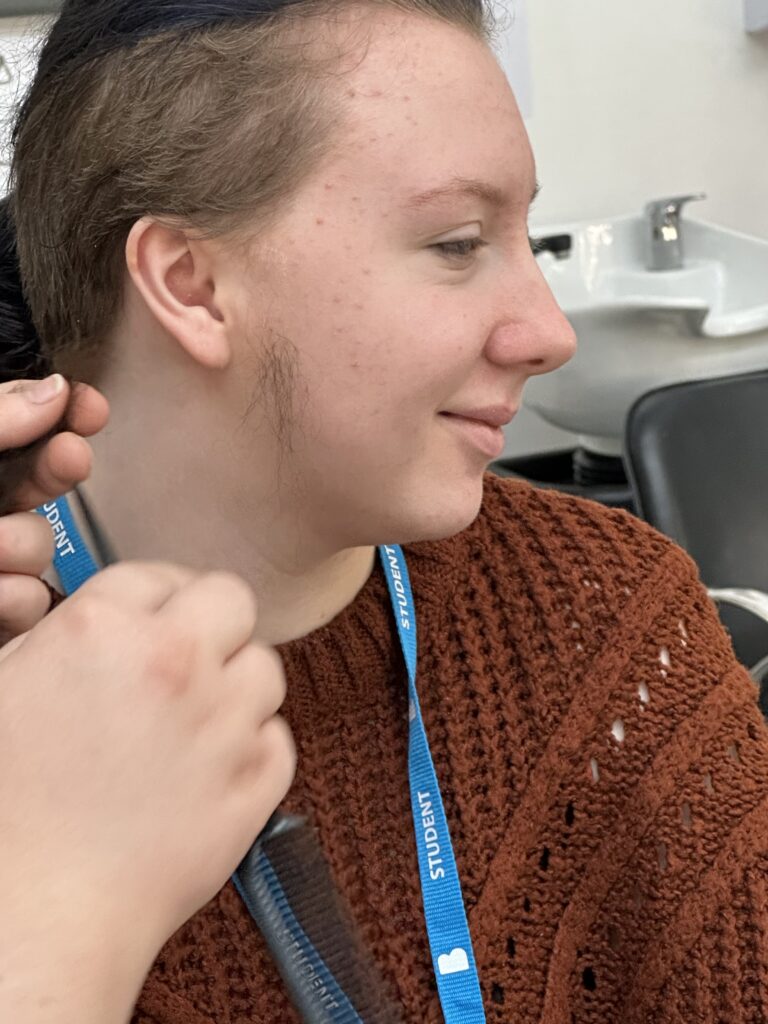

looked at how to apply Yak Hair to create side burns with Jasmin.

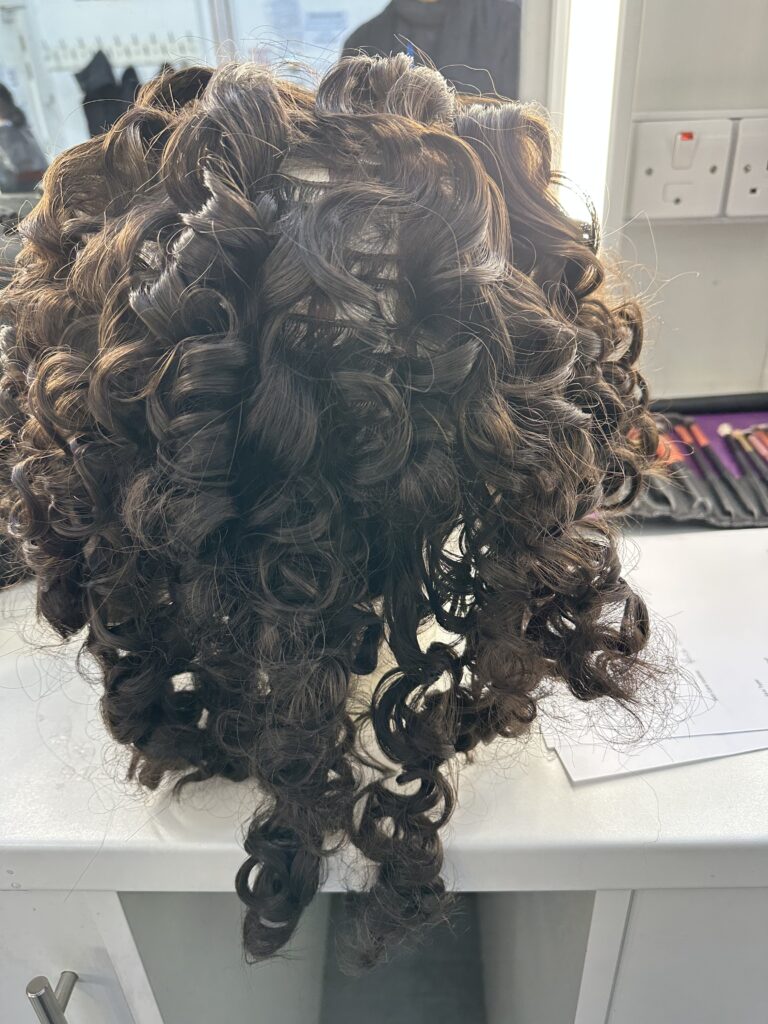
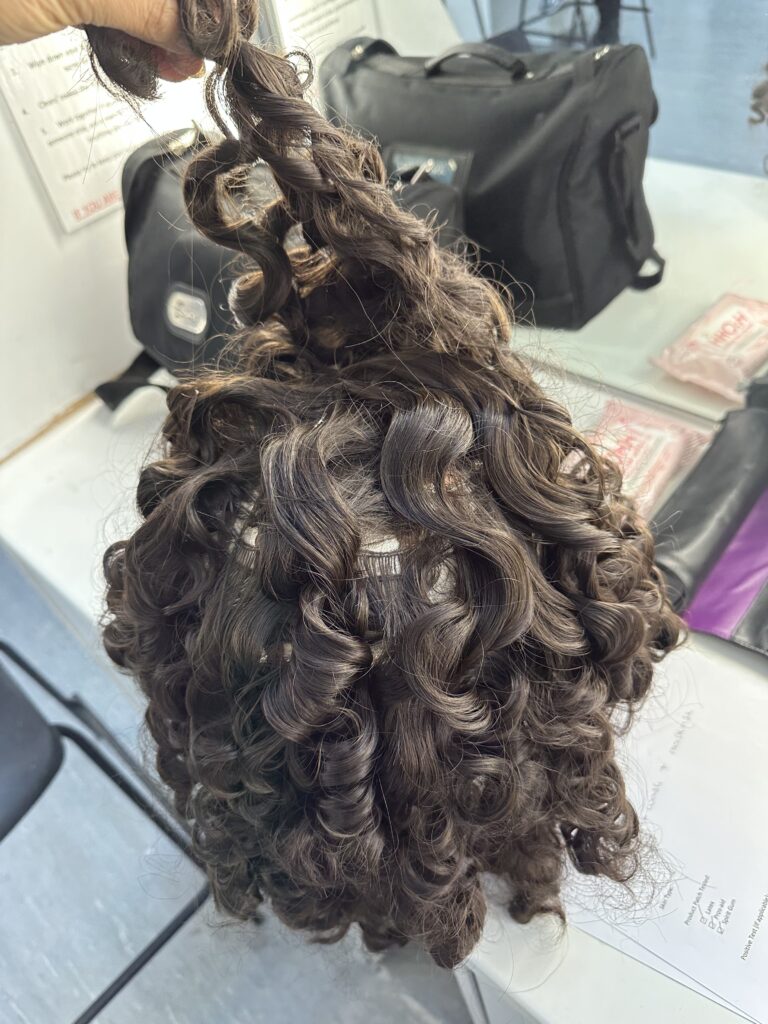


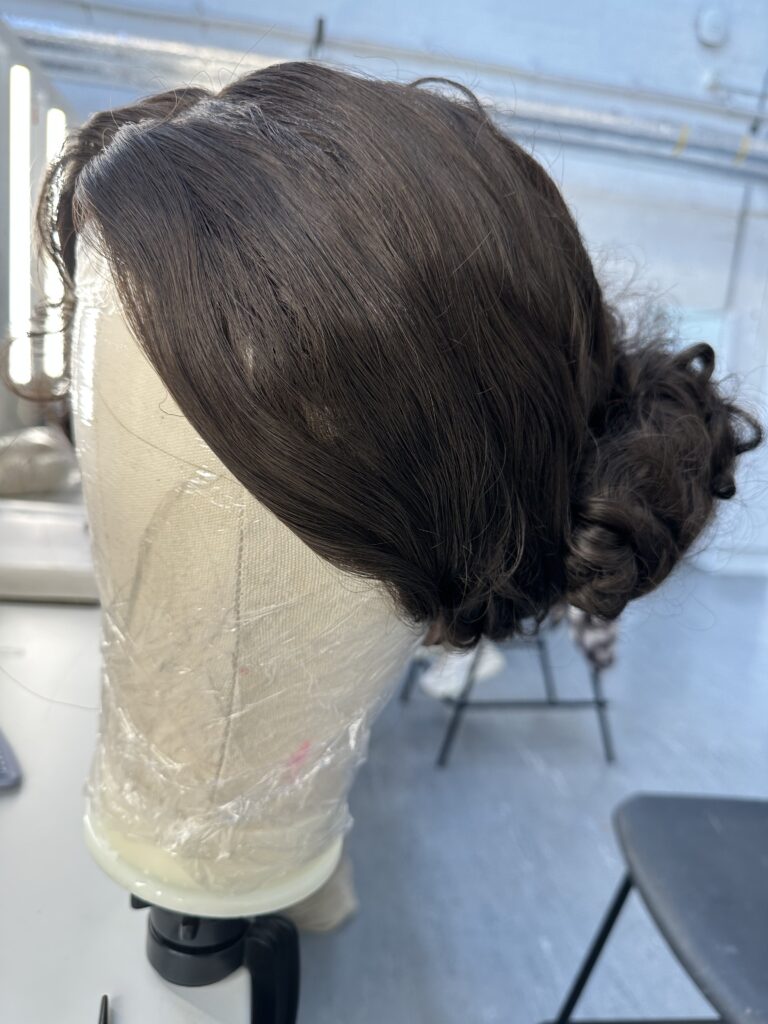

Opened up the bendy rollers that was left in the oven from last week and styled in few different hair updos.
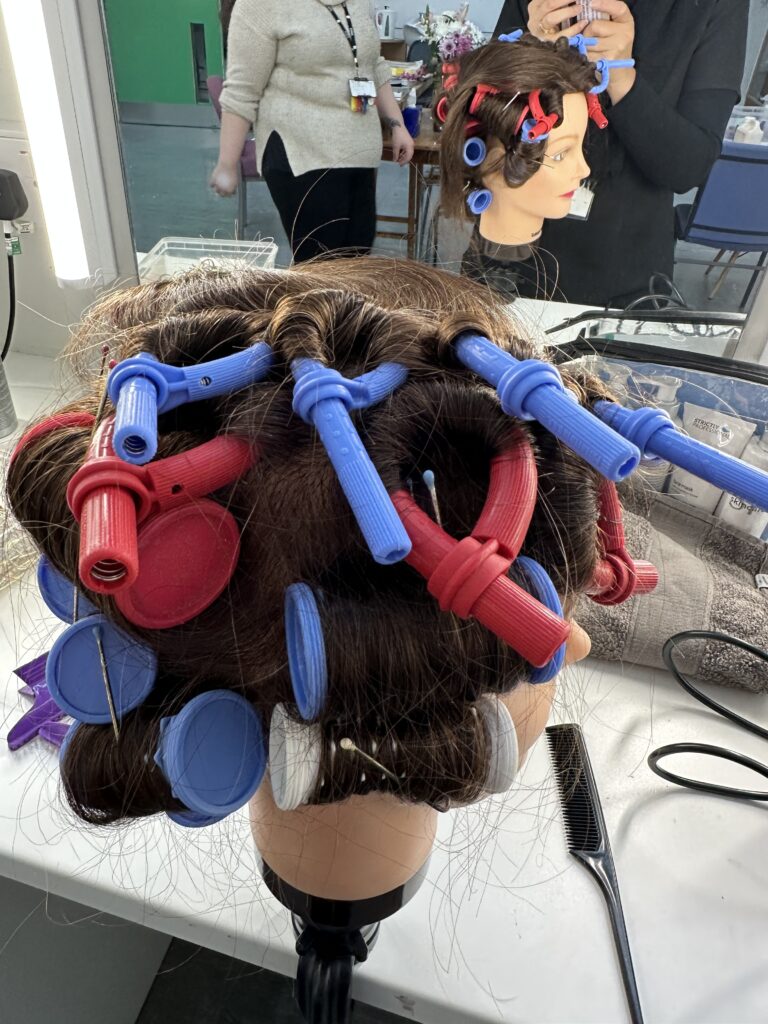
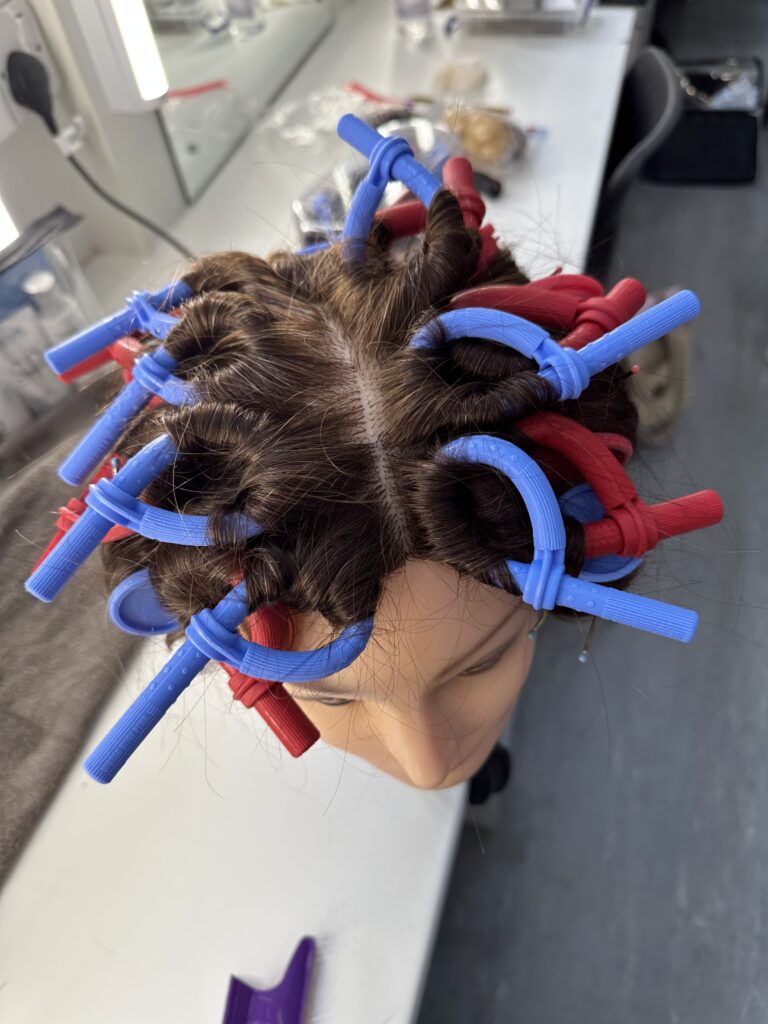
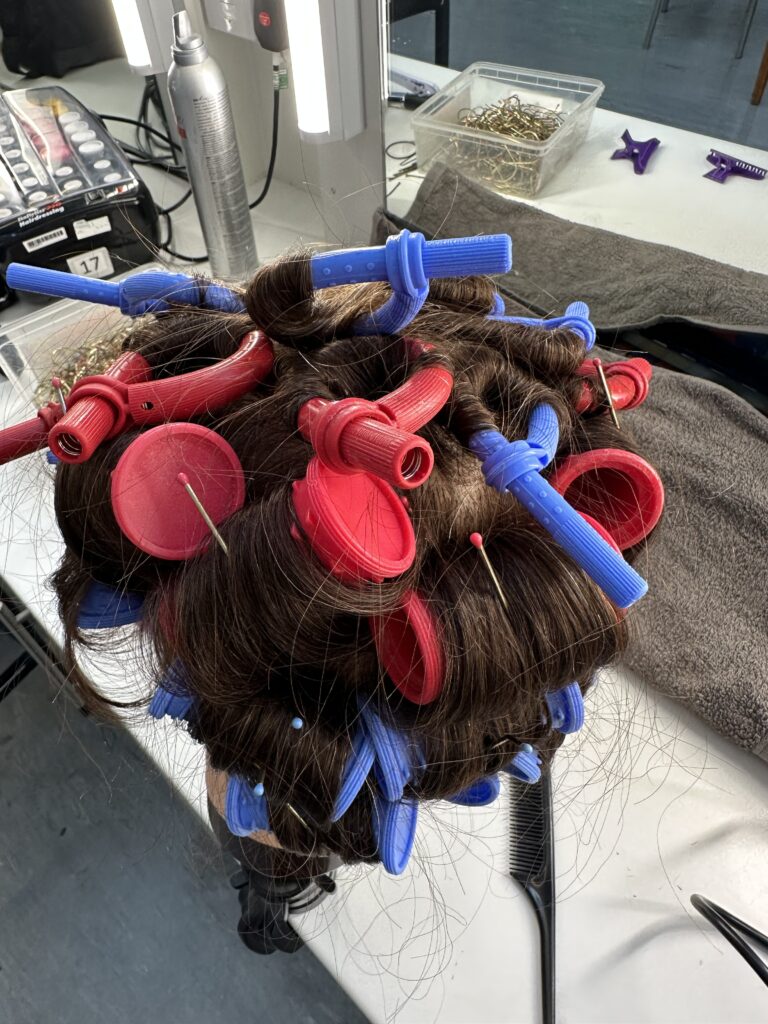
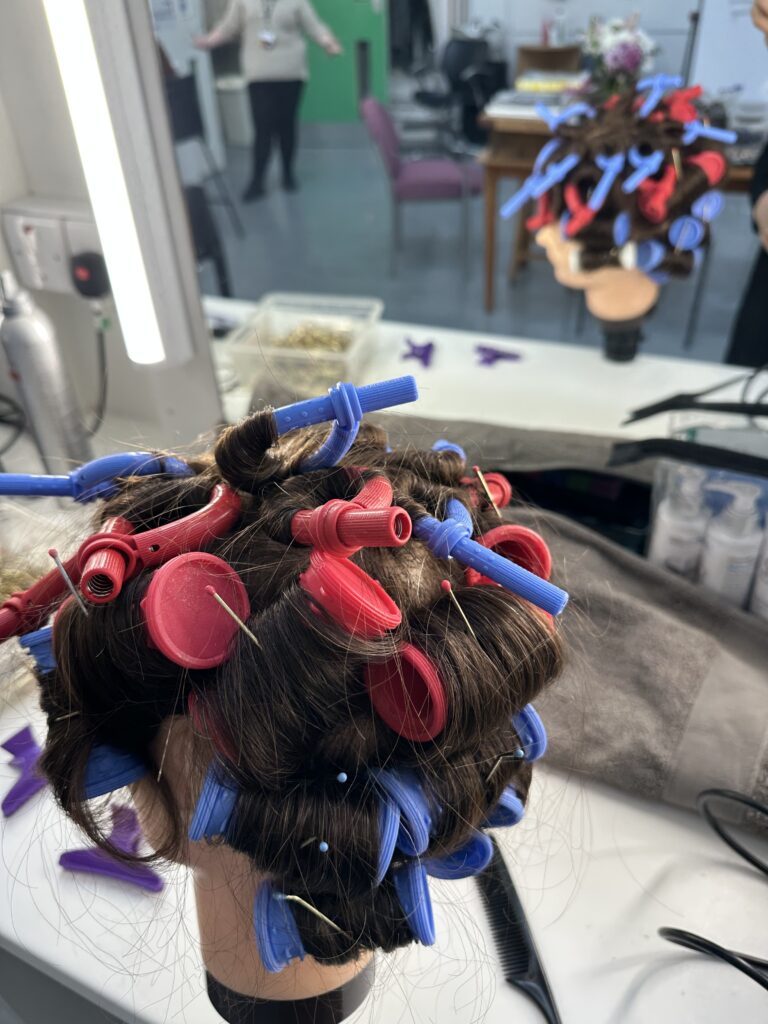
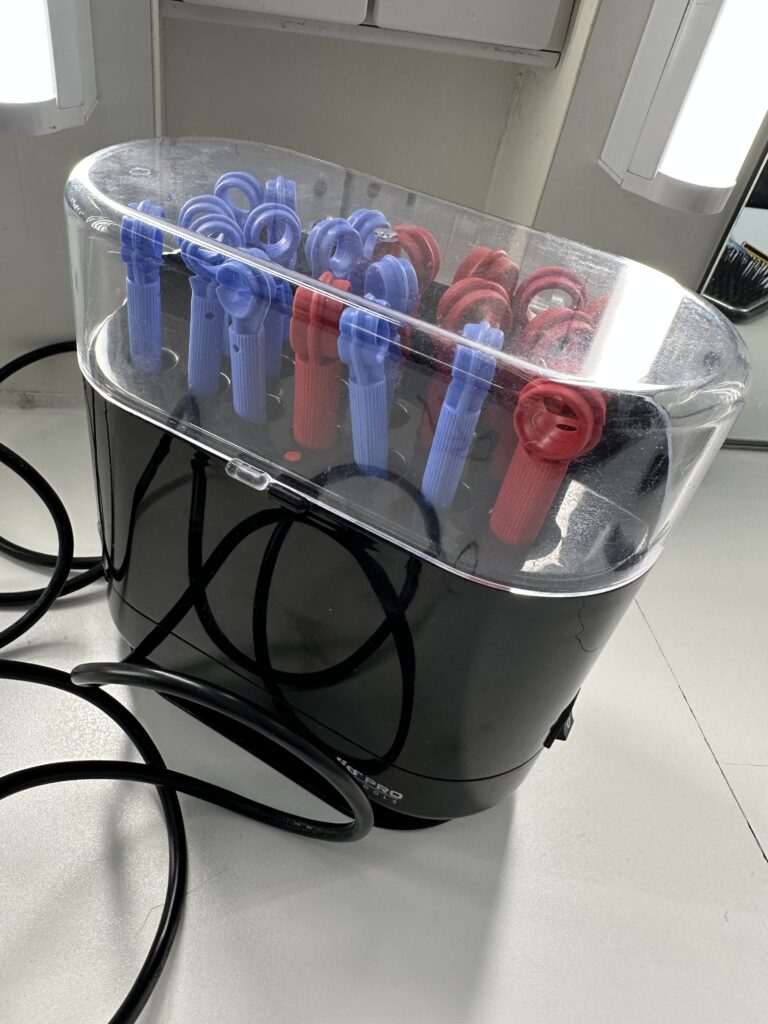

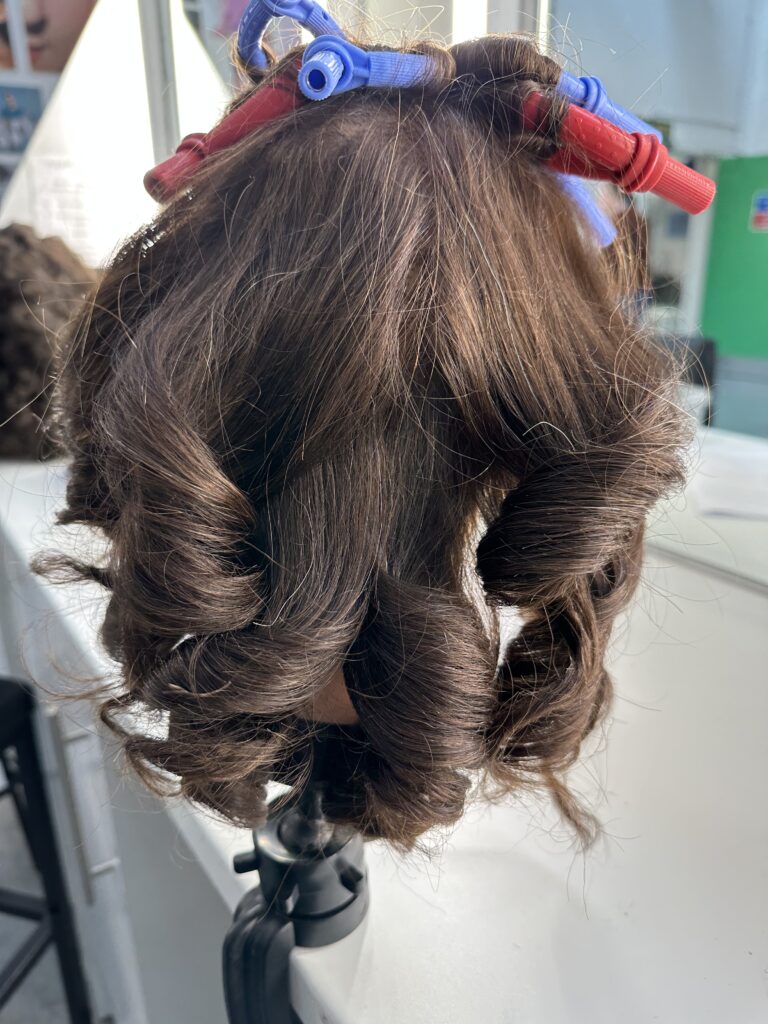


Tried to use different method to curl hair by applying hot rollers at the bottom and hot bendy rollers on top to see what sort of result I will get, to-be honest I prefer hot rollers or large bendy rollers as they create large and more defined curls, where as the hot bendy rollers create small tight but crunched up curls which I don’t think will meat the kind of curls I want to create for my looks.
carried on doing with practicing hair curling methods hot rollers, bendy hot rollers, tongs, and wound.
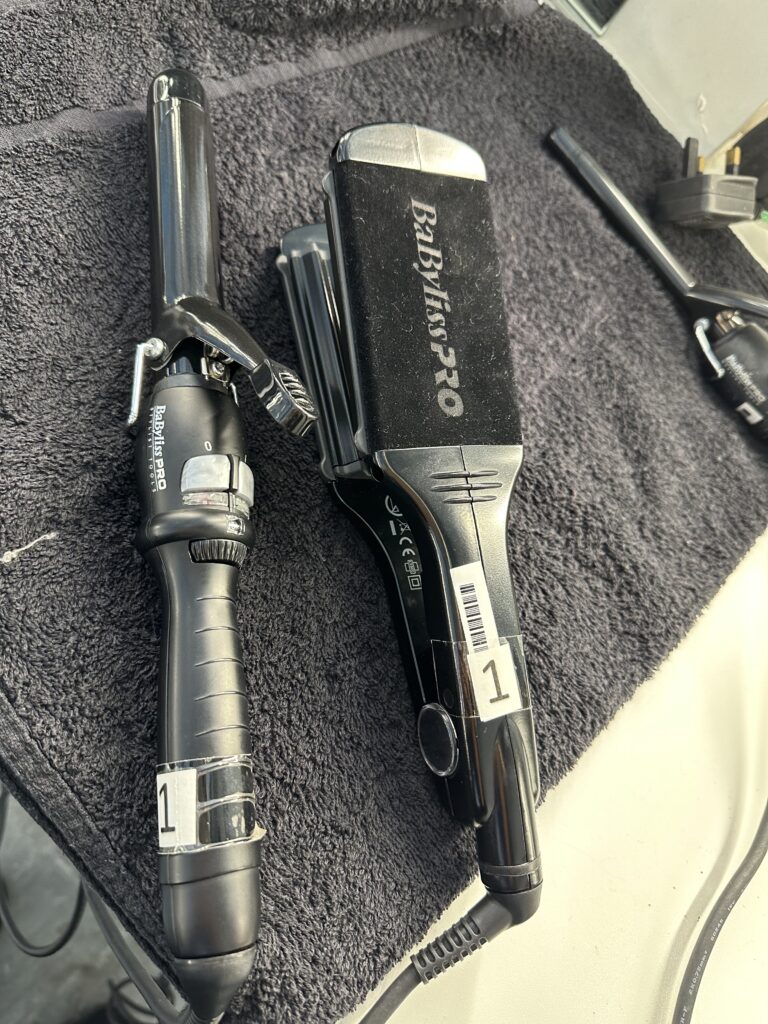
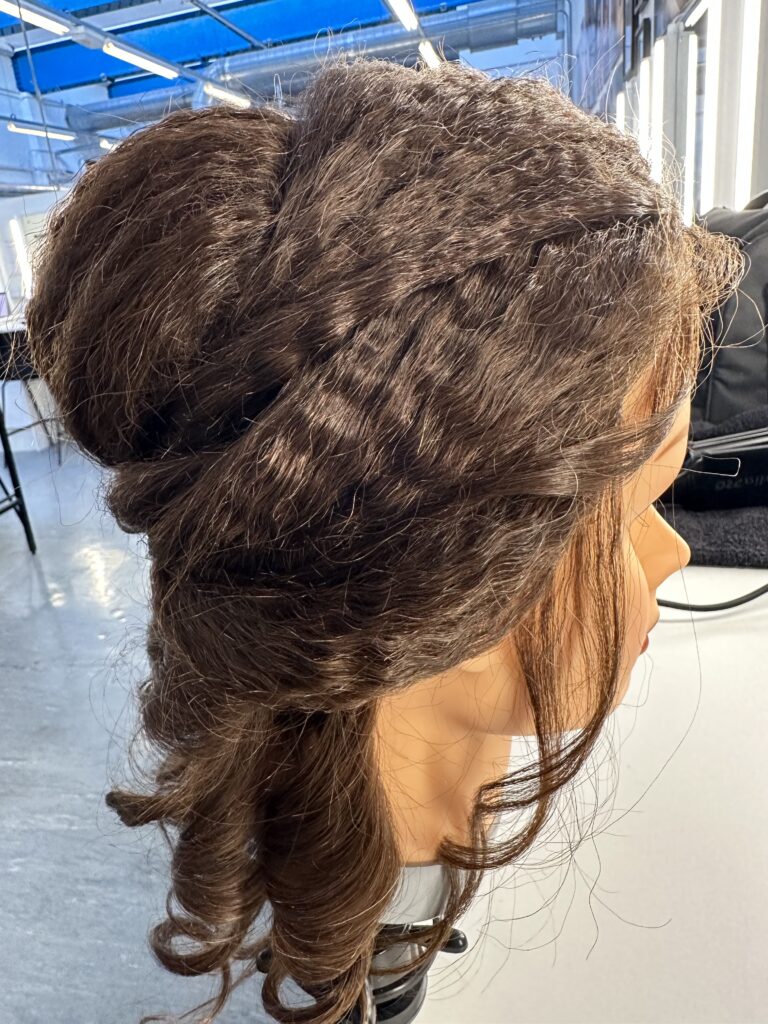
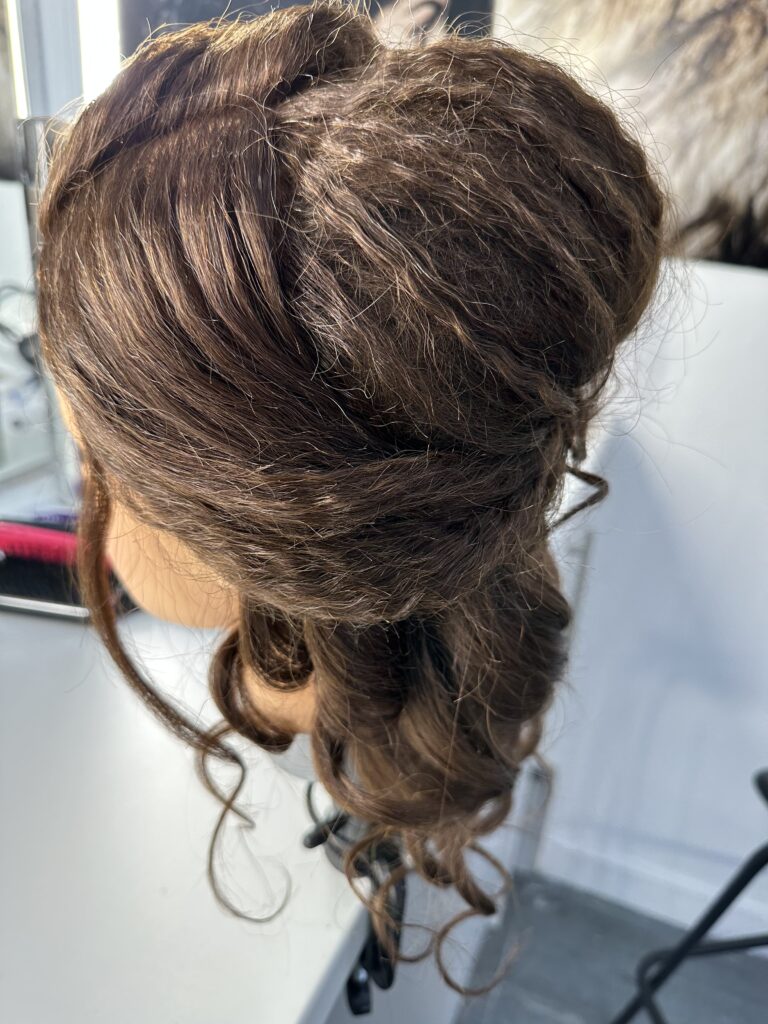
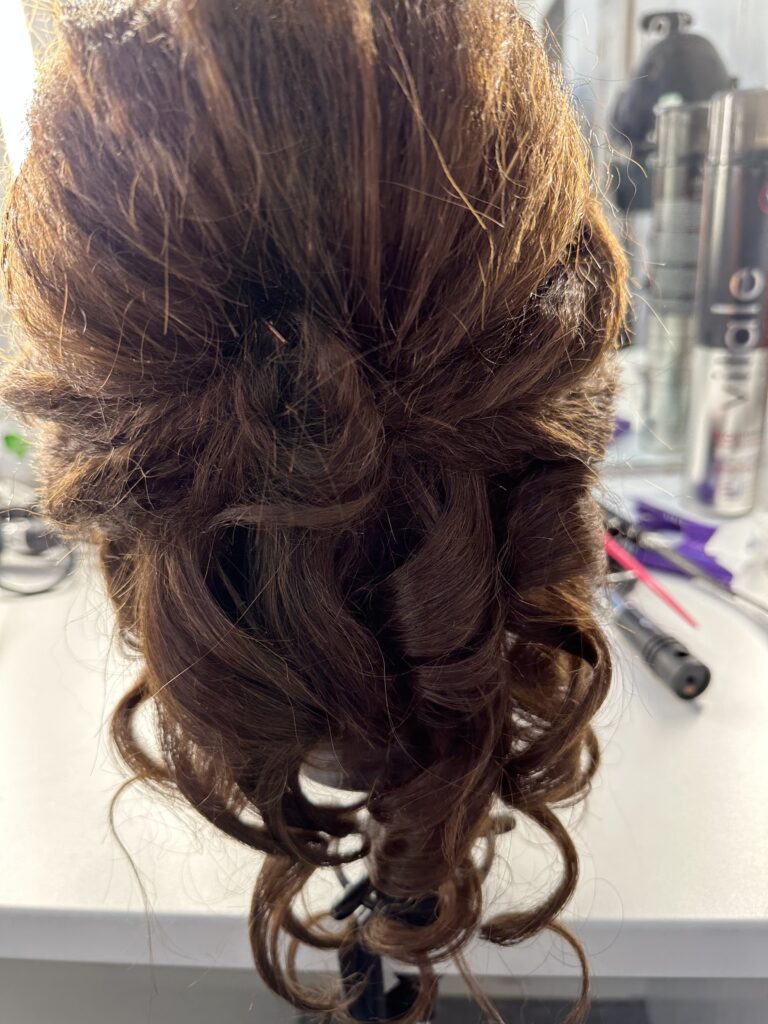
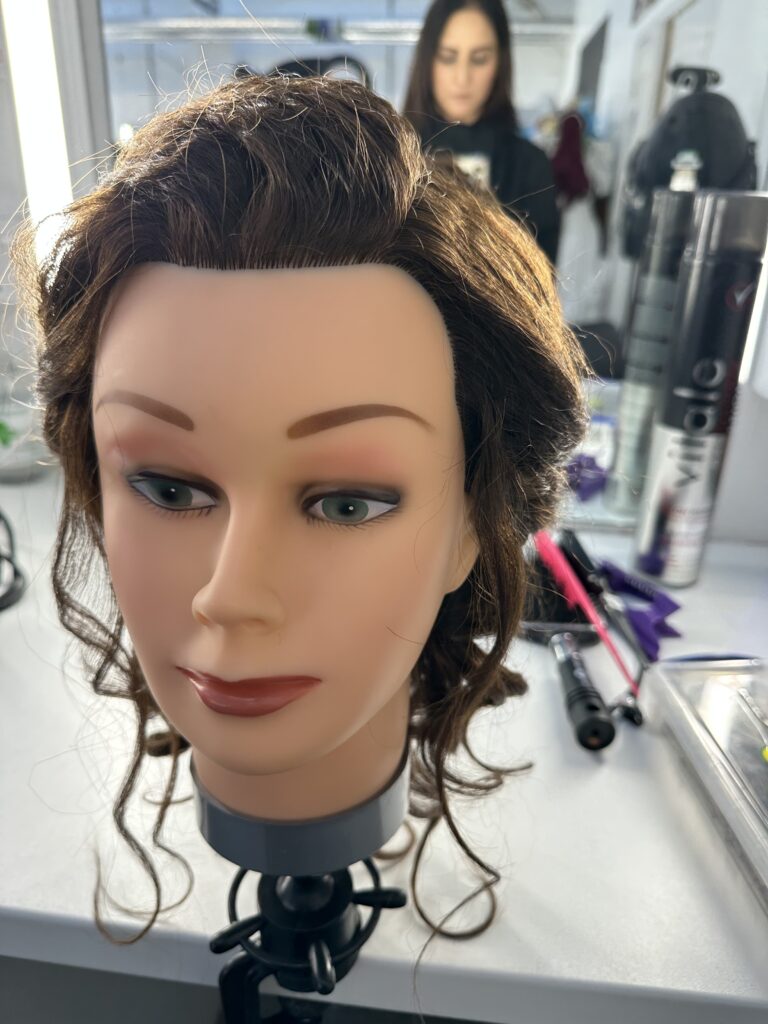
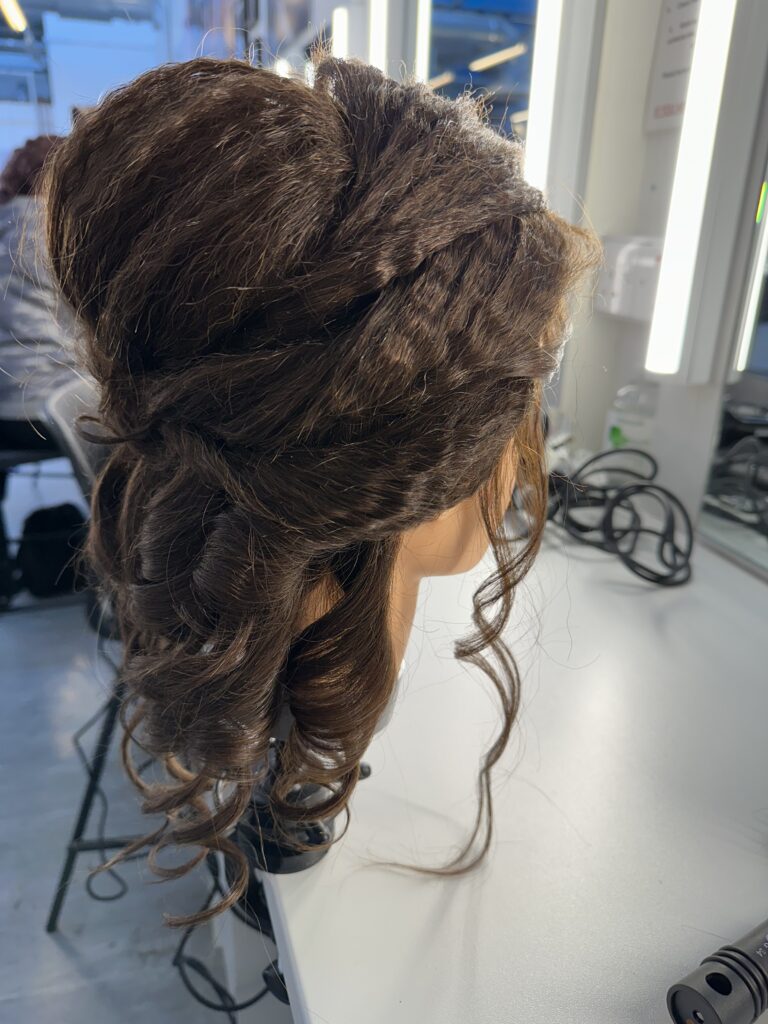
Crimped and curled hair with tongues and styled half up/half down.
Student- Feedback
Katie really like the crimped hair and the volume in middle top head style. She said she will try to style with crimping.
Project-2 Budget
Makeup
Pro eyeshadow palette £21.99
Kryalon foundation stick £14.99
Contour palette £5.99
Makeup Brushes £31.99
Eye liners white + black £11.99
Gel eye liner £3.49
Eye lashes £5.99
Loose face powder £3.99
Mascara £8.99
Blush £5.99
Total—————– £112.89
Hair
Curling Tongues £30.00
Hair Setting Spray £9.99
Heat protection spray £3.99
Hair Mousse £4.49
Hair clips £2.49
Hai grip pins £8.99
Hair bun filler £2.99
Total————-——— £61.44
Total ———-——£174.33
Tutor Feedback for project-1
Today I received the feedback on project 1, from tutor Lucia. It was a big surprise for me when she told me I got Distinction for deep research and presentation of portfolio. It was even bigger amazement when she said that my portfolio is one of the few best organized with detailed research, and my work will be used for example reference to the students! Luci has praised my work with highly positive feedback. I was very confused and felt out of place when started project 1- it was overwhelming to sign in to so many different apps and use scrap book to build portfolio and upload on digital space, it was like I’ll never get anywhere as I’m not a technology person. Afterwards I realised that I can actually upload everything direct to digital space. It took long time to figure out how to build pages and save work. Sara kept saying it’s looking all good, you are on the right track, but I still wanted some 1 to 1 feedback on my work, so I know I’m doing the right stuff. Thank you so much Luci for such positive feedback, this has really boosted my confidence and I hope I will carry on making you give positive feedback every time in future. Luci has also given me advice to keep practicing on hair, always bring hair in the makeup look, and use professional photographer in studio with lights for pictures for the portfolio